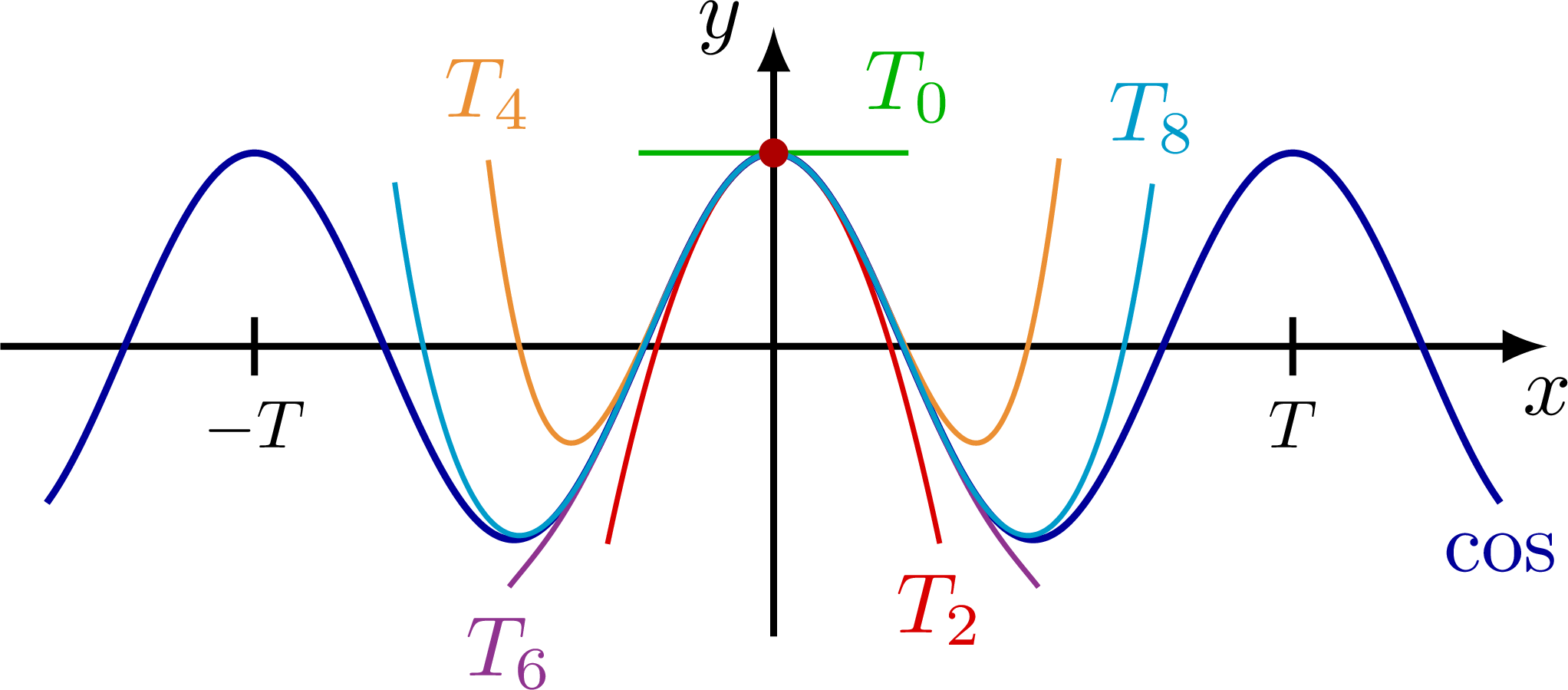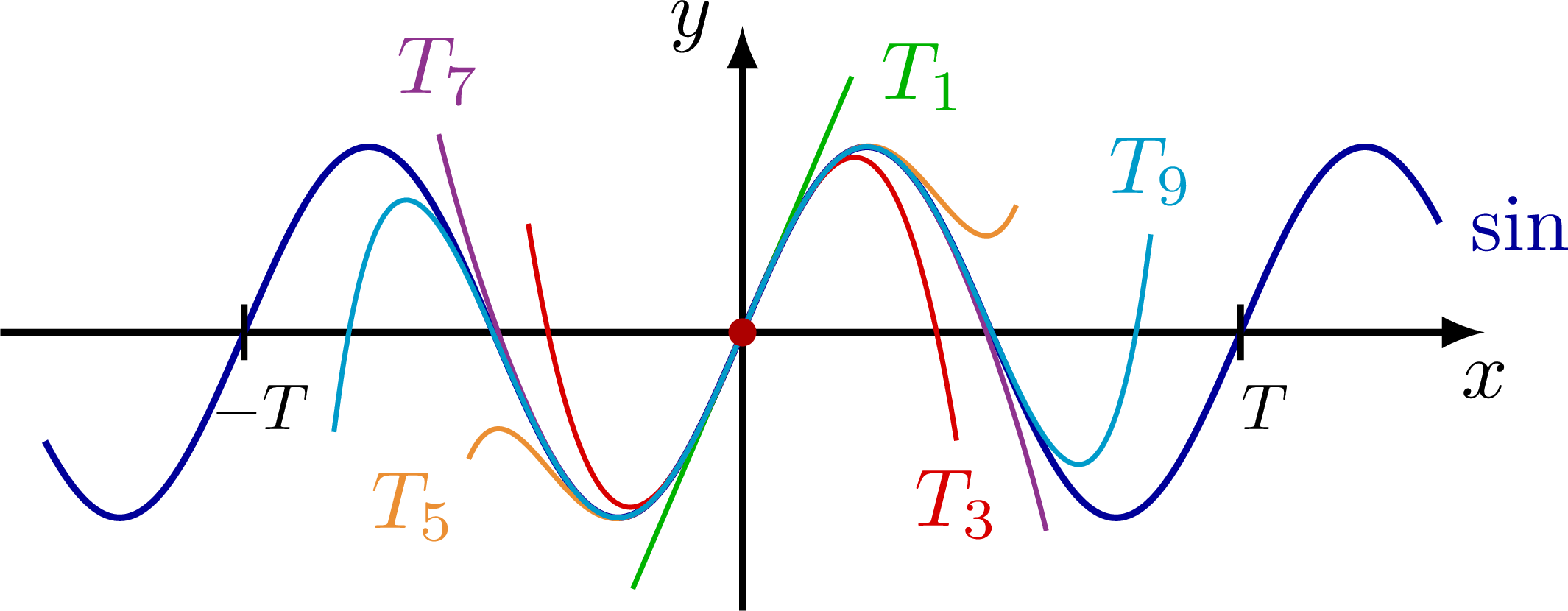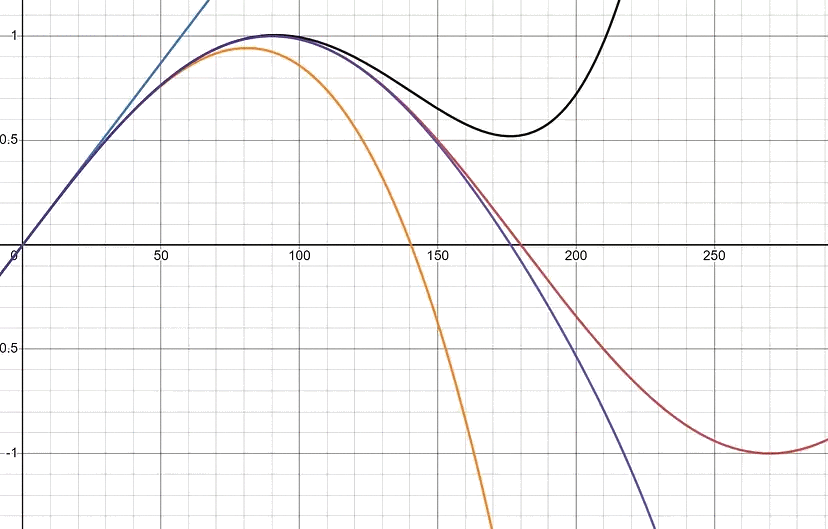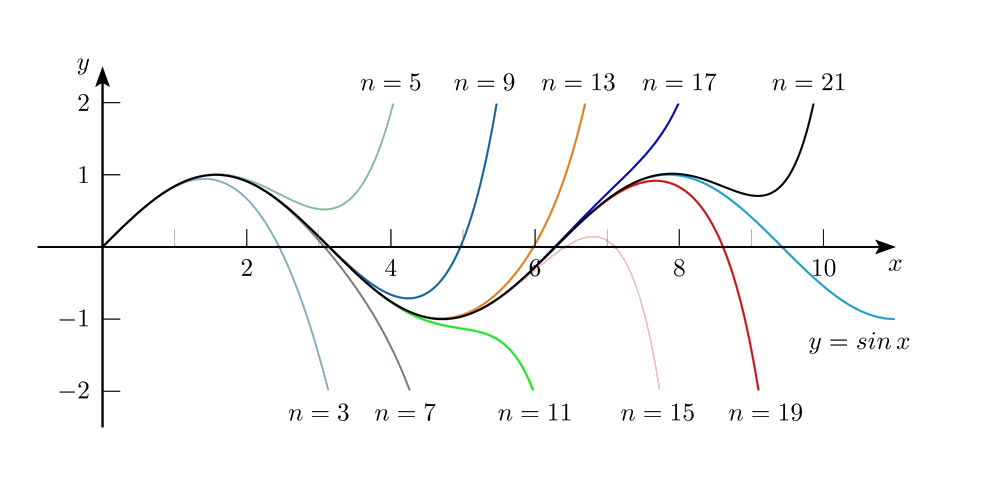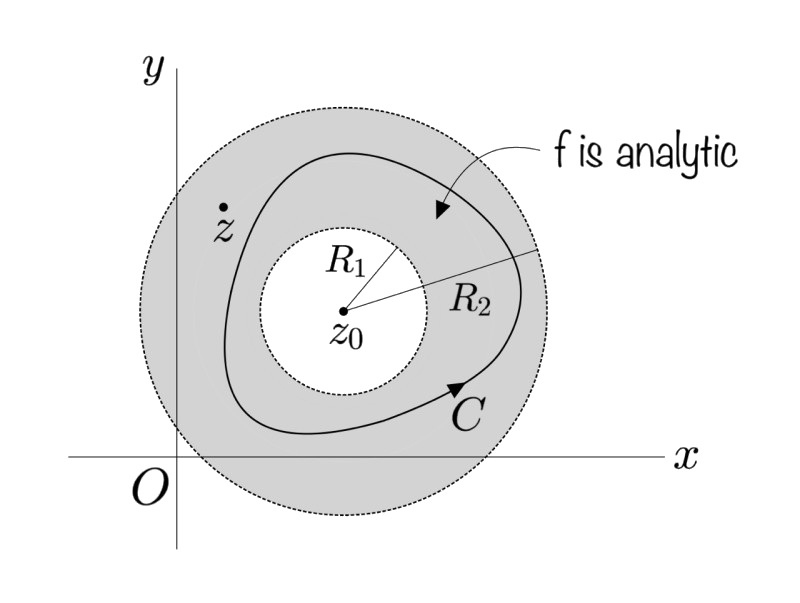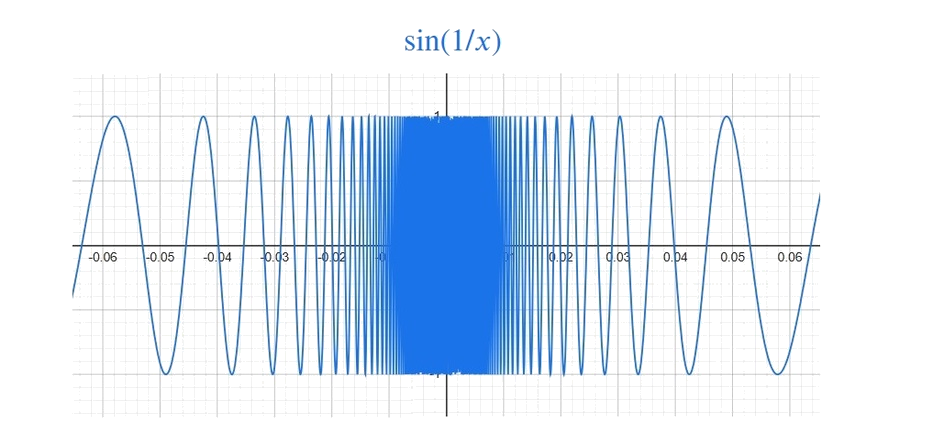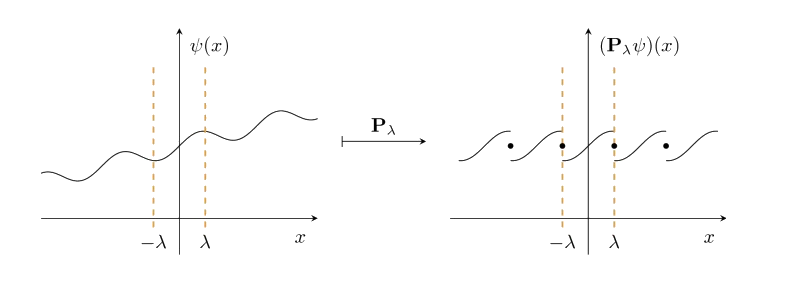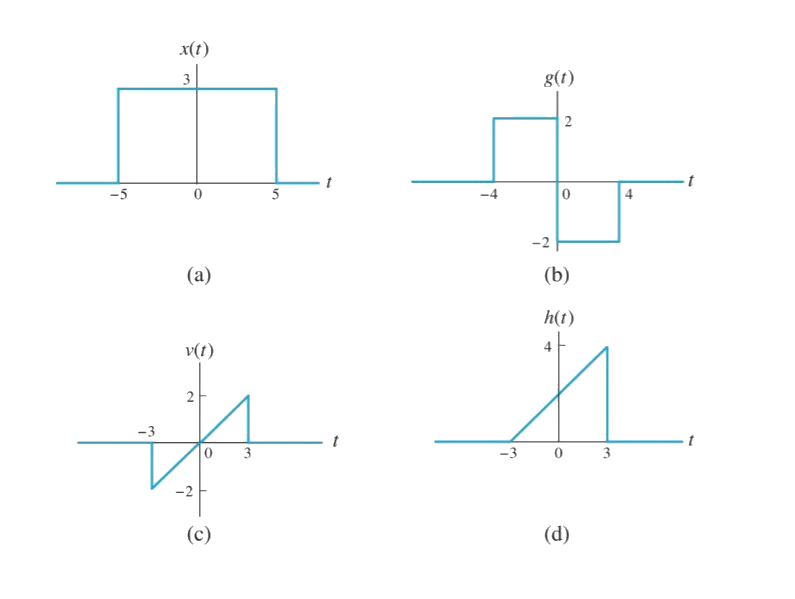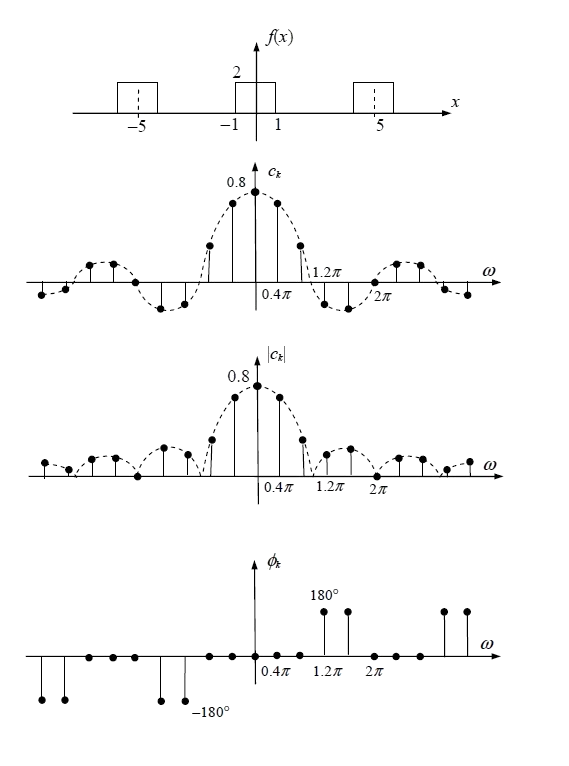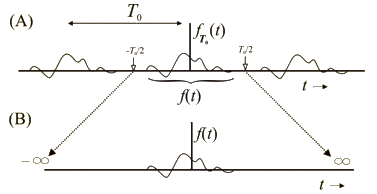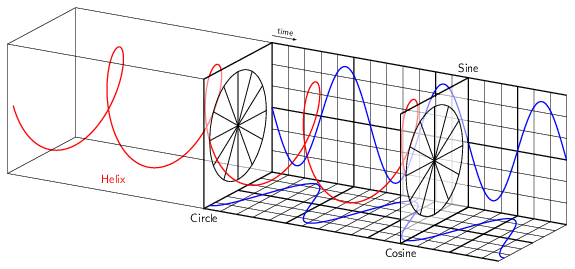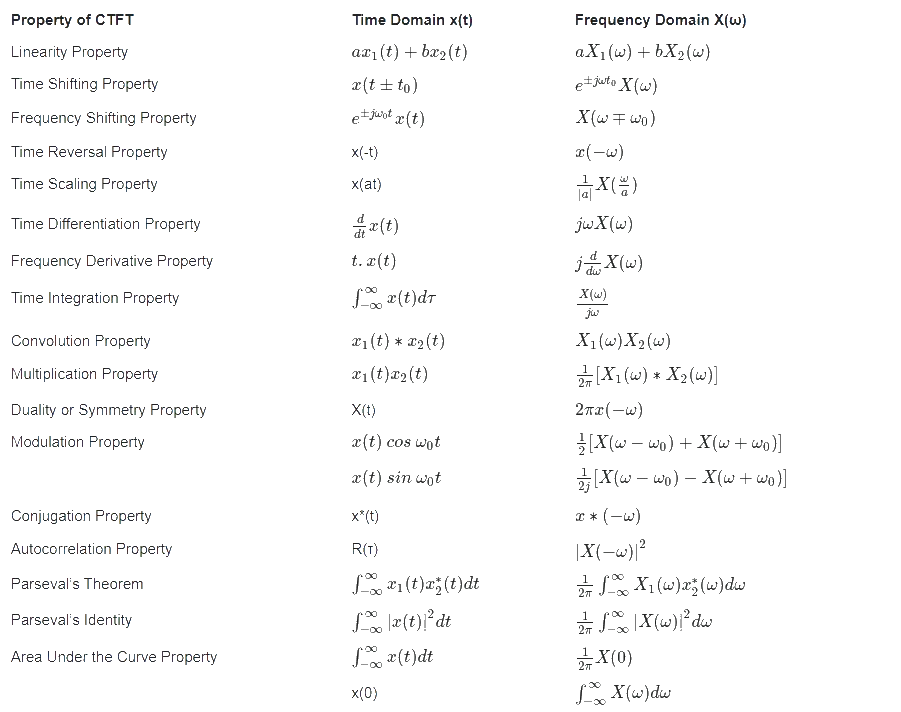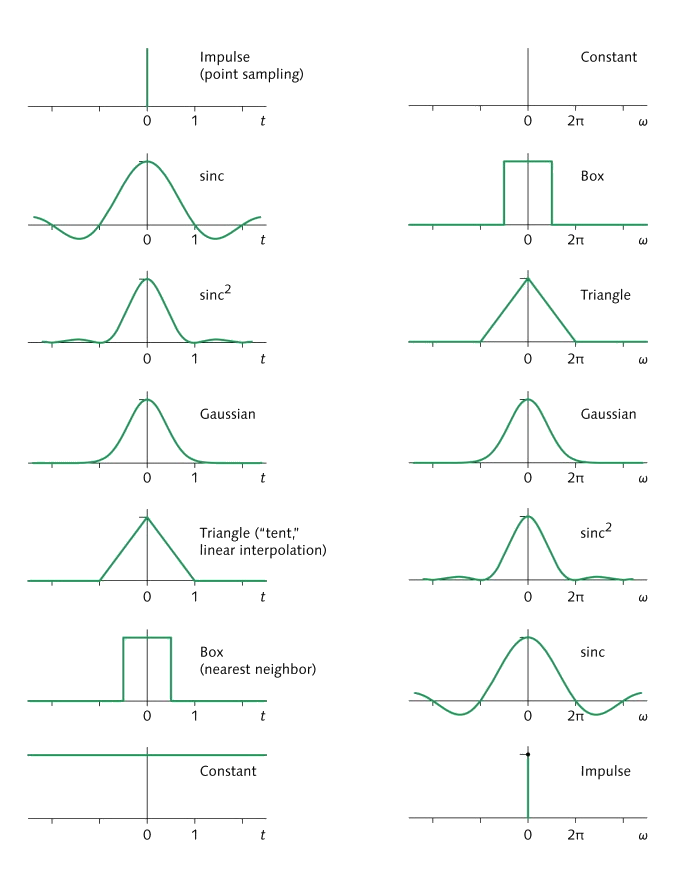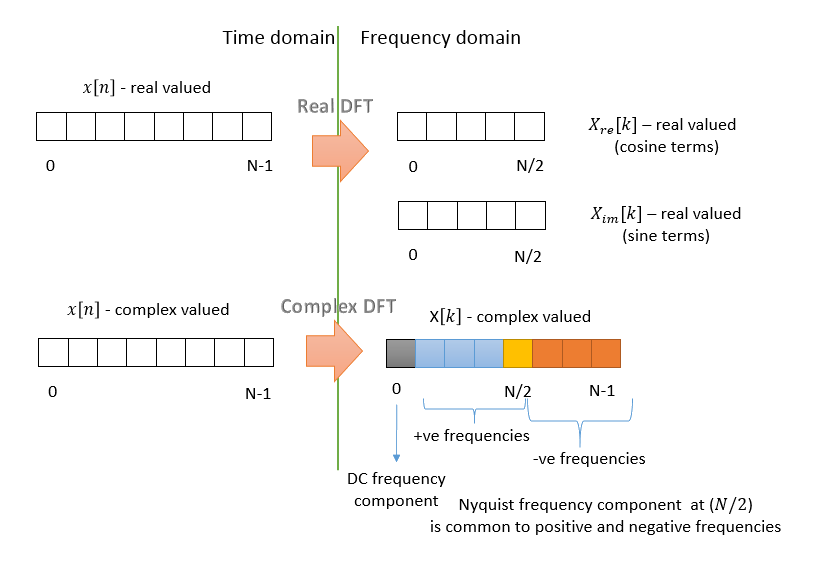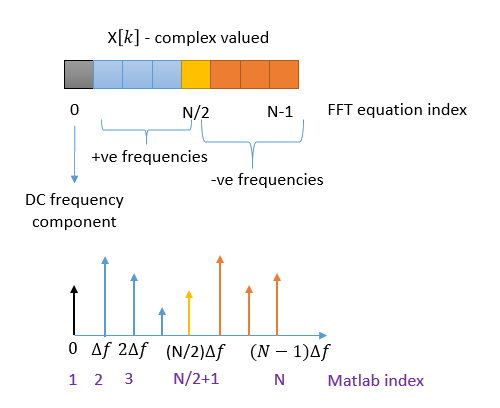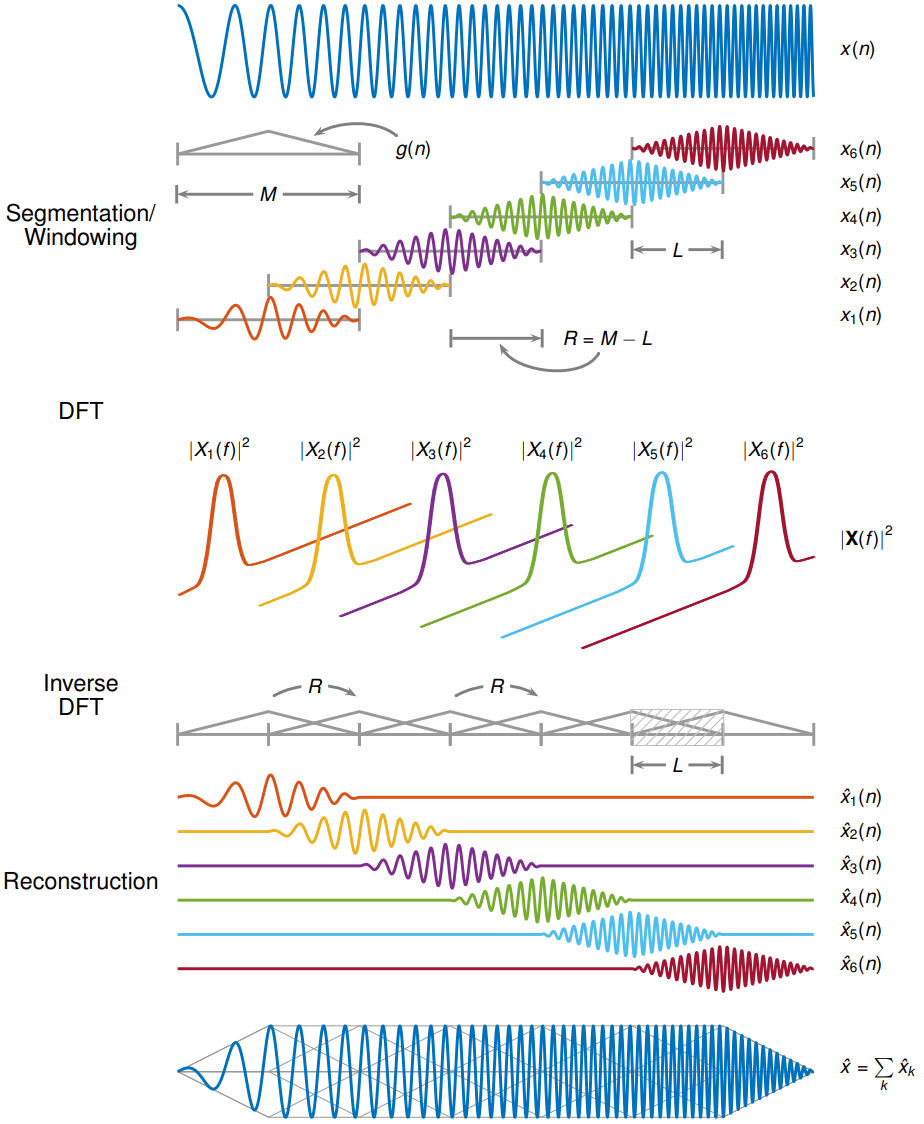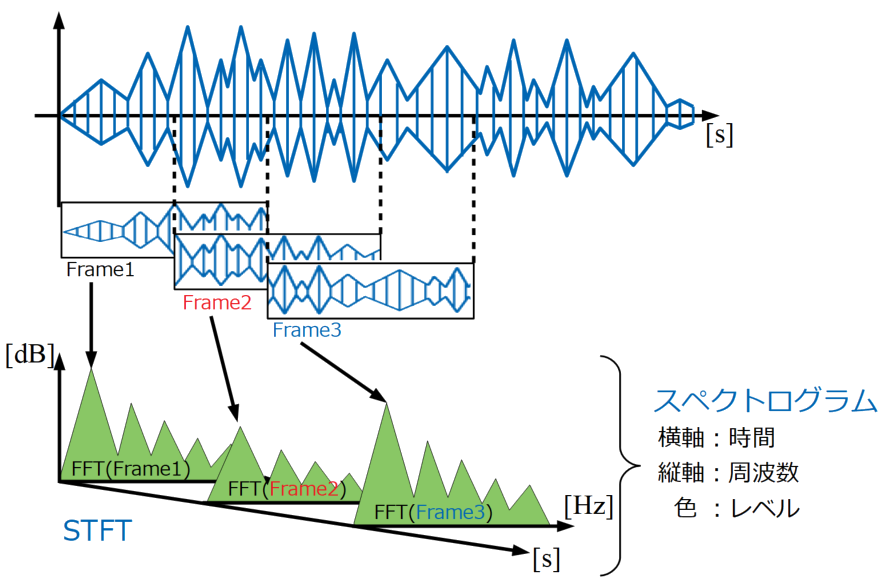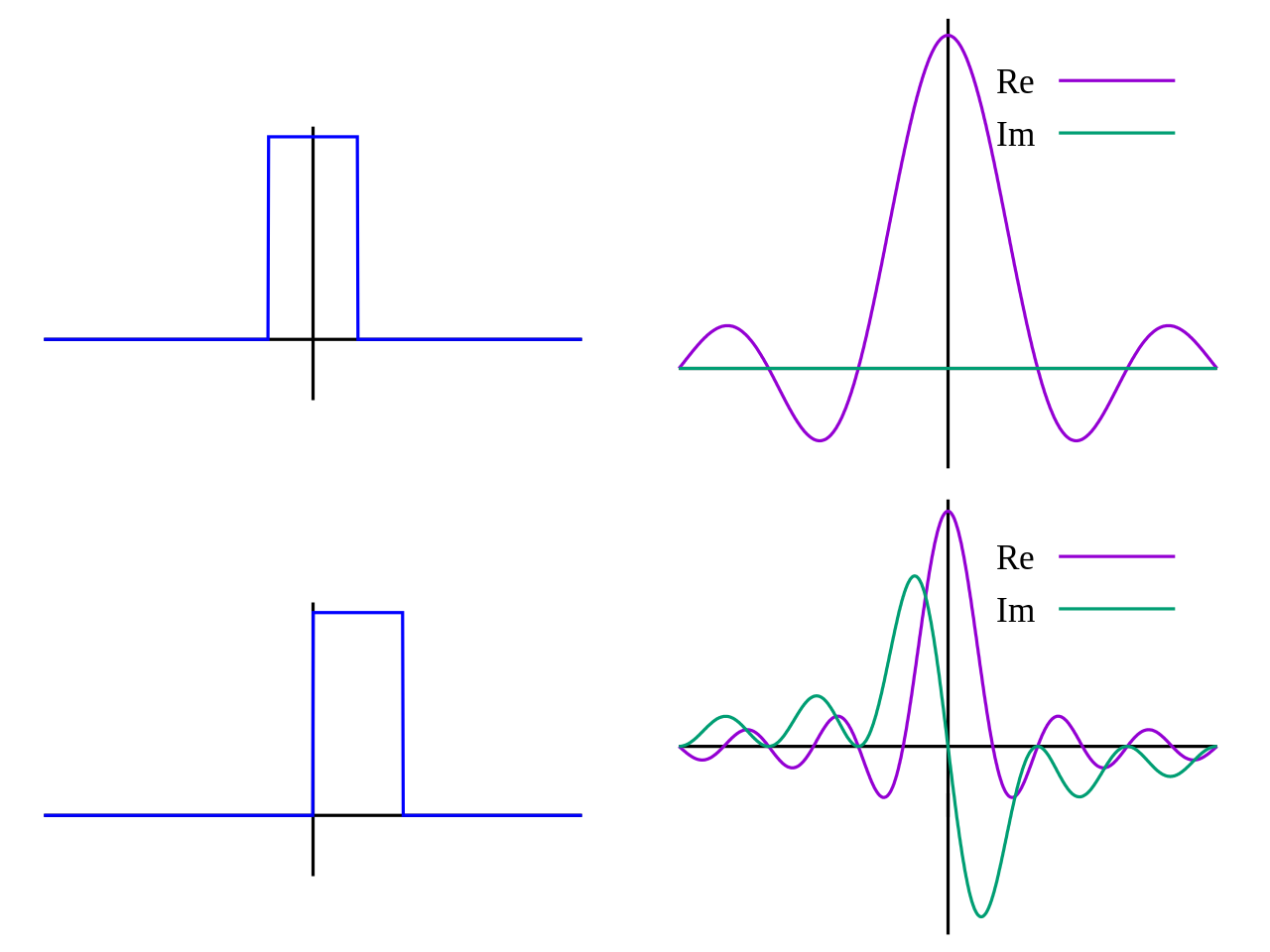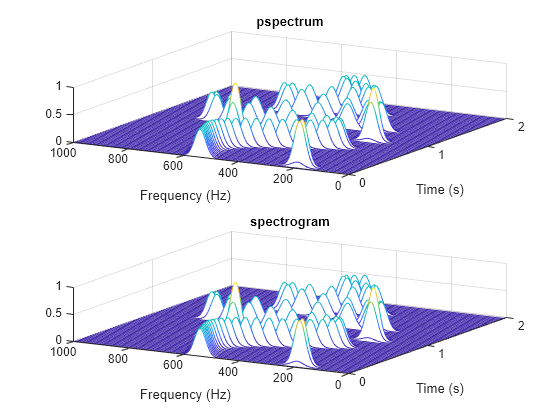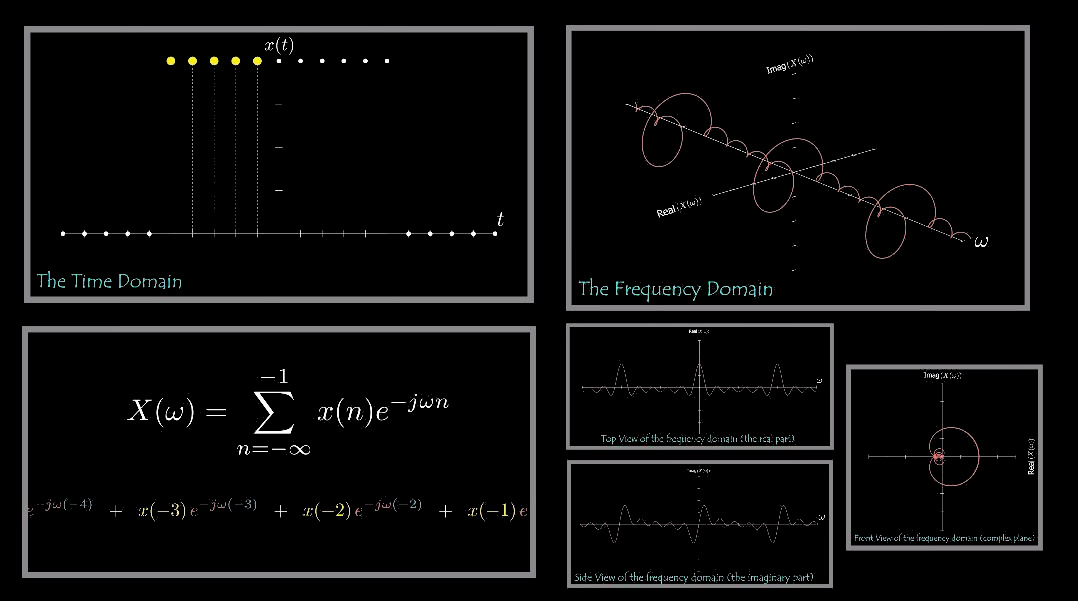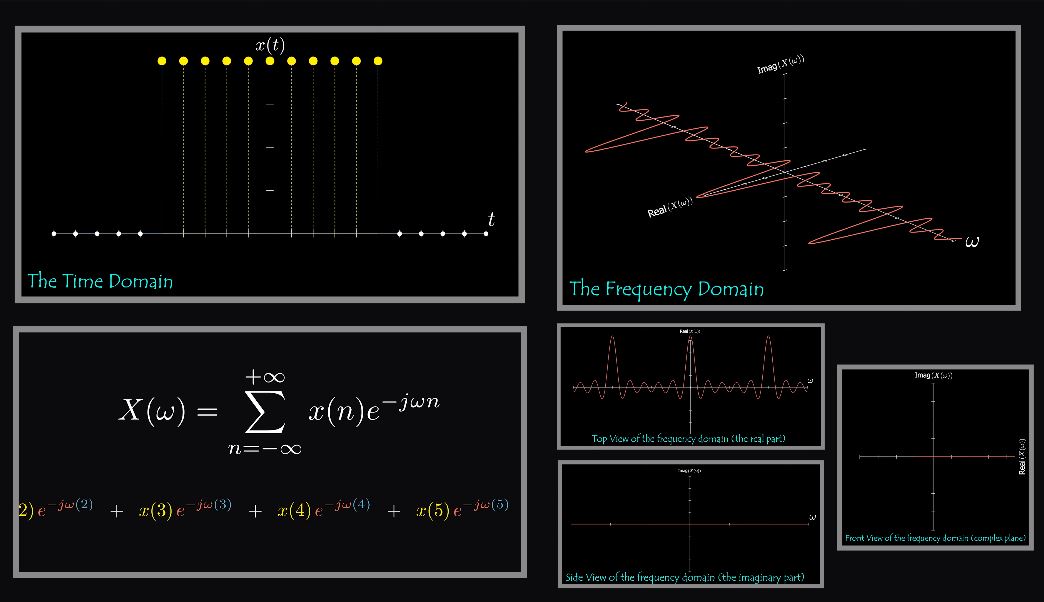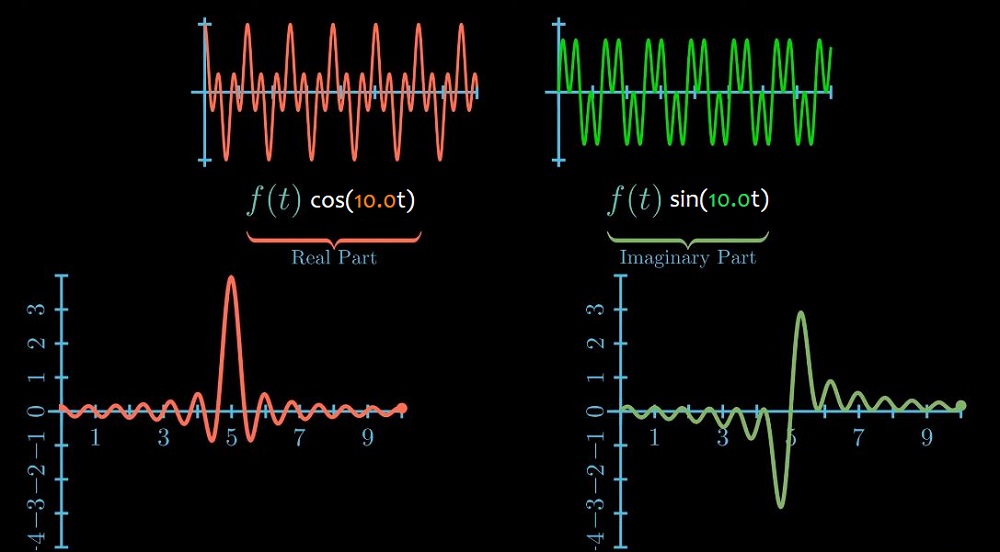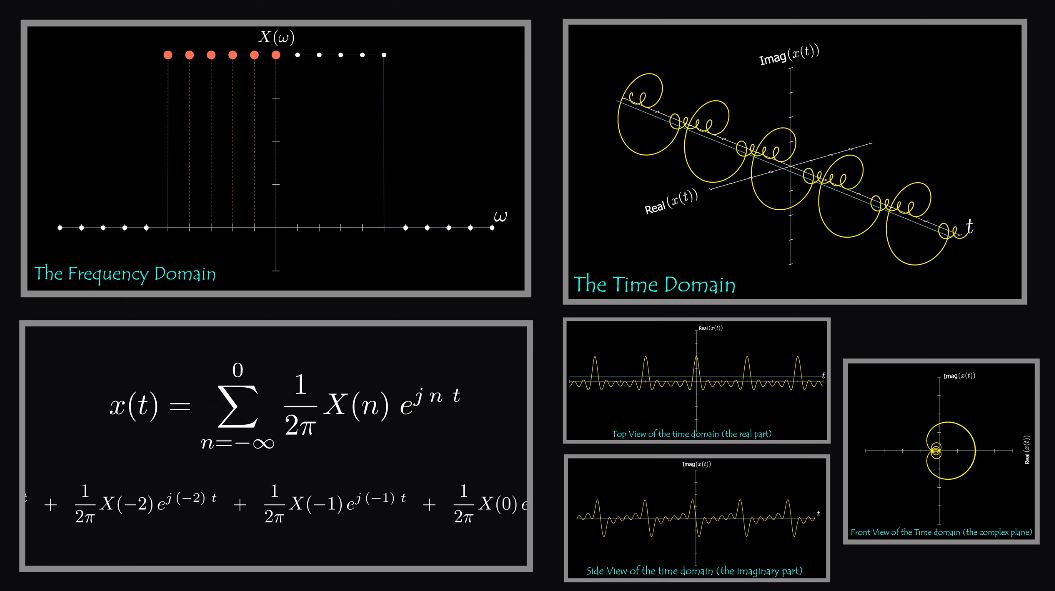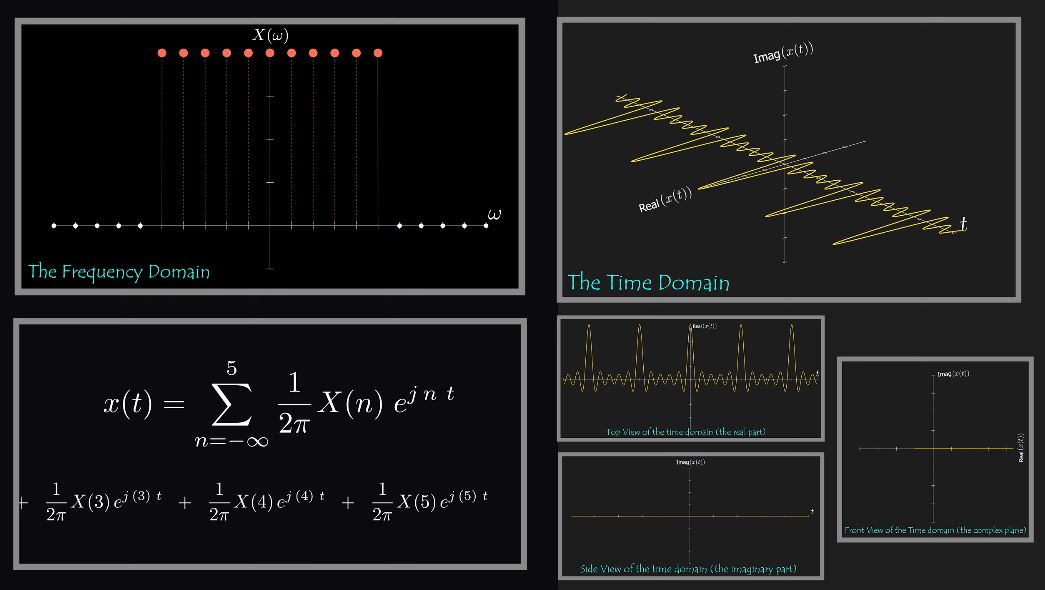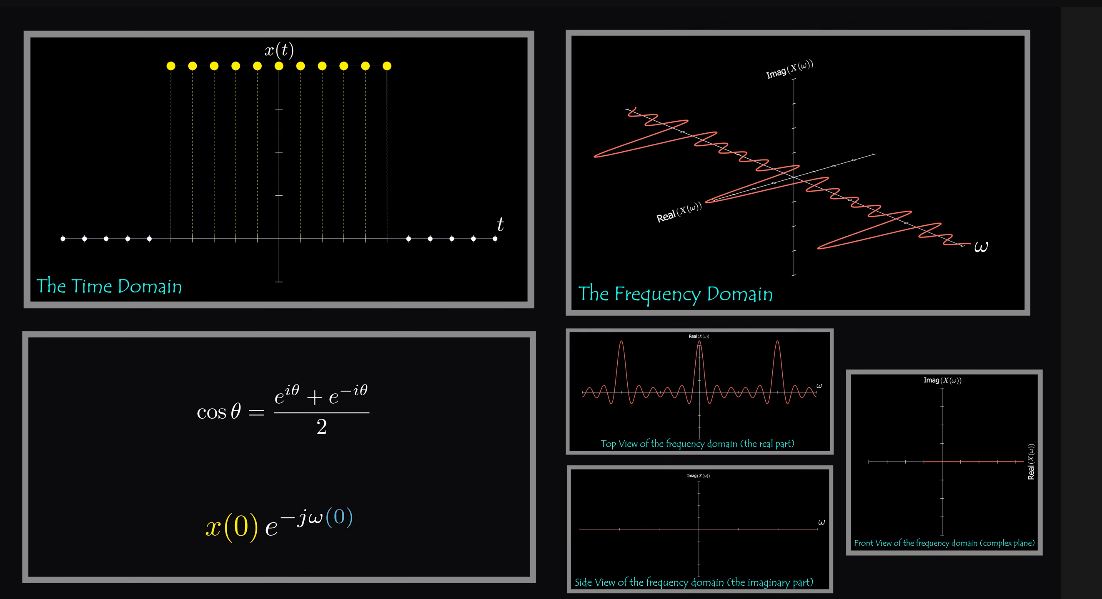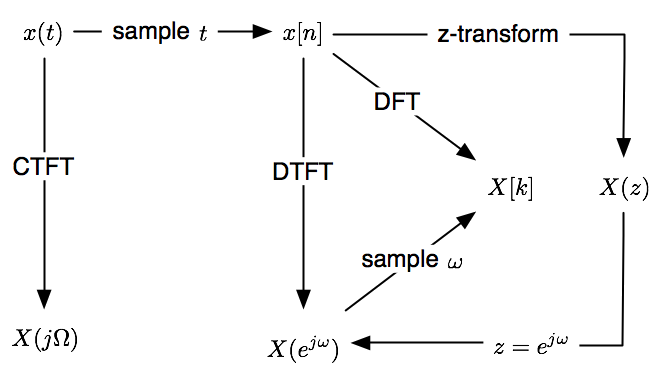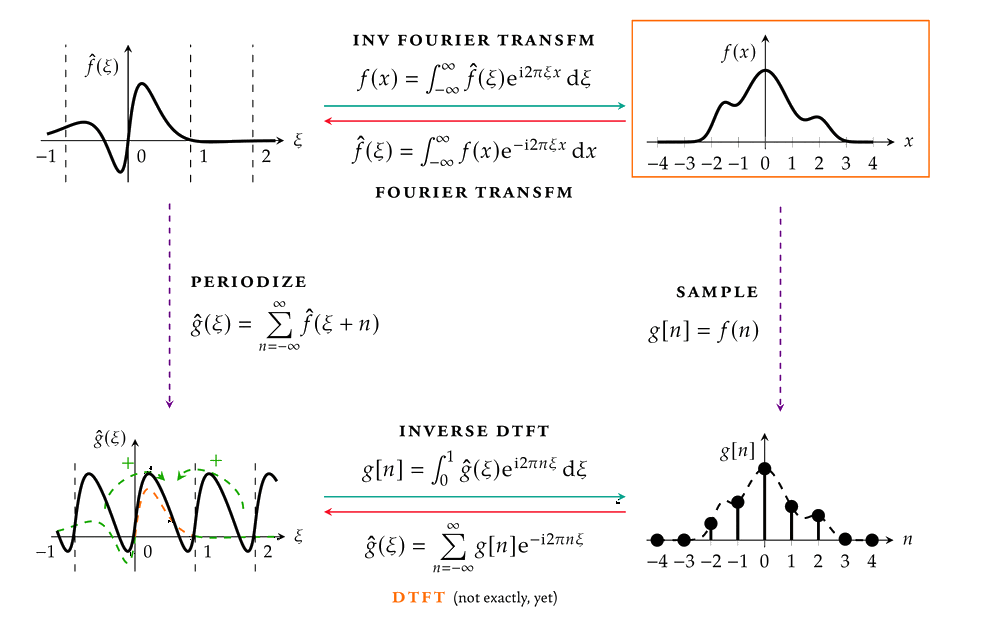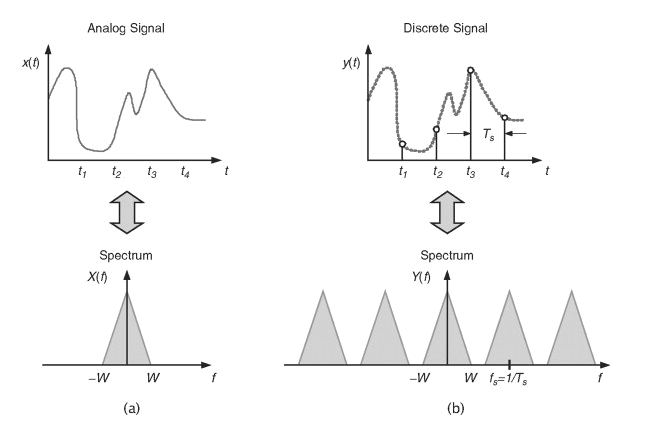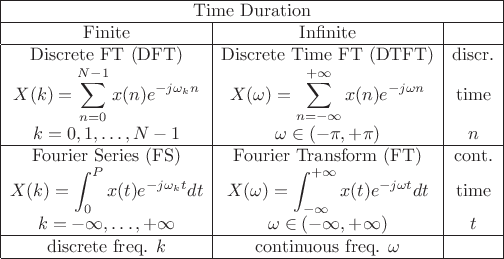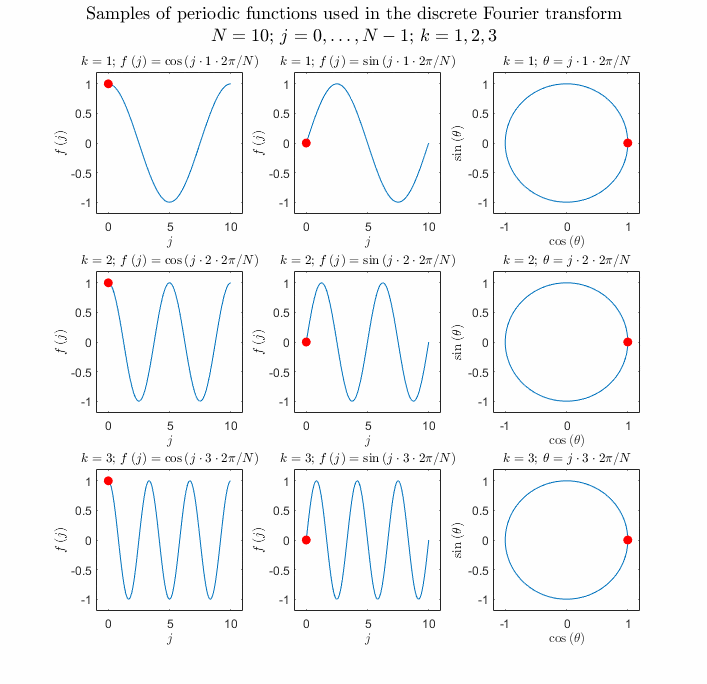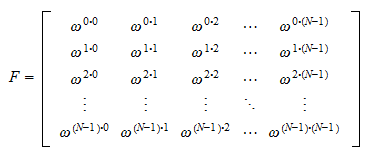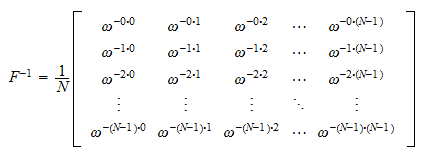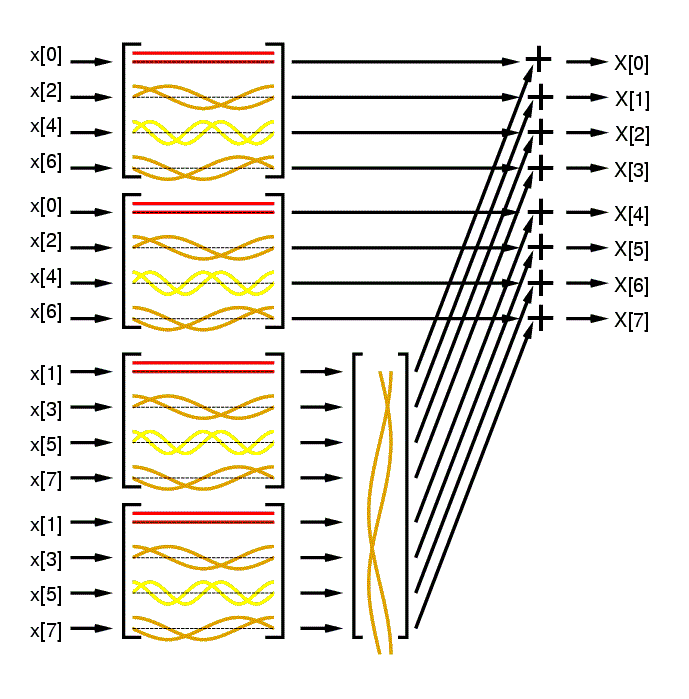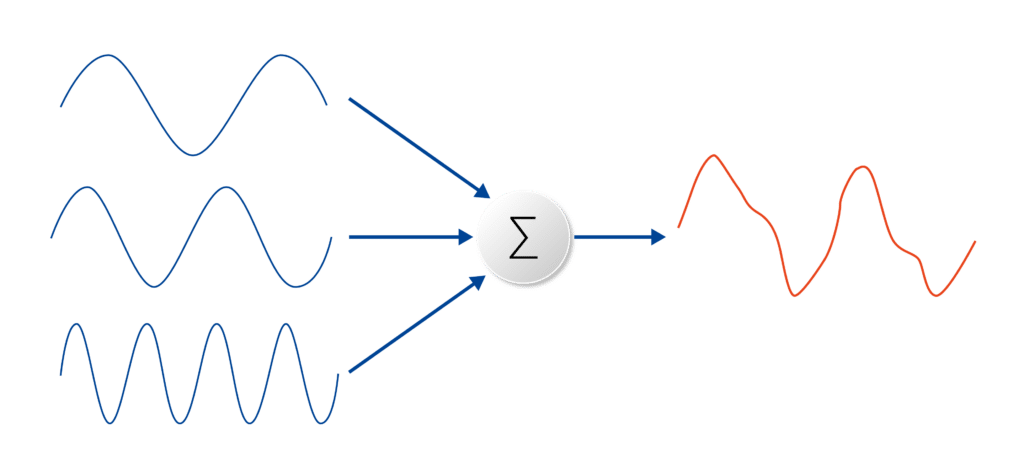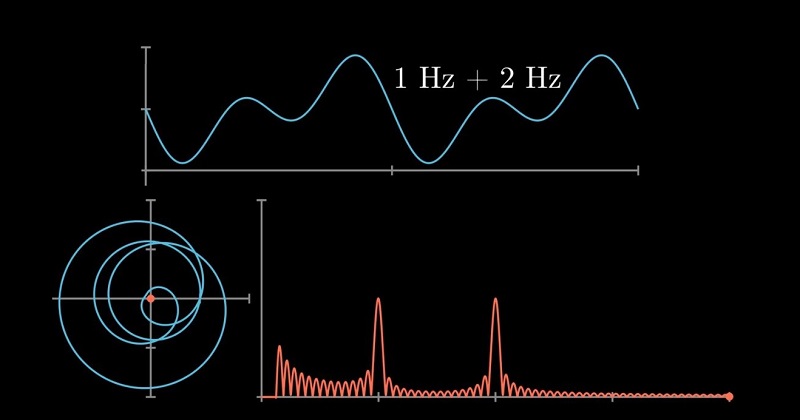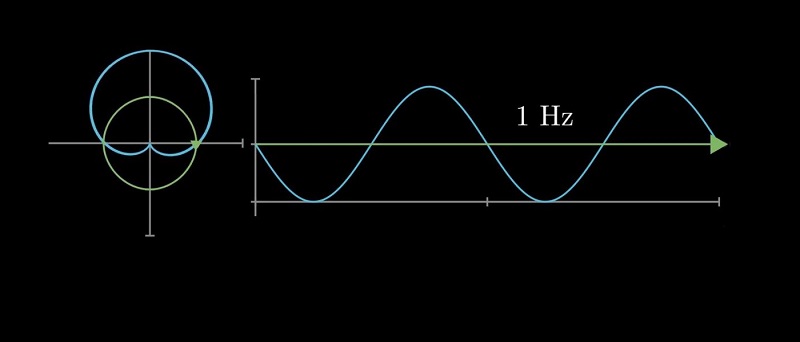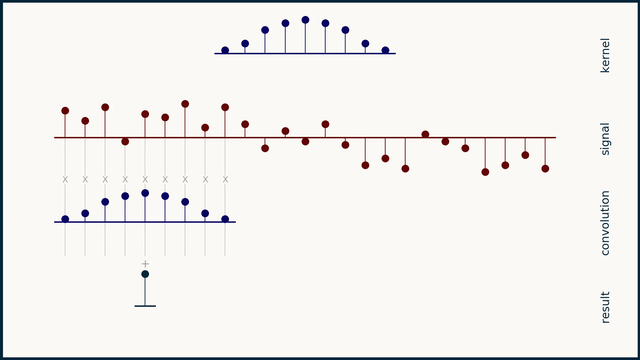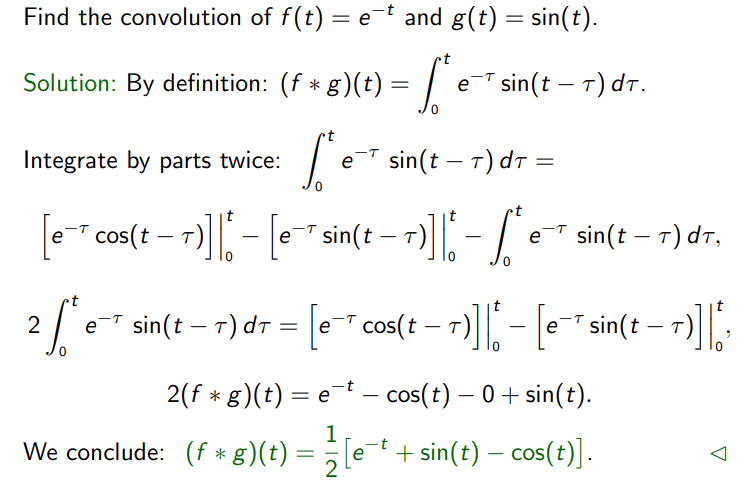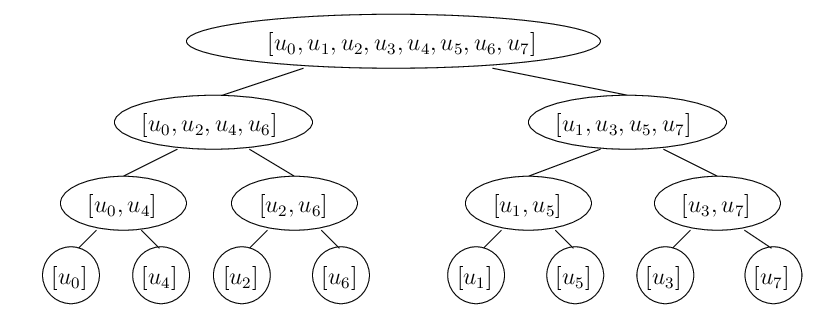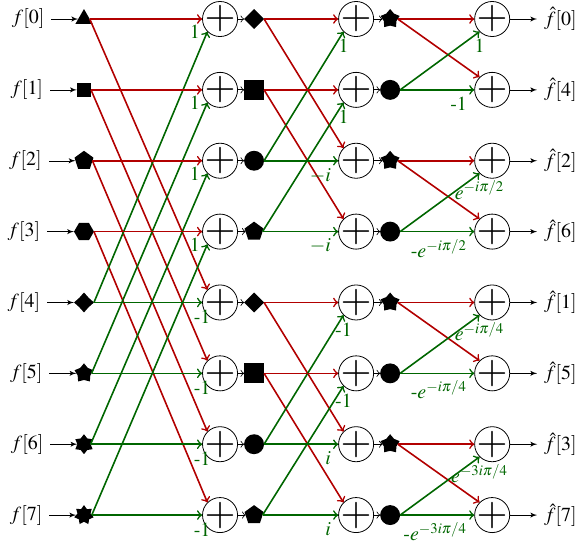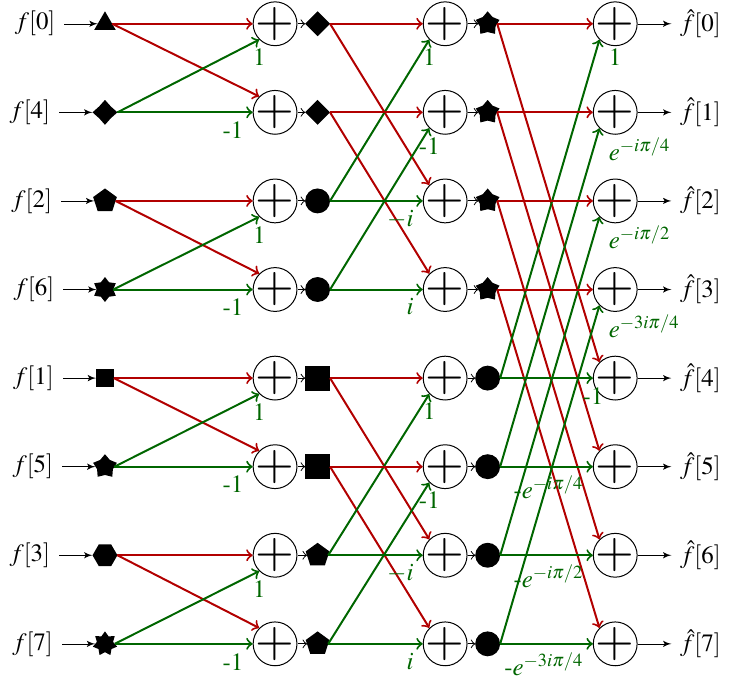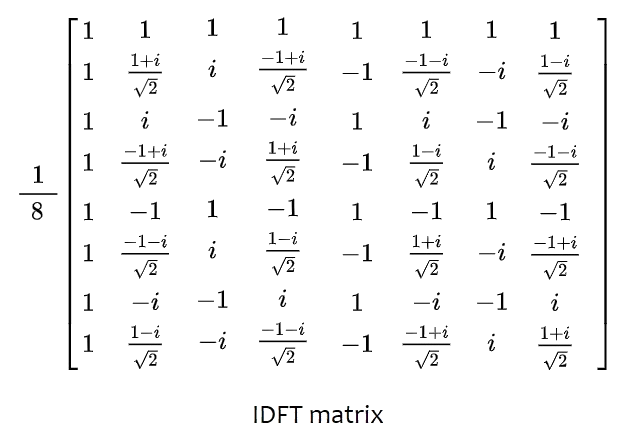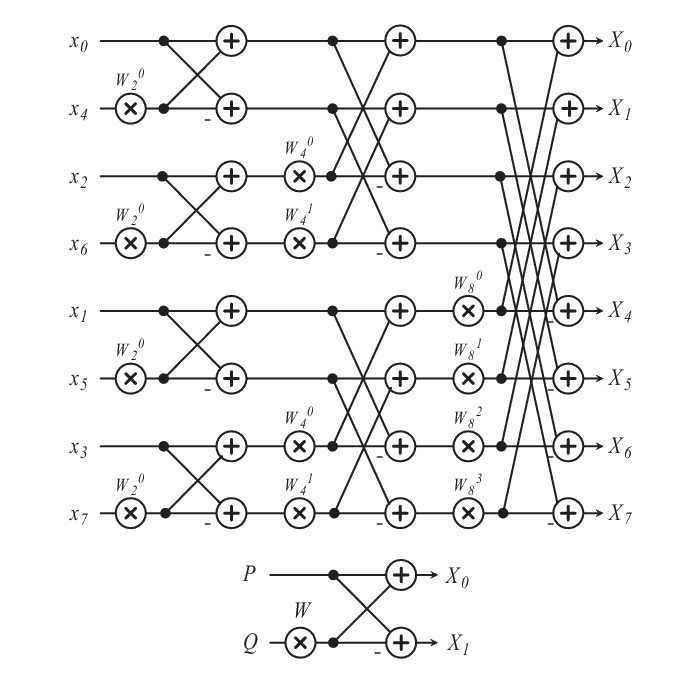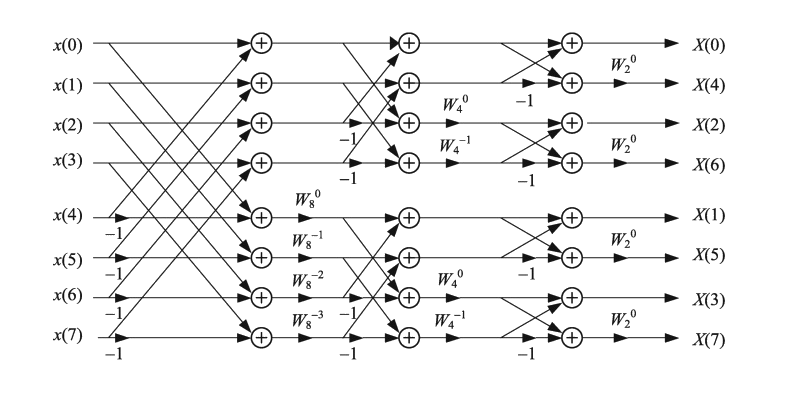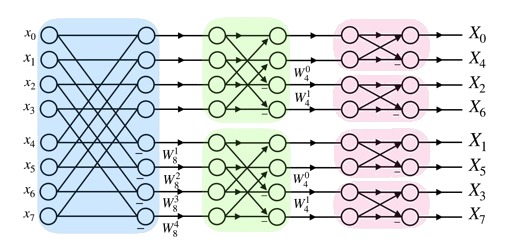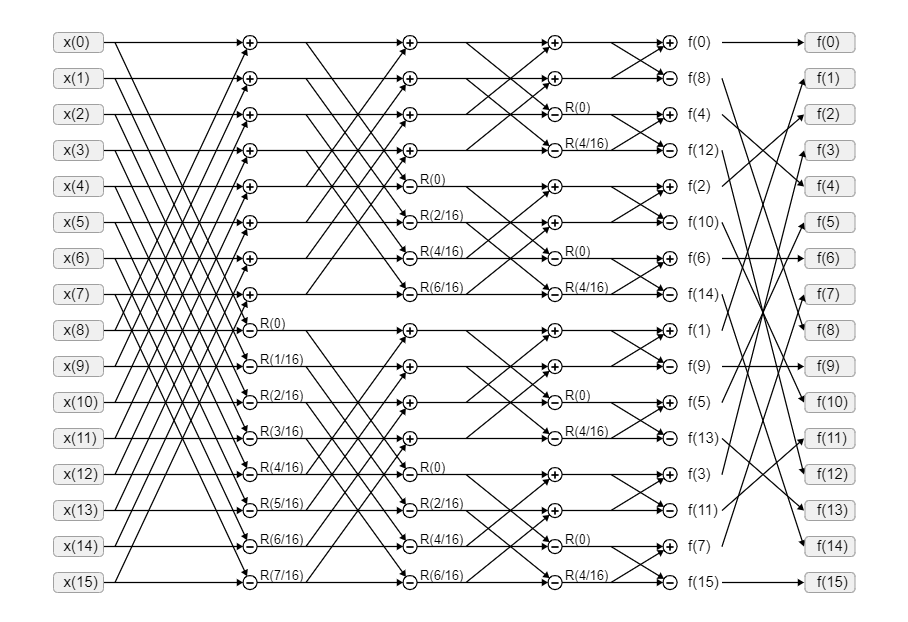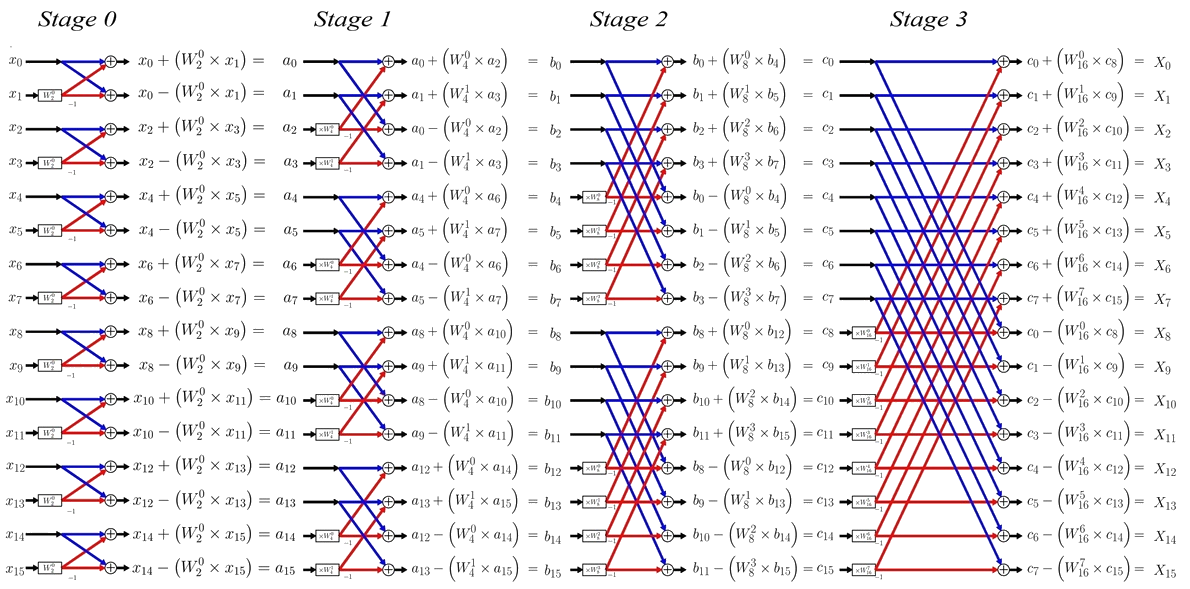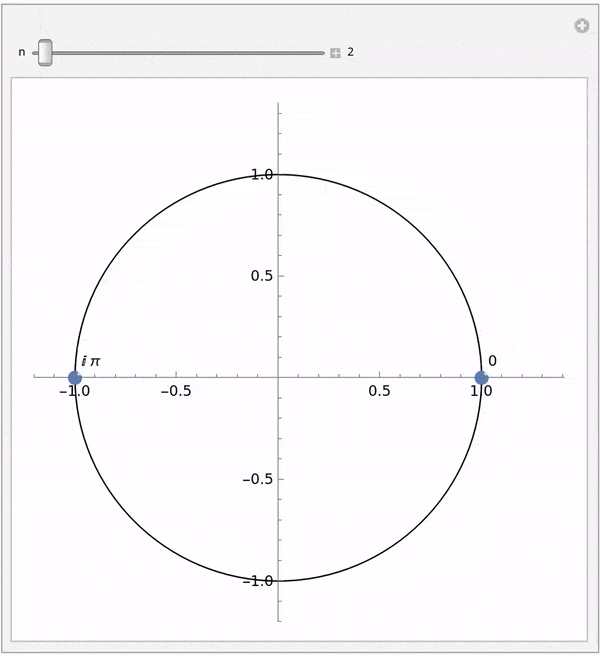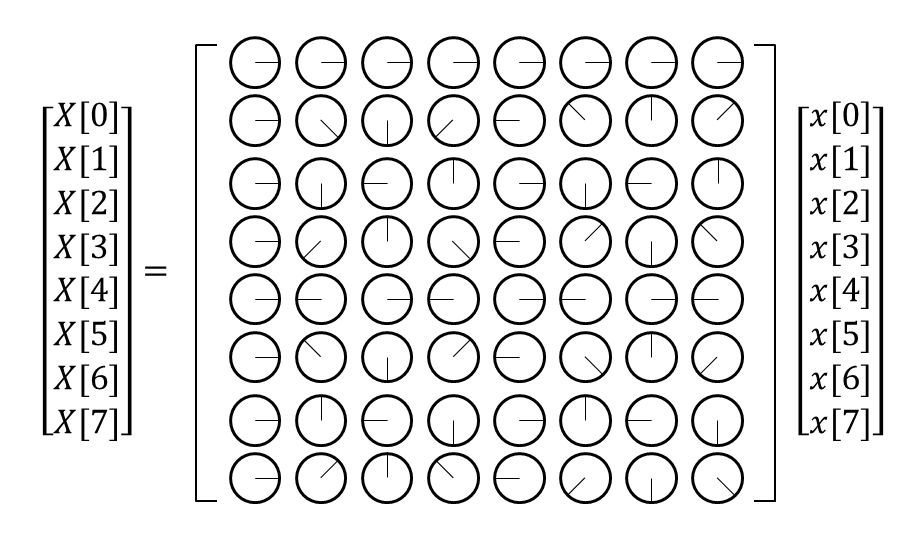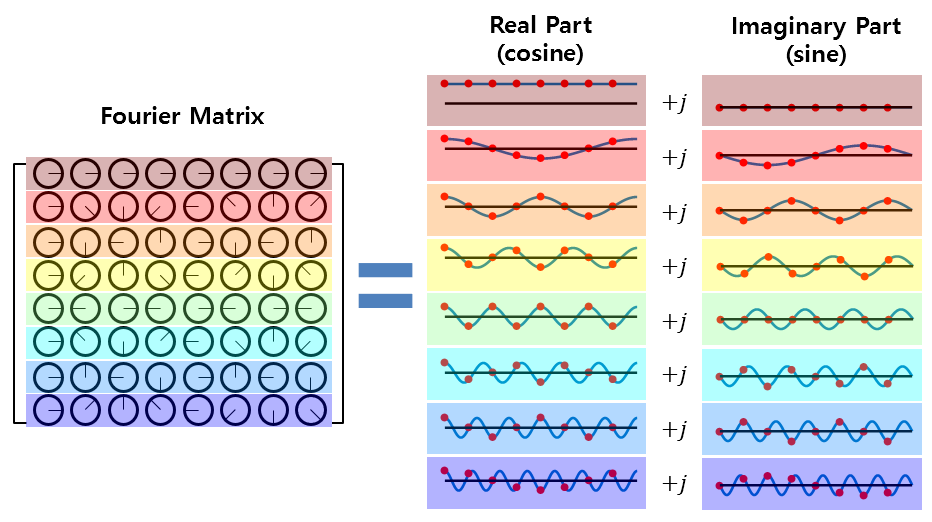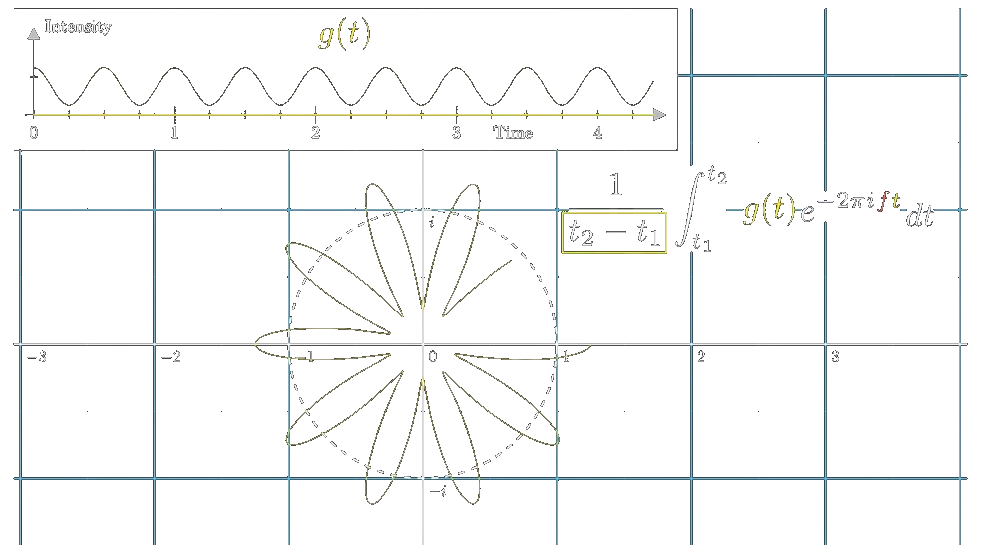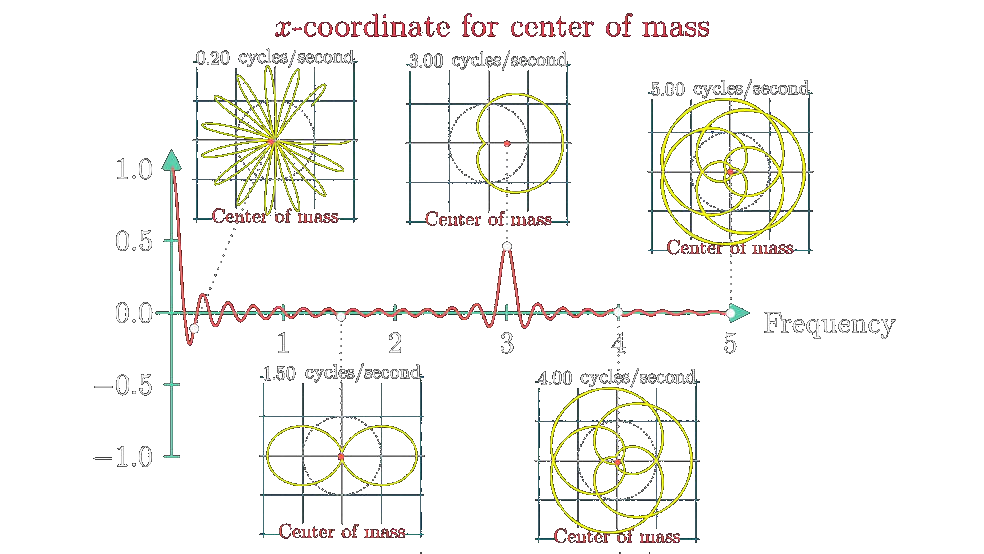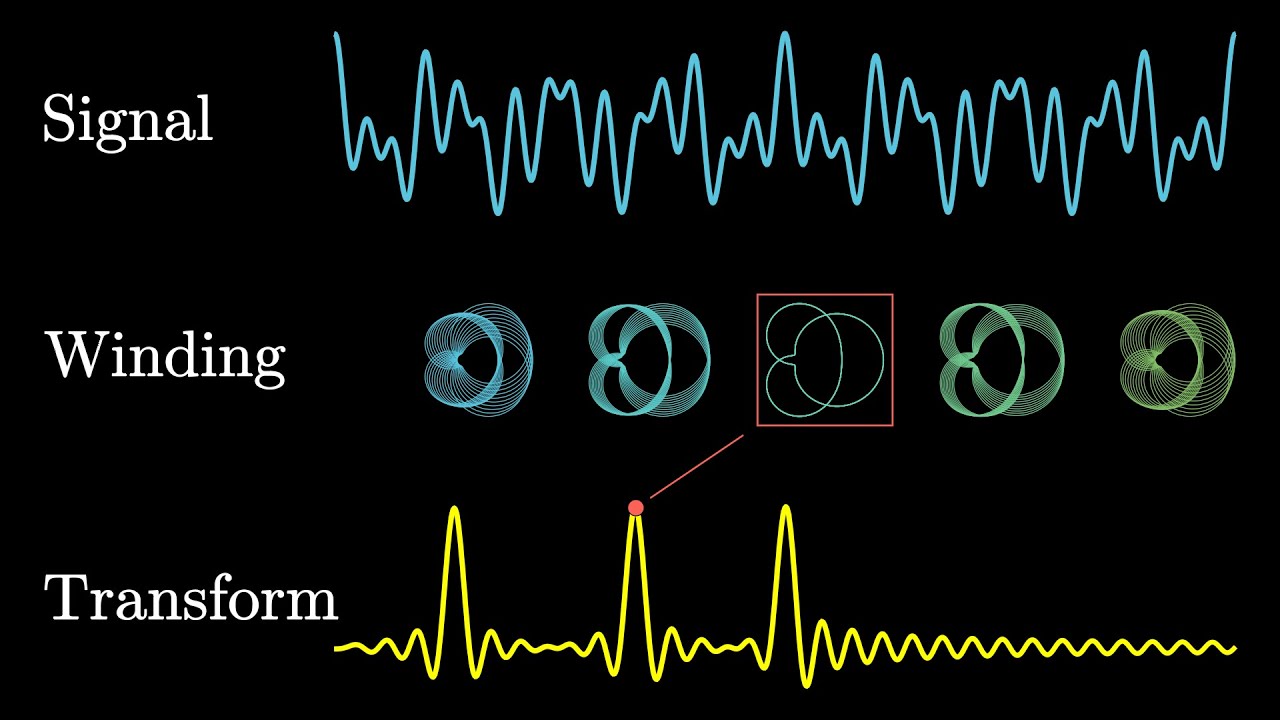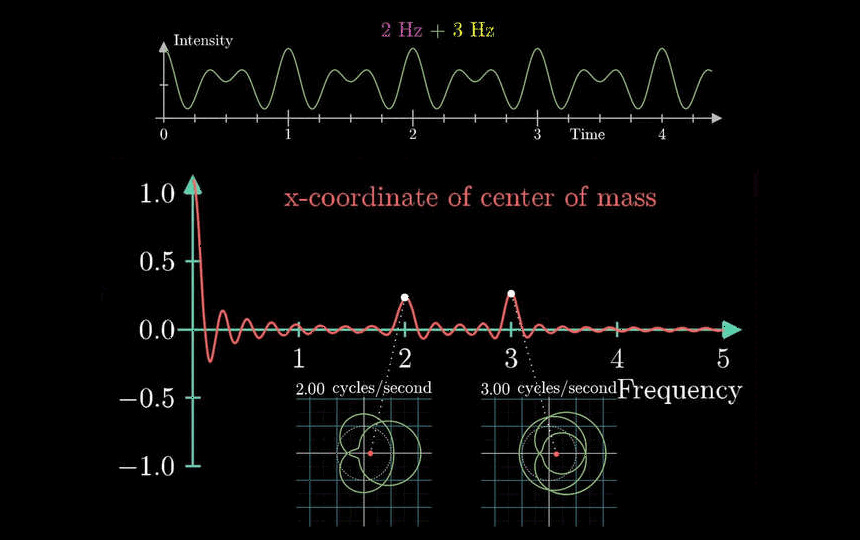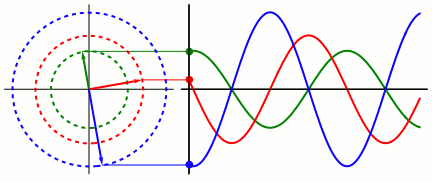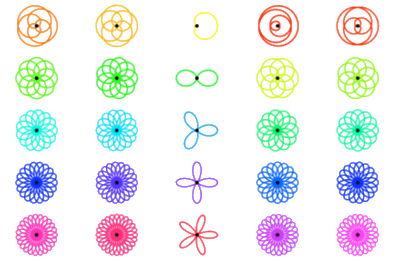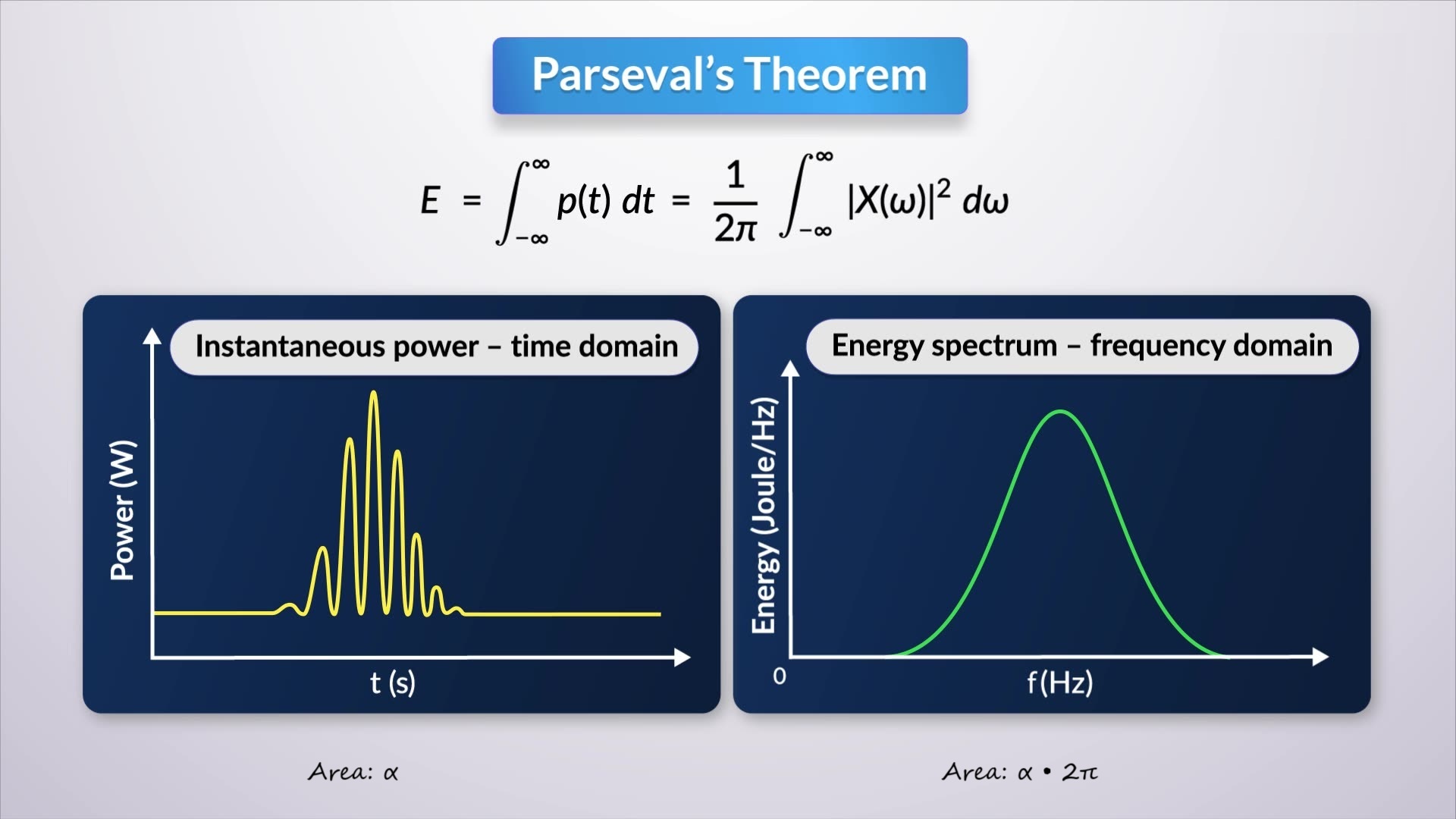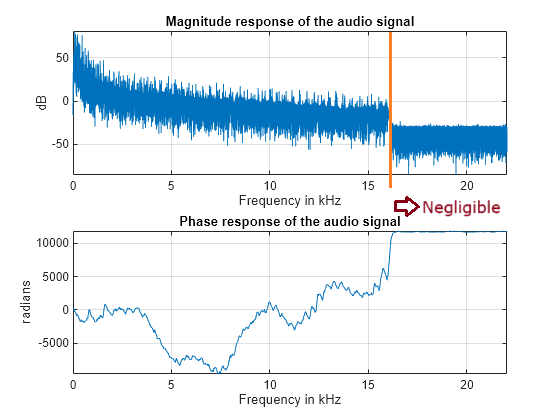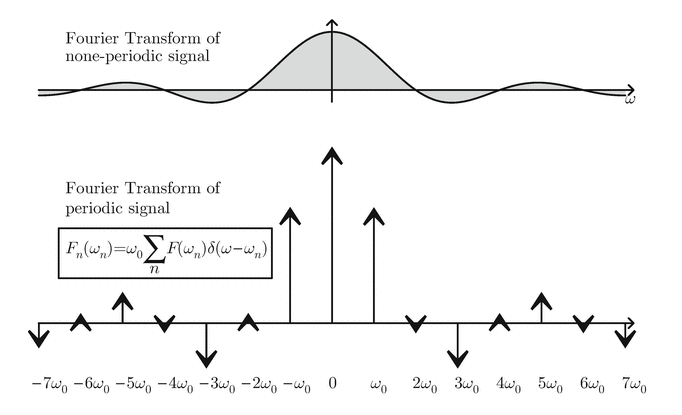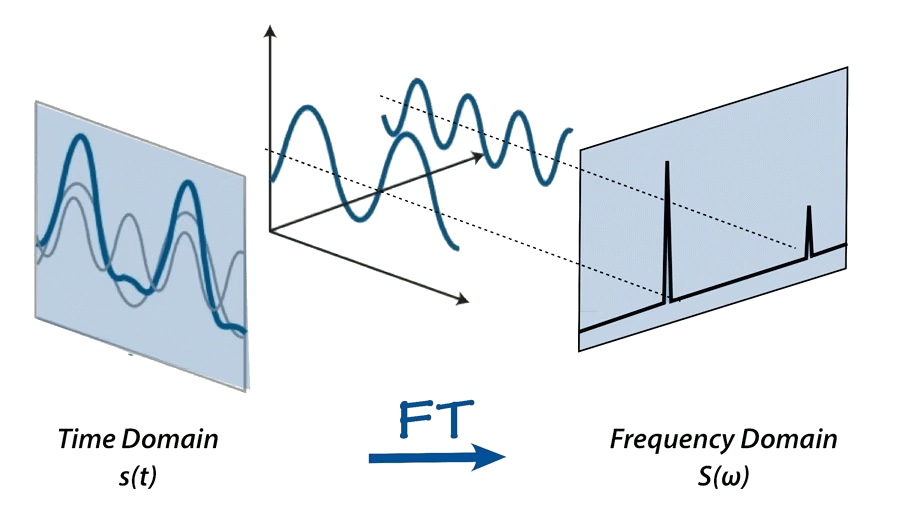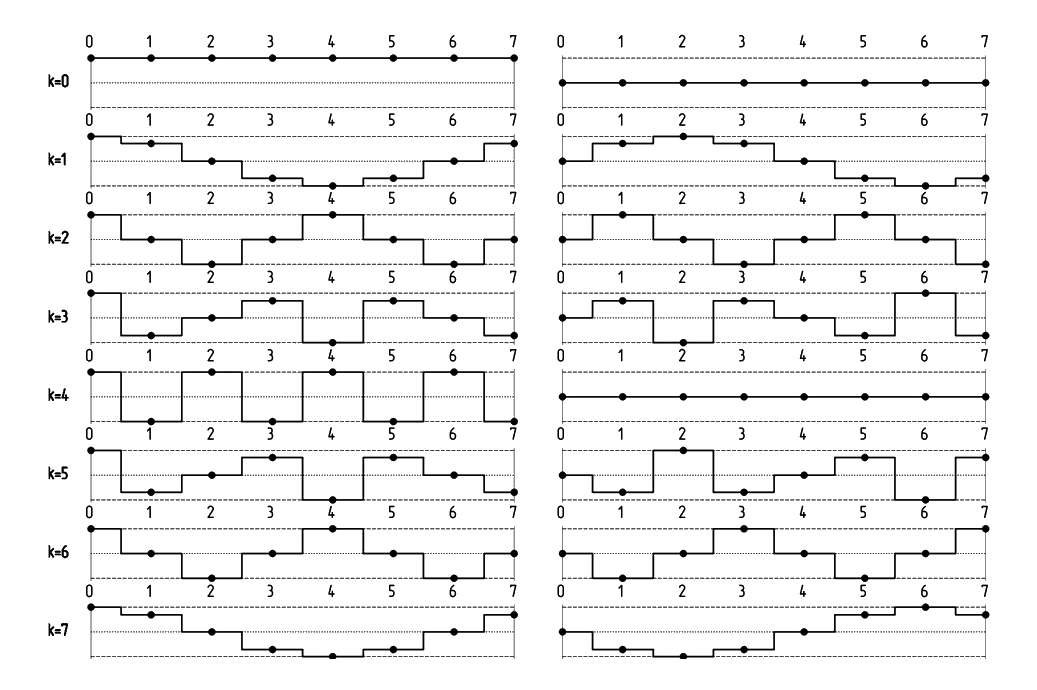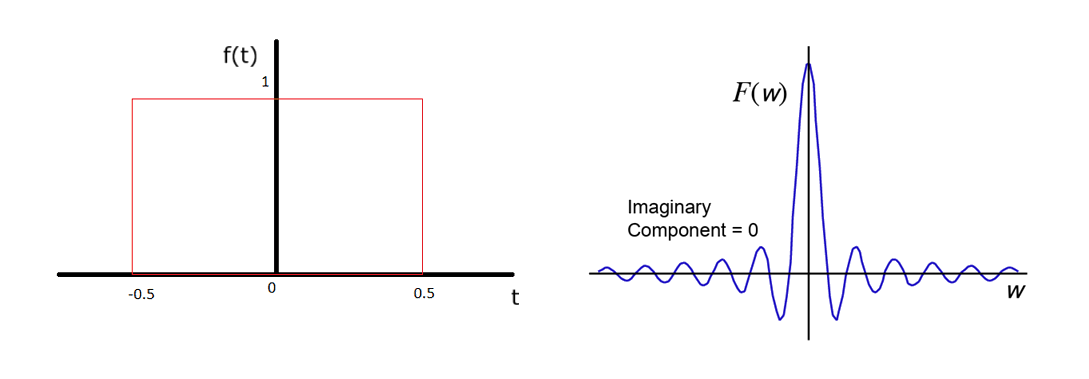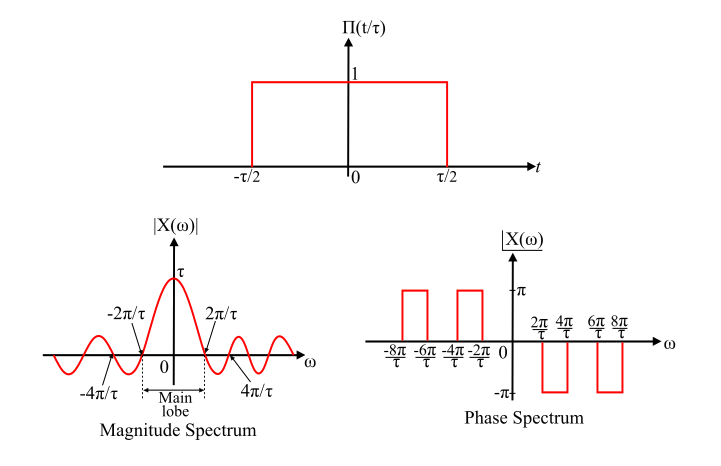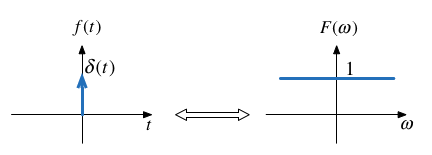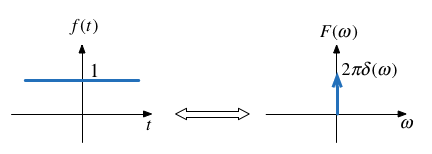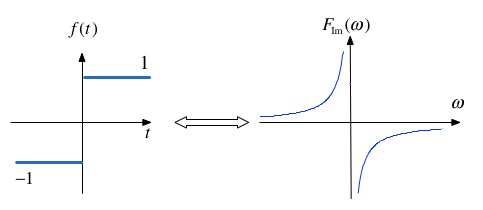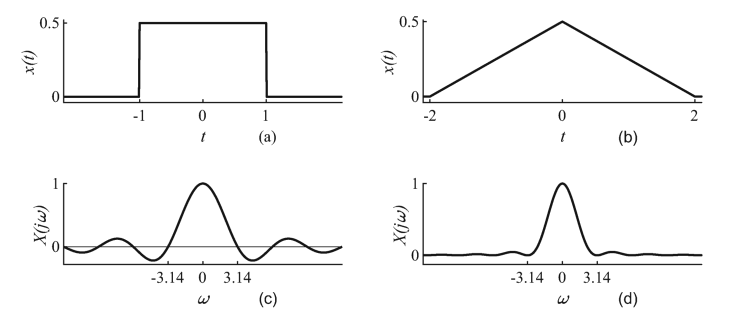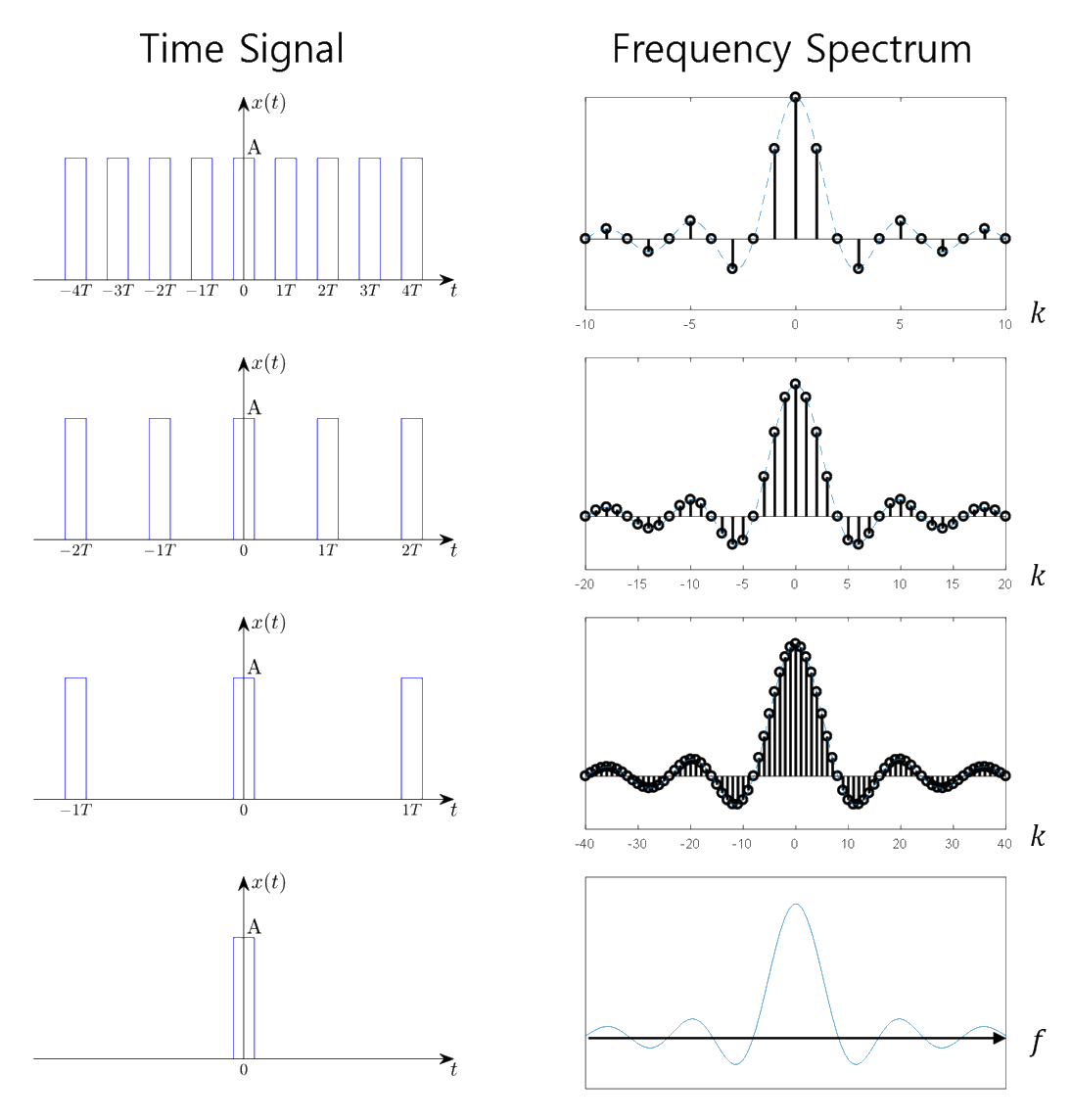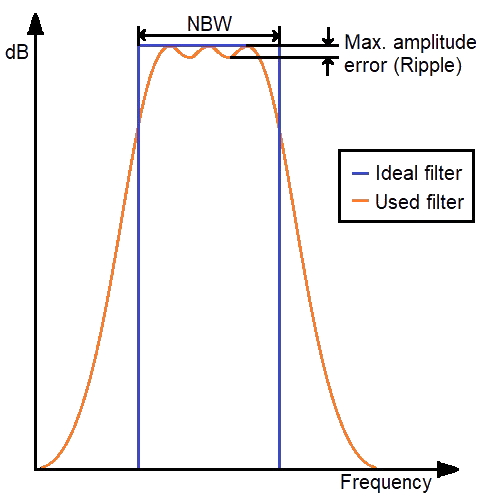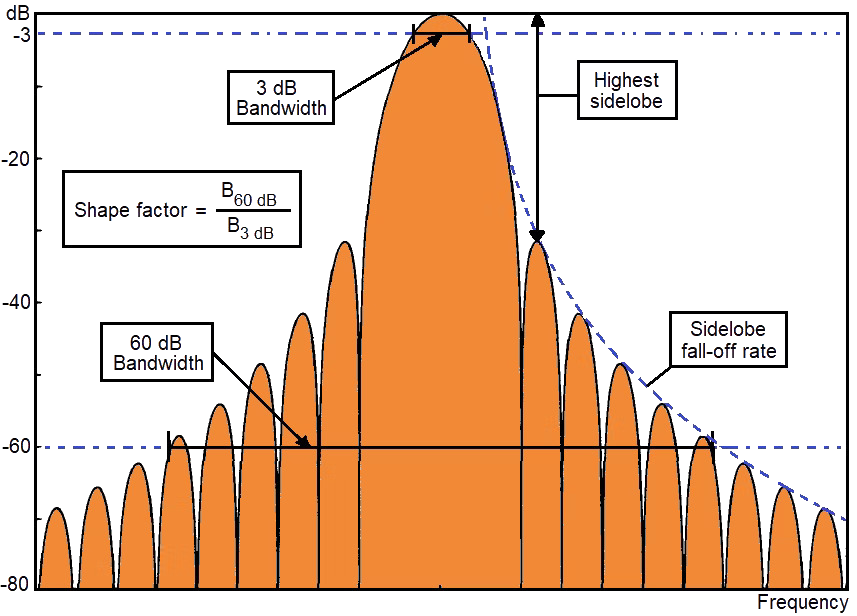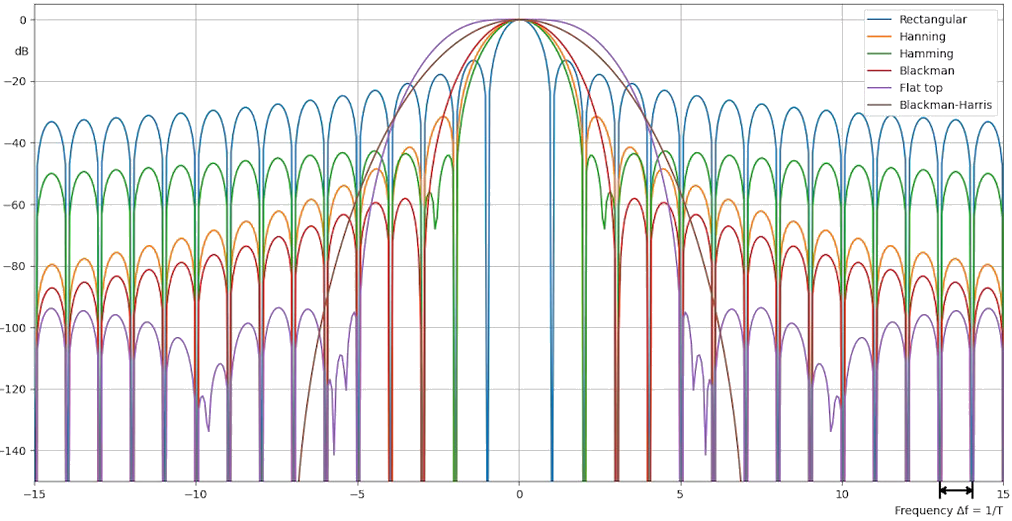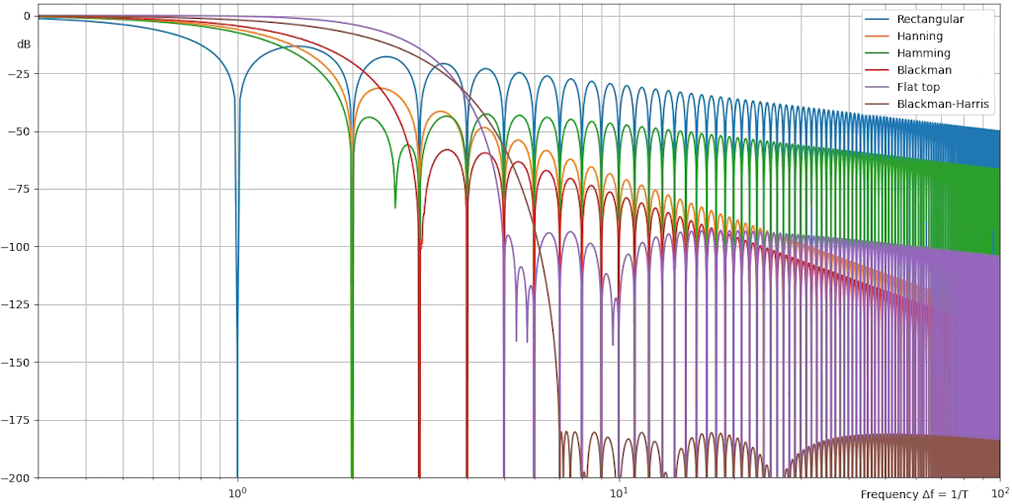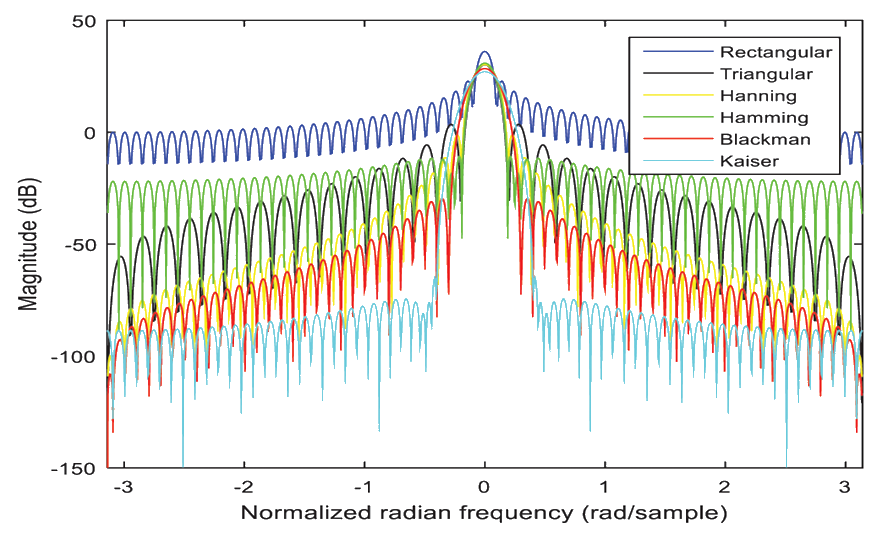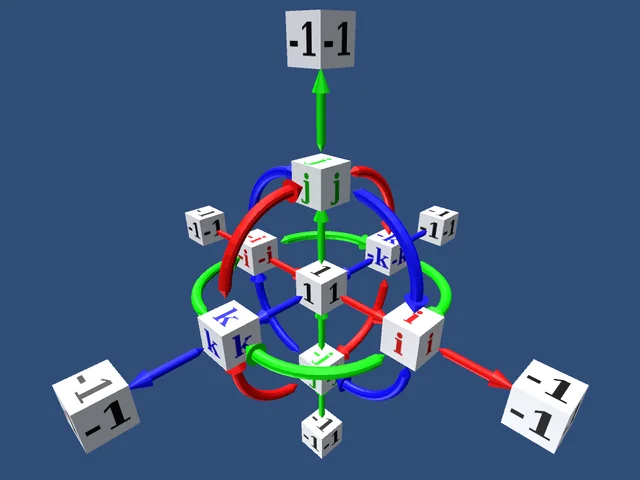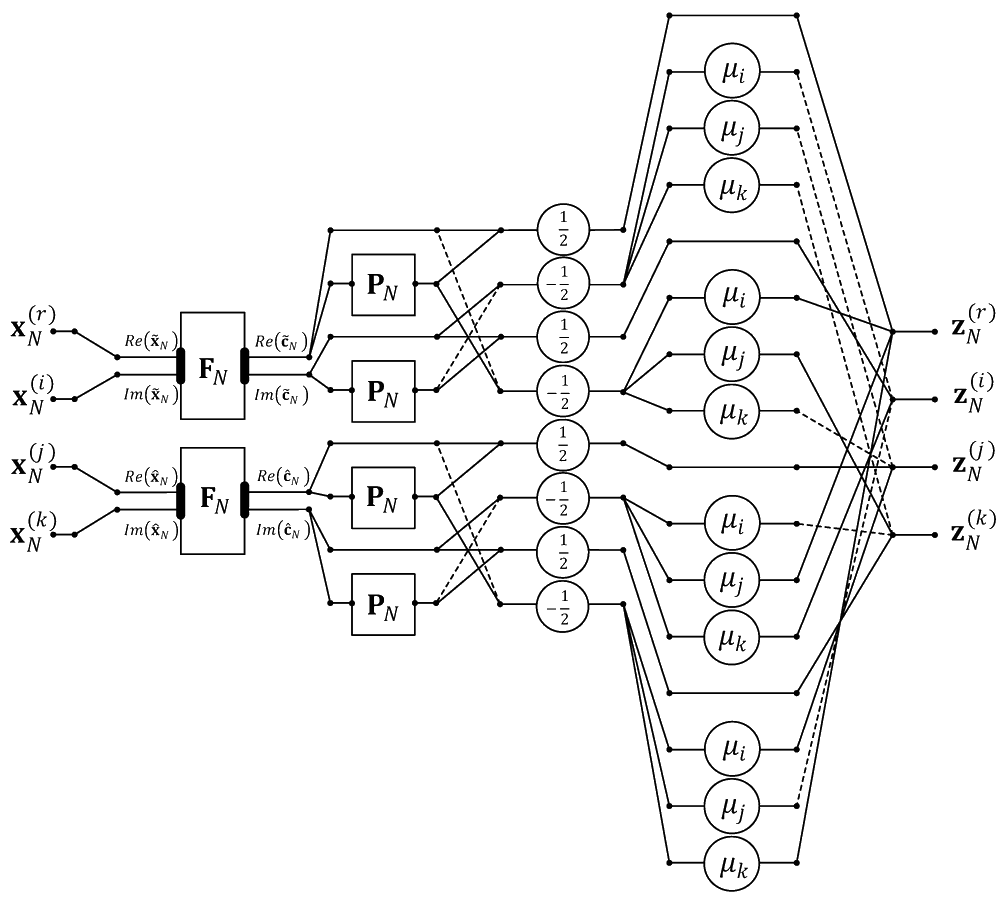Fast Fourier Transform
FFT
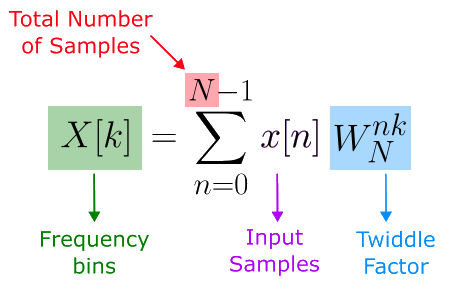
Fourier Series
Sine-cosine form
\(f(x)=a_0+\sum_{n=1}^\infty a_n\cos(nx)+\sum_{n=1}^\infty b_n\sin(nx)\)
\(\left\{\begin{array}{l}a_0=\frac1{2\pi}\int_{-\pi}^\pi f(x)\operatorname dx\\a_n=\frac1\pi\int_{-\pi}^\pi f(x)\cos(nx)\operatorname dx\\b_n=\frac1\pi\int_{-\pi}^\pi f(x)sin(nx)\operatorname dx\end{array}\right.\)
If \(f(x)\) is a periodic function,
\(f(x)=\sum_{n=0}^\infty\lbrack a_n\cos(\frac{2n\pi}Tx)+b_n\sin(\frac{2n\pi}Tx)\rbrack\)
\(f(x)=a_0+\sum_{n=1}^\infty\lbrack a_n\cos(\frac{2n\pi}Tx)+b_n\sin(\frac{2n\pi}Tx)\rbrack\)
If \(f(x)\)'s period is \(2\pi\)
What kind of frequencies should we use?
\(\sin(x),\sin(2x),\sin(\frac x2),\cdots?\;\cos(x),\cos(2x),\cos(\frac x2),\cdots?\) or both?
\(\sin(x),\sin(2x),\sin(nx),\cdots,\;\cos(x),\cos(2x),\cos(nx),\cdots\;\Rightarrow OK\)
\(\sin(\frac x2),\sin(\frac x3),\sin(\frac83x),\cdots,\;\cos(\frac x2),\cos(\frac x3),\cos(\frac83x),\cdots\;\Rightarrow NO\)
\(f(x)=\underbrace{\frac{f(x)+f(-x)}2}_{even}+\underbrace{\frac{f(x)-f(-x)}2}_{odd}\)
\(f(x)=a_0+\sum_{n=1}^\infty a_n\cos(nx)+\sum_{n=1}^\infty b_n\sin(nx),\;N\in\mathcal N,\;a_n,b_n\in\mathcal R\)
The correlation between two functions can be done by their integral result.
\(\int_a^bf(x)g(x)\operatorname dx,\;\mathcal R\rightarrow\mathcal C\)
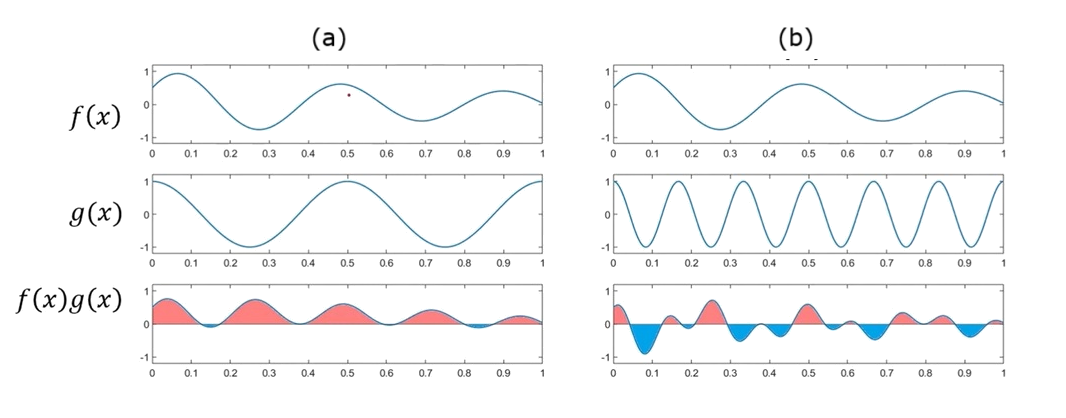
How to get \(a_n\) of \(f(x)\)?
[Ex] \(f(x)=a_0+a_1\cos(x)+a_2\cos(2x)+b_1\sin(x)+b_2\sin(2x)\)
\(f(x)=f(x+2\pi)\)
\(\int_{-\pi}^\pi f(x)\operatorname dx=\int_{-\pi}^\pi a_0\operatorname dx=2a_0\pi\;\rightarrow a_0=\frac1{2\pi}\int_{-\pi}^\pi f(x)\operatorname dx\)
\(\int_{-\pi}^\pi f(x)\cos(x)\operatorname dx=a_0\underbrace{\int_{-\pi}^\pi\cos(x)\operatorname dx}_0+a_1\underbrace{\int_{-\pi}^\pi\cos(x)\cos(x)\operatorname dx}_\pi+a_2\underbrace{\int_{-\pi}^\pi\cos(2x)\cos(x)\operatorname dx}_0+b_1\underbrace{\int_{-\pi}^\pi\sin(x)\cos(x)\operatorname dx}_0+b_2\underbrace{\int_{-\pi}^\pi\sin(2x)\cos(x)\operatorname dx}_0\)
\(=a_1\int_{-\pi}^\pi\frac12\lbrack\cos(2x)+1\rbrack\operatorname dx\)
\(\Rightarrow\int_{-\pi}^\pi f(x)\cos(x)\operatorname dx=a_1\pi\;\rightarrow a_1=\frac1\pi\int_{-\pi}^\pi f(x)\cos(x)\operatorname dx\)
\(\Rightarrow a_n=\frac1\pi\int_{-\pi}^\pi f(x)\cos(nx)\operatorname dx,\;n\geq1\)
\(\Rightarrow b_n=\frac1\pi\int_{-\pi}^\pi f(x)\sin(nx)\operatorname dx,\;n\geq1\)
\(f(x)=a_0+\sum_{n=1}^\infty a_n\cos(nx)+\sum_{n=1}^\infty b_n\sin(nx)\)
\(\left\{\begin{array}{l}a_0=\frac1{2\pi}\int_{-\pi}^\pi f(x)\operatorname dx\\a_n=\frac1\pi\int_{-\pi}^\pi f(x)\cos(nx)\operatorname dx\\b_n=\frac1\pi\int_{-\pi}^\pi f(x)sin(nx)\operatorname dx\end{array}\right.\)
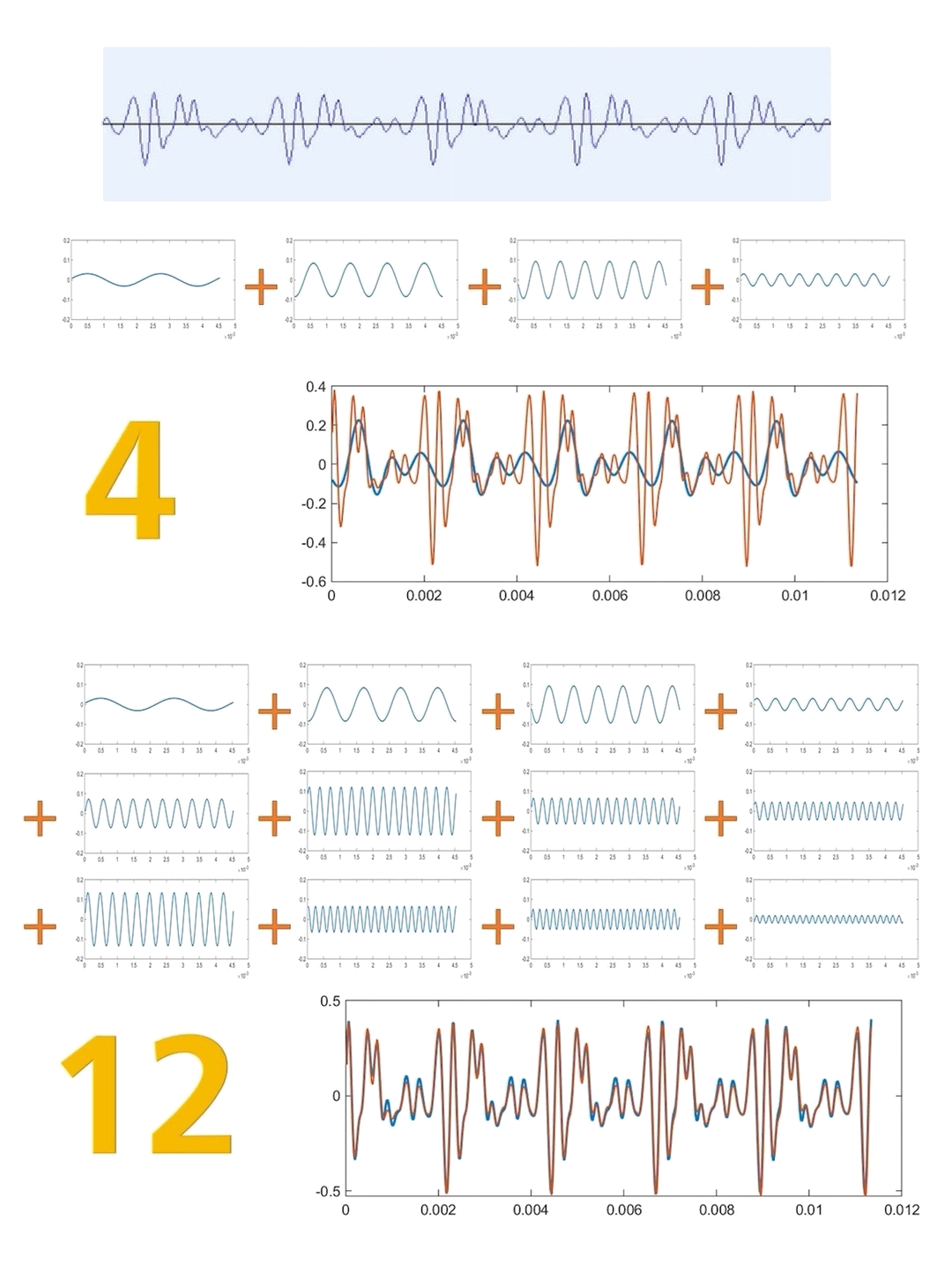
\(\left\{\begin{array}{l}a_0=\frac1{2\pi}\int_{-\pi}^\pi f(x)\operatorname dx\\a_n=\frac1\pi\int_{-\pi}^\pi f(x)\cos(nx)\operatorname dx\\b_n=\frac1\pi\int_{-\pi}^\pi f(x)sin(nx)\operatorname dx\end{array}\right.\Rightarrow\left\{\begin{array}{l}\int_{-\pi}^\pi a_0\cos(nx)\operatorname dx=0\\\int_{-\pi}^\pi a_0\sin(nx)\operatorname dx=0\\\int_{-\pi}^\pi\cos(mx)\cos(nx)\operatorname dx\\\int_{-\pi}^\pi\sin(mx)\cos(nx)\operatorname dx\\\int_{-\pi}^\pi\sin(mx)\sin(nx)\operatorname dx\end{array}\right.\)
\(\left.\begin{array}{l}\int_{-\pi}^\pi a_0\cos(nx)\operatorname dx=0\\\int_{-\pi}^\pi a_0\sin(nx)\operatorname dx=0\end{array}\right\}\;\omega=2\pi\)
\(\left.\begin{array}{l}\int_{-\pi}^\pi\cos(mx)\cos(nx)\operatorname dx\\\int_{-\pi}^\pi\sin(mx)\cos(nx)\operatorname dx\\\int_{-\pi}^\pi\sin(mx)\sin(nx)\operatorname dx\end{array}\right\}\left\{\begin{array}{l}m=n\\m\neq n\end{array}\right.\)
\(\int_{-\pi}^\pi\cos(mx)\cos(nx)\operatorname dx=\frac12\int_{-\pi}^\pi\{\cos\lbrack(m+n)x\rbrack+\cos\lbrack(m-n)x\rbrack\}\operatorname dx=\left\{\begin{array}{lc}2\pi&(n=m)=0\\0&n\neq m\\\pi&(n=m)\neq0\end{array}\right.\)
\(\int_{-\pi}^\pi\sin(mx)\cos(nx)\operatorname dx=\frac12\int_{-\pi}^\pi\{\sin\lbrack(m+n)x\rbrack+\sin\lbrack(m-n)x\rbrack\}\operatorname dx=0\)
\(\int_{-\pi}^\pi\sin(mx)\sin(nx)\operatorname dx=-\frac12\int_{-\pi}^\pi\{\cos\lbrack(m+n)x\rbrack-\cos\lbrack(m-n)x\rbrack\}\operatorname dx=\left\{\begin{array}{lc}0&n\neq m\;or\;(n=m)=0\\\pi&(n=m)\neq0\end{array}\right.\)
Apply to any frequency not \(2\pi\)
\(\int_{-L}^L\sin(\frac{n\pi}Lx)\sin(\frac{m\pi}Lx)\operatorname dx=\left\{\begin{array}{ll}0&n\neq m\\0&(n=m)=0\\L&(n=m)\neq0\end{array}\right.\)
\(\int_{-L}^L\cos(\frac{n\pi}Lx)\cos(\frac{m\pi}Lx)\operatorname dx=\left\{\begin{array}{ll}0&n\neq m\\2L&(n=m)=0\\L&(n=m)\neq0\end{array}\right.\)
\(\int_{-L}^L\sin(\frac{n\pi}Lx)\cos(\frac{m\pi}Lx)\operatorname dx=0\)
\(\int_L^L\sin(\frac{n\pi}Lx)\operatorname dx=0\)
\(\int_L^L\cos(\frac{n\pi}Lx)\operatorname dx=0\)
Orthogonal Basis
\(\begin{bmatrix}1\\0\\0\end{bmatrix},\begin{bmatrix}0\\1\\0\end{bmatrix},\begin{bmatrix}0\\0\\1\end{bmatrix}\)
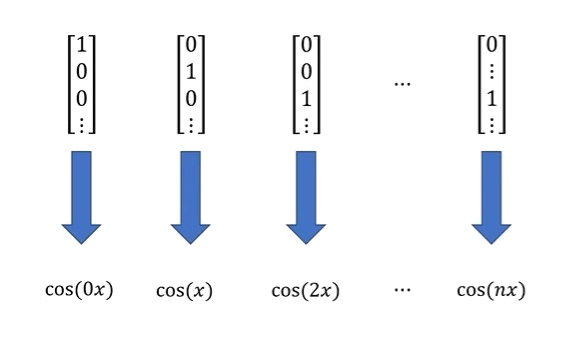
including \(cos(nx)\) and \(sin(nx)\)
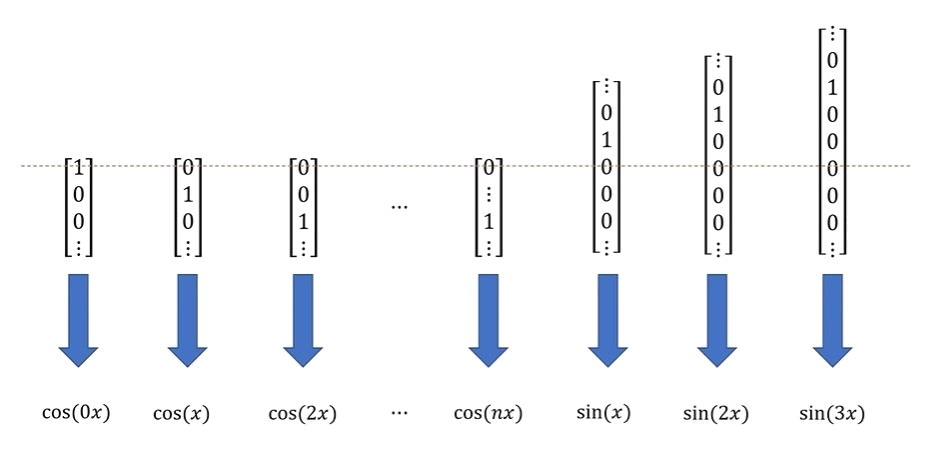
\(\int_{-\pi}^\pi f(x)g(x)\operatorname dx\): inner product of two functions
\(\sqrt{\int_{-\pi}^\pi\left|f(x)\right|^2\operatorname dx}\): norm of a function
Hilbert Space
In mathematics, a Hilbert space is a real or complex inner product space that is also a complete metric space with respect to the metric induced by the inner product. It generalizes the notion of Euclidean space, to infinite dimensions. The inner product, which is the analog of the dot product from vector calculus, allows lengths and angles to be defined. Furthermore, completeness means that there are enough limits in the space to allow the techniques of calculus to be used. A Hilbert space is a special case of a Banach space.
A Hilbert space is a vector space \(H\) with an inner product \(\left\langle f,\;g\right\rangle\) such that the norm defined by
\(|f|=\sqrt{\left\langle f,f\right\rangle}\)
turns \(H\) into a complete metric space.

The overtones of a vibrating string. These are eigenfunctions of an associated Sturm–Liouville problem. The eigenvalues 1, ½, ⅓, ... form the (musical) harmonic series.
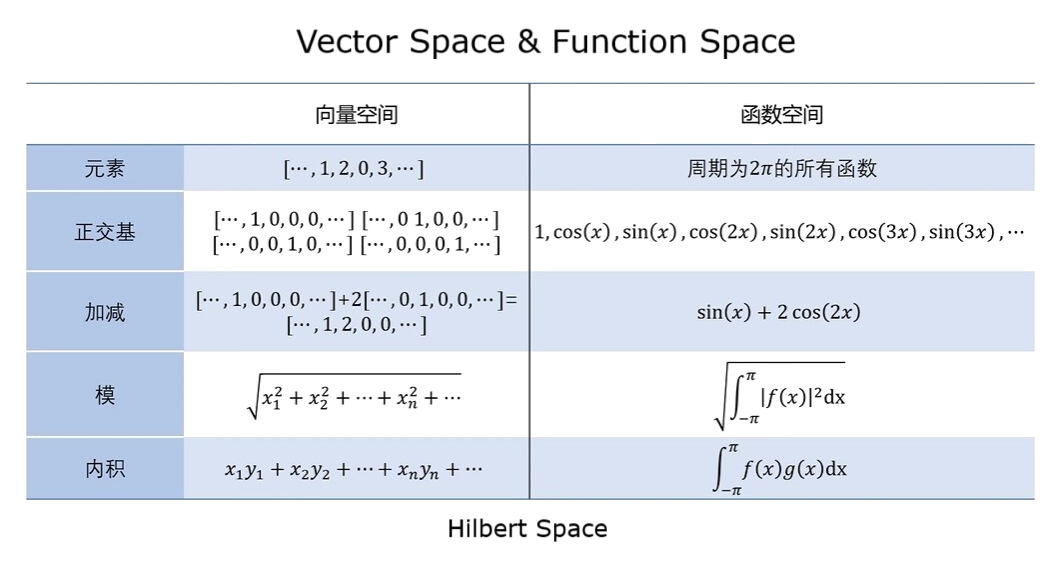
Projection
\(\left\langle\overset\rightharpoonup a,\overset\rightharpoonup x\right\rangle=\left|\overset\rightharpoonup a\right|\left|\overset\rightharpoonup x\right|\cos(\theta)\)
\(Projection\;on\;x-axis:\frac{\left\langle\overset\rightharpoonup a,\overset\rightharpoonup x\right\rangle}{\left|\overset\rightharpoonup x\right|}\)
\(Projection\;on\;y-axis:\frac{\left\langle\overset\rightharpoonup a,\overset\rightharpoonup y\right\rangle}{\left|\overset\rightharpoonup y\right|}\)
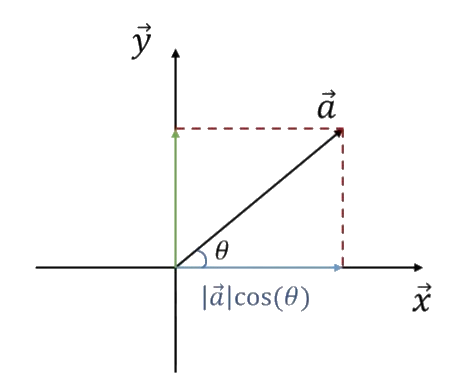
Orthogonal basis but not a non-standard basis
\(\cos(x),\;\sin(x),\;\cos(2x),\;\sin(2x),\;\cdots\)
the norm of \(sin(nx)\): \(\sqrt{\int_{-\pi}^\pi\sin^2(nx)\operatorname dx}=\sqrt\pi\)
the norm of \(cos(nx)\): \(\sqrt{\int_{-\pi}^\pi cos^2(nx)\operatorname dx}=\sqrt\pi,\;(n\neq0)\)
the norm of \(1\): \(\sqrt{\int_{-\pi}^\pi1^2\operatorname dx}=\sqrt{2\pi}\)
\(\underbrace{1,\;\cos(x),\;\sin(x),\;\cos(2x),\;\sin(2x),\;\cdots}_{non\;standard\;basis}\;\Rightarrow\underbrace{\frac1{\sqrt{2\pi}},\;\;\frac{\cos(x)}{\sqrt\pi},\;\frac{\sin(x)}{\sqrt\pi},\;\frac{\cos(2x)}{\sqrt\pi},\;\frac{\sin(2x)}{\sqrt\pi},\;\cdots}_{standard\;basis}\)
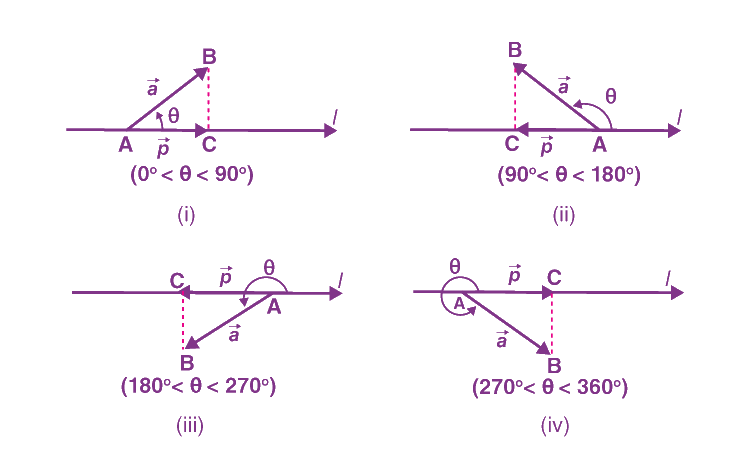
\(f(x)\) with \(2\pi\) frequency signals projected on \(cos(2x)\) direction
\(\frac{\left\langle f(x),\cos(2x)\right\rangle}{\left|\cos(2x)\right|}=\frac{\int_{-\pi}^\pi f(x)cos(2x)\operatorname dx}{\sqrt{\int_{-\pi}^\pi cos^2(2x)\operatorname dx}}=\frac1{\sqrt\pi}\int_{-\pi}^\pi f(x)cos(2x)\operatorname dx\;\Rightarrow\frac1{\sqrt\pi}\int_{-\pi}^\pi f(x)cos(nx)\operatorname dx\)
\(f(x)\) with \(2\pi\) frequency signals projected on \(cos(2x)\) basis
\(\frac{\left\langle f(x),\cos(2x)\right\rangle}{\left|\cos(2x)\right|^2}=\frac1\pi\int_{-\pi}^\pi f(x)cos(2x)\operatorname dx=a_2\)

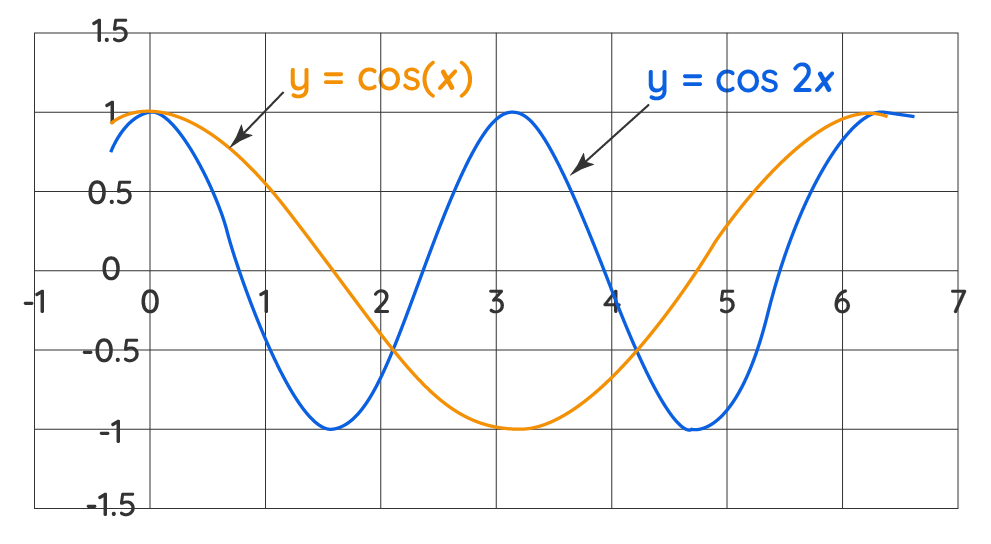
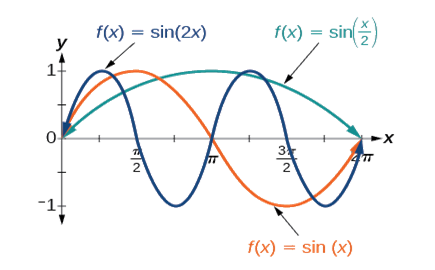
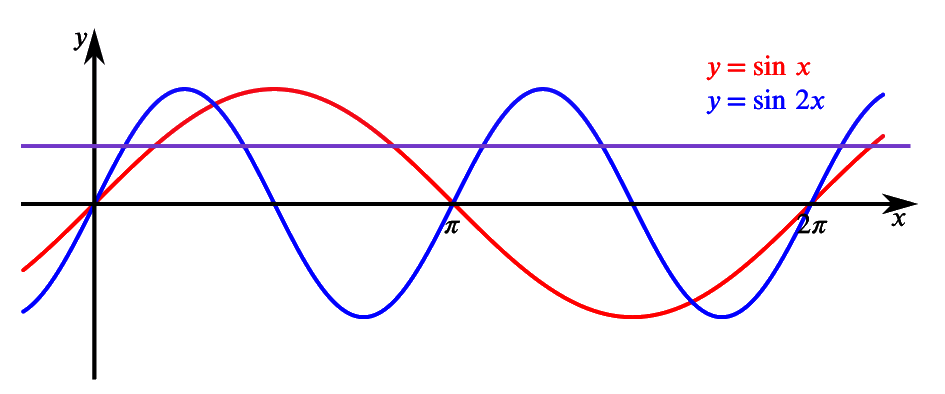
The Complex Fourier Transform
\(f(x)=a_0+\sum_{n=1}^\infty a_n\cos(nx)+\sum_{n=1}^\infty b_n\sin(nx)\)
\(\left\{\begin{array}{l}a_0=\frac1{2\pi}\int_{-\pi}^\pi f(x)\operatorname dx\\a_n=\frac1\pi\int_{-\pi}^\pi f(x)\cos(nx)\operatorname dx\\b_n=\frac1\pi\int_{-\pi}^\pi f(x)sin(nx)\operatorname dx\end{array}\right.\)
\(f(x)=\sum_{n=-\infty}^\infty c_ne^{inx}\)
\(c_n=\frac1{2\pi}\int_{-\pi}^\pi f(x)e^{-inx}dx\)
\(\left\{\begin{array}{l}\cos\theta=\frac{e^{i\theta}+e^{-i\theta}}2\\\sin\theta=\frac{e^{i\theta}-e^{-i\theta}}{2i}\end{array}\right.\)
\(f(x)=a_0+\sum_{n=1}^\infty a_n\cos(nx)+\sum_{n=1}^\infty b_n\sin(nx)\)
\(=a_0+\sum_{n=1}^\infty\frac{a_n}2(e^{inx}+e^{-inx})+\sum_{n=1}^\infty\frac{b_n}{2i}(e^{inx}-e^{-inx})\)
\(=\underbrace{a_0}_{c_0}+\sum_{n=1}^\infty\underbrace{(\frac{a_n-ib_n}2)}_{c_n}e^{inx}+\sum_{n=1}^\infty\underbrace{(\frac{a_n+ib_n}2)}_{c_{-n}}e^{-inx}\)
\(=c_0+\sum_{n=1}^\infty c_ne^{inx}+\sum_{n=1}^\infty c_{-n}e^{-inx}\)
\(=c_0+\sum_{n=1}^\infty c_ne^{inx}+\sum_{n=-1}^{-\infty}c_ne^{inx}\)
\(=\sum_{n=-\infty}^\infty c_ne^{inx}\)
\(\left\{\begin{array}{l}c_n=\frac{a_n-ib_n}2\\c_{-n}=\frac{a_n+ib_n}2\\c_0=a_0\end{array}\right.\;(n\geq1)\)
How to get \(c_n\)?
\(c_n=\frac{a_n-ib_n}2=\frac{{\displaystyle\frac1\pi}\int_{-\pi}^\pi f(x)\cos(nx)\operatorname dx-i\frac1\pi\int_{-\pi}^\pi f(x)\sin(nx)\operatorname dx}2\)
\(=\frac1{2\pi}\int_{-\pi}^\pi f(x)\cos(nx)\operatorname dx-i\frac1{2\pi}\int_{-\pi}^\pi f(x)\sin(nx)\operatorname dx\)
\(=\frac1{2\pi}\int_{-\pi}^\pi f(x)\lbrack\cos(nx)-i\sin(nx)\rbrack\operatorname dx\)
\(c_n=\frac1{2\pi}\int_{-\pi}^\pi f(x)e^{-inx}\operatorname dx\;(n\geq1)\)
\(c_{-n}=\frac1{2\pi}\int_{-\pi}^\pi f(x)e^{inx}\operatorname dx\;(n\geq1)\;\Rightarrow\;c_n=\frac1{2\pi}\int_{-\pi}^\pi f(x)e^{-inx}\operatorname dx\;(n\leq-1)\)
\(c_0=\frac1{2\pi}\int_{-\pi}^\pi f(x)\operatorname dx\)
\(\Rightarrow c_n=\frac1{2\pi}\int_{-\pi}^\pi f(x)e^{-inx}\operatorname dx,\;n\in\mathcal N\)
\(f(x)\in\mathcal Z\)
\(f(x)=g(x)+ih(x)\)
\(=\sum_{n=-\infty}^\infty g_ne^{inx}+i\sum_{n=-\infty}^\infty h_ne^{inx}\;(g_n,\;h_n\in\mathcal Z,\;(g_{-n},\;h_{-n})\;is\;the\;Complex\;conjugate\;of\;(g_n,\;h_n))\)
\(=\sum_{n=-\infty}^\infty\underbrace{(g_n+ih_n)}_{c_n}e^{inx}\)
\(c_n=g_n+ih_n\;\Rightarrow\;\overline{c_n}=\overline{g_n+ih_n}=\overline{g_n}-i\overline{h_n}=g_{-n}-ih_{-n}\)
\((c_{-n}=g_{-n}+ih_{-n})\neq\overline{c_n}\)
Complex Fourier Series
\(f(x)=\sum_{n=-\infty}^\infty c_ne^{inx}\)
\(c_n=\frac1{2\pi}\int_{-\pi}^\pi f(x)e^{-inx}\operatorname dx\)
\(\Rightarrow\int_{-\pi}^\pi e^{i(m-n)x}\operatorname dx=\left\{\begin{array}{lc}0&m\neq n\\2\pi&m=n\end{array}\right.\)
\(e^{inx}\rightarrow\left\{\begin{array}{lcc}n=0&f(x)=e^0=1&\\n=1&f(x)=e^{ix}&T=2\pi,\;\left\|f(x)\right\|=1\\n=2&f(x)=e^{i2x}&T=\pi,\;\left\|f(x)\right\|=1\\n=-1&f(x)=e^{-ix}&T=2\pi,\;\left\|f(x)\right\|=1\end{array}\right.\)
\(f(x)=\cdots+c_{-2}e^{-i2x}+c_{-1}e^{-ix}+c_0+c_1e^{ix}+c_2e^{i2x}+\cdots\)
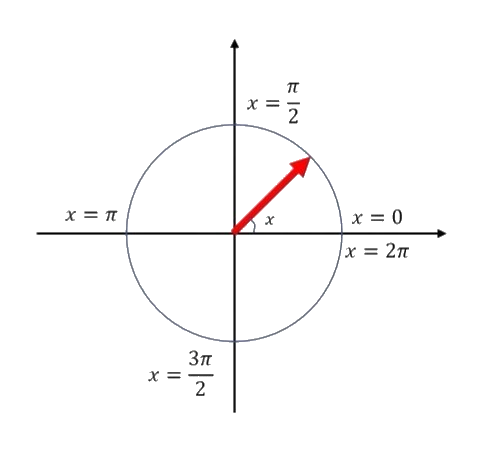
The Orthogonality of Complex Basis
\(\cdots,e^{-i3x},e^{-i2x},e^{-ix},1,e^{ix},e^{i2x},e^{i3x},\cdots\)
\(\int_{-\pi}^\pi e^{imx}e^{inx}\operatorname dx\;\not>0\)
\(\int_{-\pi}^\pi e^{imx}e^{-inx}\operatorname dx=\int_{-\pi}^\pi e^{i(m-n)x}\operatorname dx=\left\{\begin{array}{lc}0&m\neq n\\2\pi&m=n\end{array}\right.\)
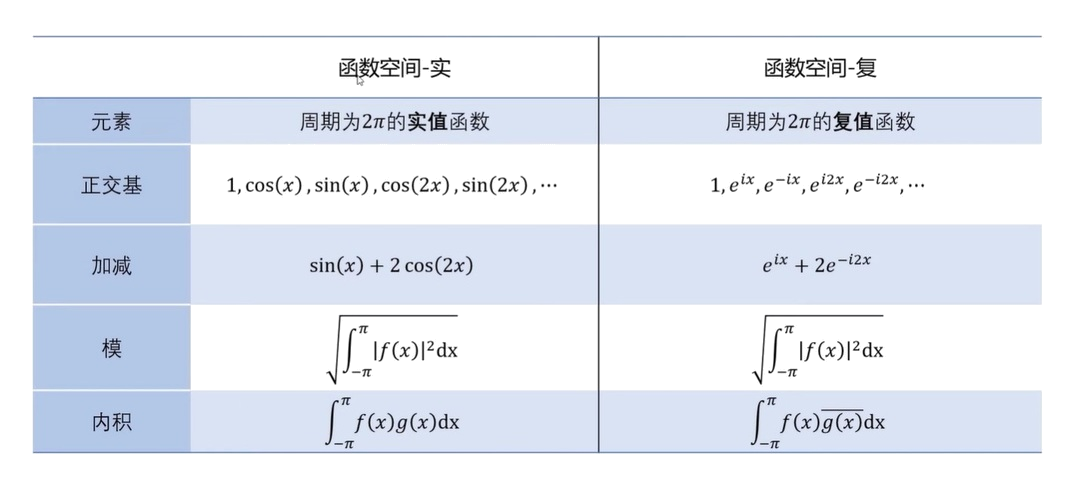
Standard basis for the field of complex numbers
\(\cdots,e^{-i3x},e^{-i2x},e^{-ix},1,e^{ix},e^{i2x},e^{i3x},\cdots\)
\(\int_{-\pi}^\pi e^{imx}e^{-inx}\operatorname dx=\left\{\begin{array}{lc}0&m\neq n\\2\pi&m=n\end{array}\right.,\;{\left\|e^{imx}\right\|}_C=\sqrt{2\pi}\)
\(period:\;2\pi,\;f(x)=\sum_{n=-\infty}^\infty c_ne^{inx}\)
\(f(x)\;\xrightarrow{FT}\left[\cdots,c_{-k},c_{-k+1},\cdots,c_{-2},c_{-1},c_0,c_1,c_2,\cdots,c_{k-1},c_k,\cdots\right]\)
\(period:\;T,\;f(x)=\sum_{n=-\infty}^\infty c_ne^{\frac{i2\pi n}Tx}\)
\(f(x)\;\xrightarrow{FT}\left[\cdots,c_{-k},c_{-k+1},\cdots,c_{-2},c_{-1},c_0,c_1,c_2,\cdots,c_{k-1},c_k,\cdots\right]\)
Discrete Fourier Transform
\(f(x)=\sum_{k=-\infty}^\infty c_ke^{ikx}\)
\(c_k=\frac1{2\pi}\int_{-\pi}^\pi f(x)e^{-ikx}\operatorname dx\)
\(e^{k\frac{2\pi i}N},\;(k=0,1,\cdots,N-1)\)
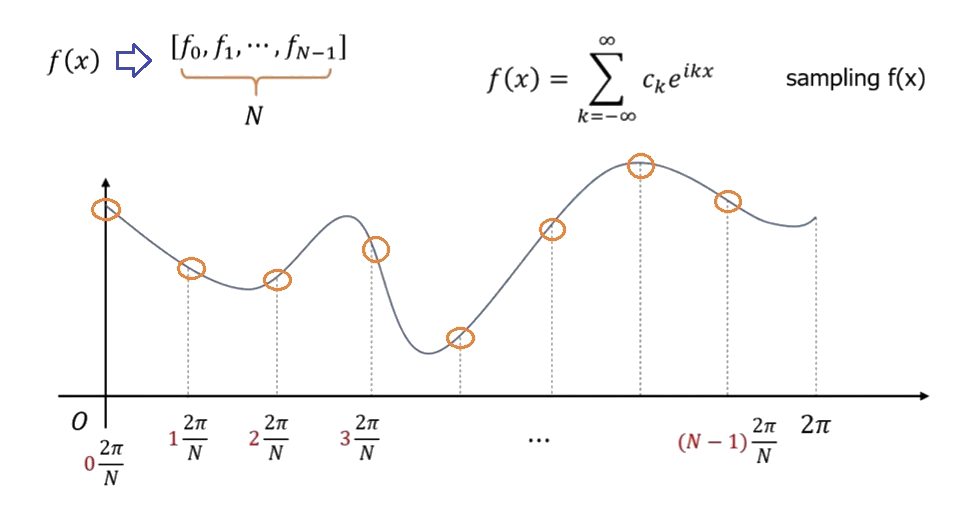
\(f(x)\) sampling
\(f(x)=\sum_{k=-\infty}^\infty c_ke^{ikx}\xrightarrow{x=\frac{2\pi}N}f_1=f(\frac{2\pi}N)=\sum_{k=-\infty}^\infty c_ke^{k\frac{2\pi i}N}\)
\(f(\frac{2\pi}N)=\cdots+c_{-2}e^{-2\cdot\frac{2\pi i}N}+c_{-1}e^{-1\cdot\frac{2\pi i}N}+c_0e^{0\cdot\frac{2\pi i}N}+c_1e^{1\cdot\frac{2\pi i}N}+c_2e^{2\cdot\frac{2\pi i}N}+\cdots+c_{k-1}e^{(k-1)\cdot\frac{2\pi i}N}+c_ke^{k\cdot\frac{2\pi i}N}+c_{k+1}e^{(k+1)\cdot\frac{2\pi i}N}+\cdots\)
\(what\;is\;e^{k\cdot\frac{2\pi i}N}?\)
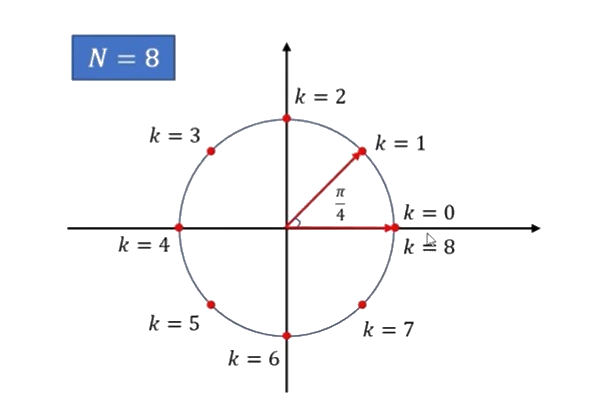
\(f(\frac{2\pi}N)=\cdots+c_{-2}e^{-2\cdot\frac{2\pi i}N}+c_{-1}e^{-1\cdot\frac{2\pi i}N}+c_0e^{0\cdot\frac{2\pi i}N}+c_1e^{1\cdot\frac{2\pi i}N}+c_2e^{2\cdot\frac{2\pi i}N}+\cdots+c_{k-1}e^{(k-1)\cdot\frac{2\pi i}N}+c_ke^{k\cdot\frac{2\pi i}N}+c_{k+1}e^{(k+1)\cdot\frac{2\pi i}N}+\cdots\)
\(=(c_0+c_N+c_{-N}+c_{2N}+c_{-2N}+\cdots)e^{0\cdot\frac{2\pi i}N}\)
\(+(c_1+c_{N+1}+c_{-N+1}+c_{2N+1}+c_{-2N+1}+\cdots)e^{1\cdot\frac{2\pi i}N}\)
\(+(c_2+c_{N+2}+c_{-N+2}+c_{2N+2}+c_{-2N+2}+\cdots)e^{2\cdot\frac{2\pi i}N}\)
\(\dots\)
\(+(c_{N-1}+c_{2N-1}+c_{-1}+c_{3N-1}+c_{-N-1}+\cdots)e^{(N-1)\cdot\frac{2\pi i}N}\)
We don't need get infinite factors for each base. We could just keep one factor for each base.
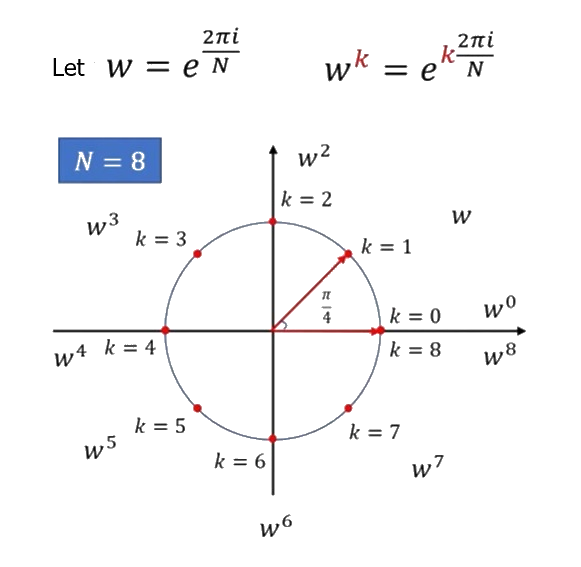
\(f(\frac{2\pi}N)=\cdots+c_{-2}e^{-2\cdot\frac{2\pi i}N}+c_{-1}e^{-1\cdot\frac{2\pi i}N}+c_0e^{0\cdot\frac{2\pi i}N}+c_1e^{1\cdot\frac{2\pi i}N}+c_2e^{2\cdot\frac{2\pi i}N}+\cdots+c_{k-1}e^{(k-1)\cdot\frac{2\pi i}N}+c_ke^{k\cdot\frac{2\pi i}N}+c_{k+1}e^{(k+1)\cdot\frac{2\pi i}N}+\cdots\)
\(=(c_0+c_N+c_{-N}+c_{2N}+c_{-2N}+\cdots){\omega^0}\)
\(+(c_1+c_{N+1}+c_{-N+1}+c_{2N+1}+c_{-2N+1}+\cdots){\omega^1}\)
\(+(c_2+c_{N+2}+c_{-N+2}+c_{2N+2}+c_{-2N+2}+\cdots){\omega^2}\)
\(\dots\)
\(+(c_{N-1}+c_{2N-1}+c_{-1}+c_{3N-1}+c_{-N-1}+\cdots){\omega^{N-1}}\)
\(what\;is\;f(\frac{4\pi}N)?\)
\(f(2\cdot\frac{2\pi}N)=(c_0+c_N+c_{-N}+c_{2N}+c_{-2N}+\cdots){\omega^0}\)
\(+(c_1+c_{N+1}+c_{-N+1}+c_{2N+1}+c_{-2N+1}+\cdots){\omega^2}\)
\(+(c_2+c_{N+2}+c_{-N+2}+c_{2N+2}+c_{-2N+2}+\cdots){\omega^4}\)
\(\dots\)
\(+(c_{N-1}+c_{2N-1}+c_{-1}+c_{3N-1}+c_{-N-1}+\cdots){\omega^{2(N-1)}}\)
\(As\;\omega^N=1,\;for\;any\;k\in\mathcal Z,\;\omega^k\;will\;be\;one\;of\;\omega^0,\omega^1,\cdots,\omega^{N-1}\)
\(f(k\cdot\frac{2\pi}N)\;(k=0,1,\cdots,N-1)\;could\;be\;denoted\;by\;\omega^0,\omega^1,\cdots,\omega^{N-1}\)
If \(f(x)\) fourier series only contain \(c_0,c_1,c_2,\cdots,c_{N-1}\)
\(f(x)=c_0+c_1e^{ix}+c_2e^{i2x}+\cdots+c_{N-1}e^{i(N-1)x}\)
\(f(0\cdot\frac{2\pi}N)=c_0+c_1+c_2+\cdots+c_{N-1}\)
\(f(1\cdot\frac{2\pi}N)=c_0+c_1\omega+c_2\omega^2+\cdots+c_{N-1}\omega^{N-1}\)
\(f(2\cdot\frac{2\pi}N)=c_0+c_1\omega^2+c_2\omega^4+\cdots+c_{N-1}\omega^{2(N-1)}\)
\(f(3\cdot\frac{2\pi}N)=c_0+c_1\omega^3+c_2\omega^6+\cdots+c_{N-1}\omega^{3(N-1)}\)
\(\cdots\)
\(f((N-1)\cdot\frac{2\pi}N)=c_0+c_1\omega^{N-1}+c_2\omega^{2(N-1)}+\cdots+c_{N-1}\omega^{{(N-1)}^2}\)
DFT matrix
\(\overbrace{\underset{\Leftarrow Inverse\;Discrete\;Fourier\;Transform}{\underbrace{\begin{bmatrix}f_0\\f_1\\f_2\\f_3\\\vdots\\f_{N-1}\end{bmatrix}\overset{DFT}{\underset{IDFT}\rightleftarrows}\begin{bmatrix}1&1&1&1&\cdots&1\\1&\omega&\omega^2&\omega^3&\cdots&\omega^{N-1}\\1&\omega^2&\omega^4&\omega^6&\cdots&\omega^{2(N-1)}\\1&\omega^3&\omega^6&\omega^9&\cdots&\omega^{3(N-1)}\\\vdots&\vdots&\vdots&\vdots&\ddots&\vdots\\1&\omega^{N-1}&\omega^{2(N-1)}&\omega^{3(N-1)}&\cdots&\omega^{{(N-1)}^2}\end{bmatrix}\begin{bmatrix}c_0\\c_1\\c_2\\c_3\\\vdots\\c_{N-1}\end{bmatrix}}}}^{\Rightarrow Discrete\;Fourier\;Transform}\)
Fourier Matrix
\(\begin{bmatrix}1&1&1&1&\cdots&1\\1&\omega&\omega^2&\omega^3&\cdots&\omega^{N-1}\\1&\omega^2&\omega^4&\omega^6&\cdots&\omega^{2(N-1)}\\1&\omega^3&\omega^6&\omega^9&\cdots&\omega^{3(N-1)}\\\vdots&\vdots&\vdots&\vdots&\ddots&\vdots\\1&\omega^{N-1}&\omega^{2(N-1)}&\omega^{3(N-1)}&\cdots&\omega^{{(N-1)}^2}\end{bmatrix}\)
[Ex] \(f(x)=1+e^{ix}+e^{i2x}+e^{i3x}\)
N=4
\(f(0)=4,\;f(1\cdot\frac{2\pi}4)=f(2\cdot\frac{2\pi}4)=f(3\cdot\frac{2\pi}4)=0\)
\(\Rightarrow\omega=e^\frac{2\pi i}4=i\)
\(\begin{bmatrix}1&1&1&1\\1&\omega&\omega^2&\omega^3\\1&\omega^2&\omega^4&\omega^6\\1&\omega^3&\omega^6&\omega^9\end{bmatrix}^{-1}\begin{bmatrix}4\\0\\0\\0\end{bmatrix}=\begin{bmatrix}1\\1\\1\\1\end{bmatrix}\)
N=3
\(f(0)=4,\;f(\frac{2\pi}3)=1,\;f(2\cdot\frac{2\pi}3)=1\)
\(\omega=e^\frac{2\pi i}3=-\frac12+\frac{\sqrt3}2i\)
\(\begin{bmatrix}1&1&1\\1&\omega&\omega^2\\1&\omega^2&\omega^4\end{bmatrix}^{-1}\begin{bmatrix}4\\1\\1\end{bmatrix}=\begin{bmatrix}2\\1\\1\end{bmatrix}\)
\(\begin{bmatrix}{\color[rgb]{0.0, 0.0, 1.0}2}\\1\\1\end{bmatrix}\Rightarrow{\color[rgb]{0.0, 0.0, 1.0}2}\;is\;{\color[rgb]{0.0, 0.0, 1.0}1}+e^{ix}+e^{i2x}+{\color[rgb]{0.0, 0.0, 1.0}1}\cdot e^{i3x},\;({\color[rgb]{1.0, 0.0, 0.0}1}\cdot e^{-ix}+{\color[rgb]{1.0, 0.0, 0.0}1}+e^{ix}+e^{i2x})\;\begin{bmatrix}{\color[rgb]{1.0, 0.0, 0.0}1}\\1\\1\\{\color[rgb]{0.68, 0.46, 0.12}1}\end{bmatrix}\)
N=6
\(f(0)=4,\;f(1\cdot\frac{2\pi}6)=\sqrt3i,\;f(2\cdot\frac{2\pi}6)=1\)
\(f(3\cdot\frac{2\pi}6)=0,\;f(4\cdot\frac{2\pi}6)=1,\;f(5\cdot\frac{2\pi}6)=-\sqrt3i\)
\(\omega=e^\frac{2\pi i}6=\frac12+\frac{\sqrt3}2i\)
\(\omega_6^{-1}\begin{bmatrix}4\\\sqrt3i\\1\\0\\1\\-\sqrt3i\end{bmatrix}=\begin{bmatrix}1\\1\\1\\1\\0\\0\end{bmatrix}\)
DFT for Real number function
[Ex] \(f(x)=1+\cos(x)+\cos(2x)\)
\(f(x)=\frac12e^{-i2x}+\frac12e^{-ix}+1+\frac12e^{ix}+\frac12e^{i2x}\)
N=6
\(\omega_6^{-1}\begin{bmatrix}3\\1\\0\\1\\0\\1\end{bmatrix}=\begin{bmatrix}1\\0.5\\0.5\\0\\0.5\\0.5\end{bmatrix}\Rightarrow\begin{bmatrix}{\color[rgb]{0.0, 0.0, 1.0}1}&\frac12e^{-i2x}+\frac12e^{-ix}+\boxed{\color[rgb]{0.0, 0.0, 1.0}1}+\frac12e^{ix}+\frac12e^{i2x}\\{\color[rgb]{1.0, 0.0, 1.0}0}{\color[rgb]{1.0, 0.0, 1.0}.}{\color[rgb]{1.0, 0.0, 1.0}5}&\frac12e^{-i2x}+\frac12e^{-ix}+1+\boxed{{\color[rgb]{1.0, 0.0, 1.0}\frac12}e^{ix}}+\frac12e^{i2x}\\{\color[rgb]{0.9, 0.76, 0.02}0}{\color[rgb]{0.9, 0.76, 0.02}.}{\color[rgb]{0.9, 0.76, 0.02}5}&\frac12e^{-i2x}+\frac12e^{-ix}+1+\frac12e^{ix}+\boxed{{\color[rgb]{0.9, 0.76, 0.02}\frac12}e^{i2x}}\\0&\frac12e^{-i2x}+\frac12e^{-ix}+1+\frac12e^{ix}+\frac12e^{i2x}\\{\color[rgb]{0.0, 0.0, 1.0}0}{\color[rgb]{0.0, 0.0, 1.0}.}{\color[rgb]{0.0, 0.0, 1.0}5}&\boxed{{\color[rgb]{0.0, 0.0, 1.0}\frac12}e^{-i2x}}+\frac12e^{-ix}+1+\frac12e^{ix}+\frac12e^{i2x}\\{\color[rgb]{0.0, 0.0, 0.5}0}{\color[rgb]{0.0, 0.0, 0.5}.}{\color[rgb]{0.0, 0.0, 0.5}5}&\frac12e^{-i2x}+\boxed{{\color[rgb]{0.0, 0.0, 0.5}\frac12}e^{-ix}}+1+\frac12e^{ix}+\frac12e^{i2x}\end{bmatrix}\)
N=4
\(\omega_4^{-1}\begin{bmatrix}3\\0\\1\\0\end{bmatrix}=\begin{bmatrix}1\\0.5\\1\\0.5\end{bmatrix}\Rightarrow\begin{bmatrix}{\color[rgb]{0.0, 0.0, 1.0}1}&\frac12e^{-i2x}+\frac12e^{-ix}+\boxed{\color[rgb]{0.0, 0.0, 1.0}1}+\frac12e^{ix}+\frac12e^{i2x}\\{\color[rgb]{0.9, 0.76, 0.02}0}{\color[rgb]{0.9, 0.76, 0.02}.}{\color[rgb]{0.9, 0.76, 0.02}5}&\frac12e^{-i2x}+\frac12e^{-ix}+1+\boxed{{\color[rgb]{0.9, 0.76, 0.02}\frac12}e^{ix}}+\frac12e^{i2x}\\{\color[rgb]{1.0, 0.0, 1.0}1}&\boxed{{\color[rgb]{1.0, 0.0, 1.0}\frac12}e^{-i2x}}+\frac12e^{-ix}+1+\frac12e^{ix}+\boxed{{\color[rgb]{1.0, 0.0, 1.0}\frac12}e^{i2x}}\\{\color[rgb]{0.0, 0.5, 0.5}0}{\color[rgb]{0.0, 0.5, 0.5}.}{\color[rgb]{0.0, 0.5, 0.5}5}&\frac12e^{-i2x}+\boxed{{\color[rgb]{0.0, 0.5, 0.5}\frac12}e^{-ix}}+1+\frac12e^{ix}+\frac12e^{i2x}\end{bmatrix}\)
N=5
\(\omega_5^{-1}\begin{bmatrix}3\\0.5\\0.5\\0.5\\0.5\end{bmatrix}=\begin{bmatrix}1\\0.5\\0.5\\0.5\\0.5\end{bmatrix}=\begin{bmatrix}1&\frac12e^{-i2x}+\frac12e^{-ix}+\boxed1+\frac12e^{ix}+\frac12e^{i2x}\\0.5&\frac12e^{-i2x}+\frac12e^{-ix}+1+\boxed{\frac12e^{ix}}+\frac12e^{i2x}\\0.5&\frac12e^{-i2x}+\frac12e^{-ix}+1+\frac12e^{ix}+\boxed{\frac12e^{i2x}}\\0.5&\boxed{\frac12e^{-i2x}}+\frac12e^{-ix}+1+\frac12e^{ix}+\frac12e^{i2x}\\0.5&\frac12e^{-i2x}+\boxed{\frac12e^{-ix}}+1+\frac12e^{ix}+\frac12e^{i2x}\end{bmatrix}\)
\(\omega=e^\frac{2\pi i}N\Rightarrow\omega^k=e^{k\cdot\frac{2\pi i}N}\)
Characteristics of DFT
IDFT
\(\begin{bmatrix}f_0\\f_1\\f_2\\f_3\\\vdots\\f_k\\\vdots\\f_{N-1}\end{bmatrix}=\begin{bmatrix}1&1&1&1&\dots&1\\1&\omega&\omega^2&\omega^3&\dots&\omega^{N-1}\\1&\omega^2&\omega^4&\omega^6&\dots&\omega^{2(N-1)}\\1&\omega^3&\omega^6&\omega^9&\dots&\omega^{3(N-1)}\\\vdots&\vdots&\vdots&\vdots&\vdots&\vdots\\1&\omega^k&(\omega^k)^2&(\omega^k)^3&\dots&\omega^{k(N-1)}\\\vdots&\vdots&\vdots&\vdots&\vdots&\vdots\\1&\omega^{N-1}&\omega^{2(N-1)}&\omega^{3(N-1)}&\dots&\omega^{(N-1)(N-1)}\end{bmatrix}\begin{bmatrix}c_0\\c_1\\c_2\\c_3\\\vdots\\c_k\\\vdots\\c_{N-1}\end{bmatrix}\)
\(\omega=e^\frac{2\pi i}N\)
\(F_NF_N^\ast=N\begin{bmatrix}1&0&0\\0&\ddots&0\\0&0&1\end{bmatrix}\Rightarrow F_N^{-1}=\frac1NF_N^\ast\)
DFT
\(\frac1N\begin{bmatrix}1&1&1&1&\dots&1\\1&\overline\omega&\overline\omega^2&\overline\omega^3&\dots&\overline\omega^{N-1}\\1&\overline\omega^2&\overline\omega^4&\overline\omega^6&\dots&\overline\omega^{2(N-1)}\\1&\overline\omega^3&\overline\omega^6&\overline\omega^9&\dots&\overline\omega^{3(N-1)}\\\vdots&\vdots&\vdots&\vdots&\vdots&\vdots\\1&\overline\omega^k&(\overline\omega^k)^2&(\overline\omega^k)^3&\dots&\overline\omega^{k(N-1)}\\\vdots&\vdots&\vdots&\vdots&\vdots&\vdots\\1&\overline\omega^{N-1}&\overline\omega^{2(N-1)}&\overline\omega^{3(N-1)}&\dots&\overline\omega^{(N-1)(N-1)}\end{bmatrix}\begin{bmatrix}f_0\\f_1\\f_2\\f_3\\\vdots\\f_k\\\vdots\\f_{N-1}\end{bmatrix}=\begin{bmatrix}c_0\\c_1\\c_2\\c_3\\\vdots\\c_k\\\vdots\\c_{N-1}\end{bmatrix}\)
\(\overline\omega=e^{-\frac{2\pi i}N}\)
a useful property:
\(\begin{array}{rcl}\omega^0+\omega^1+\dots+\omega^{N-1}&{}={}&\frac{1-\omega^N}{1-\omega}\\&{}={}&\frac{1-1}{1-\omega}\\&{}={}&0\end{array}\)
Now consider the inner product between any two rows other than the first, say row \(p\) and row \(q\)
\(\left\langle row_p\vert row_q\right\rangle=1+(\omega^p)^\ast(\omega^q)+(\omega^{2p})^\ast(\omega^{2q})+\dots+(\omega^{p(N-1)})^\ast(\omega^{q(N-1)})\), Remember left-side conjugation
\(=1+\omega^{-p}\omega^q+\omega^{-2p}\omega^{2q}+\dots+\omega^{-p(N-1)}\omega^{q(N-1)}\), \({(\omega^k)}^\ast=\omega^{-k}\)
\(=1+\omega^{q-p}+(\omega^{q-p})^2+\dots+(\omega^{q-p})^{(N-1)}\), Exponent algebra
\(=\frac{1-(\omega^{q-p})^N}{1-\omega^{q-p}}\), Geometric series
\(=\frac{1-(\omega^N)^{q-p}}{1-\omega^{q-p}}\), Exponent algebra
\(=\frac{1-(1)^{q-p}}{1-\omega^{q-p}}\), \(\omega\) is an \(N_{th}\) root
\(=0\)
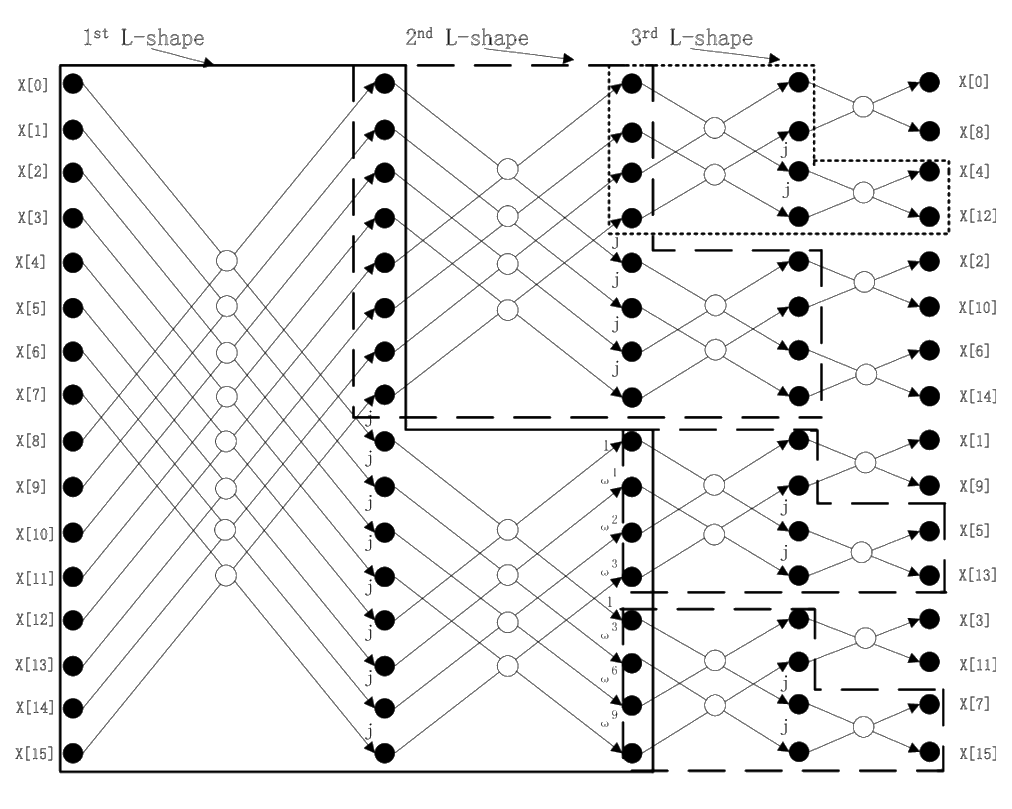
The DFT
\(\widetilde v=Dv\)
\(\begin{bmatrix}{\widetilde a}_0\\{\widetilde a}_1\\{\widetilde a}_2\\\vdots\\{\widetilde a}_{N-1}\end{bmatrix}{}={}\begin{bmatrix}1&1&1&\dots&1\\(\omega)^0&\omega&\omega^2&\dots&\omega^{N-1}\\(\omega^2)^0&\omega^2&\omega^4&\dots&\omega^{2(N-1)}\\(\omega^3)^0&\omega^3&\omega^6&\dots&\omega^{3(N-1)}\\\vdots&\vdots&\vdots&\vdots&\vdots\\(\omega^k)^0&\omega^k&(\omega^k)^2&\dots&\omega^{k(N-1)}\\\vdots&\vdots&\vdots&\vdots&\vdots\\(\omega^{N-1})^0&\omega^{N-1}&\omega^{2(N-1)}&\dots&\omega^{(N-1)(N-1)}\end{bmatrix}{}\begin{bmatrix}a_0\\a_1\\a_2\\\vdots\\a_{N-1}\end{bmatrix}\)
\(v=D^{-1}\widetilde v=\frac1ND^\dagger\widetilde v\)
\(\overline v=D^\dagger v\)
\(D^\dagger=the\;Discreate\;Fourier\;Transform\)
\((D^\dagger)^{-1}=\frac1ND=Inverse\;DFT\)
The unitary DFT
Because \(D^\dagger D = NI \neq I\), , the matrix \(D\) is not unitary.
This is rather simple to fix. Define
\(U_{DFT}=\frac1{\sqrt N}D\)
\(U_{DFT}^\dagger=\frac1{\sqrt N}D^\dagger\)
\(U_{DFT}^\dagger U_{DFT}=\frac1{\sqrt N}D^\dagger\frac1{\sqrt N}D=I\)
[Ex] \(\begin{bmatrix}4\\0\\0\\0\end{bmatrix},\;\omega=e^\frac{2\pi i}4=i,\;f(x)=\left\{\begin{array}{l}f(0\cdot\frac{2\pi}4)=4\\f(1\cdot\frac{2\pi}4)=0\\f(2\cdot\frac{2\pi}4)=0\\f(3\cdot\frac{2\pi}4)=0\end{array}\right.\)
\(f(x)=\sum_{k=-\infty}^\infty c_ke^{ikx}\)
\(f(0\cdot\frac{2\pi}4)\Rightarrow\left\{\begin{array}{l}=(\cdots+c_{-4}+c_0+c_4+\cdots)\omega^0\\+(\cdots+c_{-3}+c_1+c_5+\cdots)\omega^0\\+(\cdots+c_{-2}+c_2+c_6+\cdots)\omega^0\\+(\cdots+c_{-1}+c_3+c_7+\cdots)\omega^0\end{array}\right.\)
\(f(1\cdot\frac{2\pi}4)\Rightarrow\left\{\begin{array}{l}=(\cdots+c_{-4}+c_0+c_4+\cdots)\omega^0\\+(\cdots+c_{-3}+c_1+c_5+\cdots)\omega^1\\+(\cdots+c_{-2}+c_2+c_6+\cdots)\omega^2\\+(\cdots+c_{-1}+c_3+c_7+\cdots)\omega^3\end{array}\right.\)
\(f(2\cdot\frac{2\pi}4)\Rightarrow\left\{\begin{array}{l}=(\cdots+c_{-4}+c_0+c_4+\cdots)\omega^0\\+(\cdots+c_{-3}+c_1+c_5+\cdots)\omega^2\\+(\cdots+c_{-2}+c_2+c_6+\cdots)\omega^4\\+(\cdots+c_{-1}+c_3+c_7+\cdots)\omega^6\end{array}\right.\)
\(f(3\cdot\frac{2\pi}4)\Rightarrow\left\{\begin{array}{l}=(\cdots+c_{-4}+c_0+c_4+\cdots)\omega^0\\+(\cdots+c_{-3}+c_1+c_5+\cdots)\omega^3\\+(\cdots+c_{-2}+c_2+c_6+\cdots)\omega^6\\+(\cdots+c_{-1}+c_3+c_7+\cdots)\omega^9\end{array}\right.\)
\(\begin{bmatrix}f(0\cdot\frac{2\pi}4)\\f(1\cdot\frac{2\pi}4)\\f(2\cdot\frac{2\pi}4)\\f(3\cdot\frac{2\pi}4)\end{bmatrix}=\begin{bmatrix}1&1&1&1\\1&\omega&\omega^2&\omega^3\\1&\omega^2&\omega^4&\omega^6\\1&\omega^3&\omega^6&\omega^9\end{bmatrix}\begin{bmatrix}(\cdots+c_{-4}+c_0+c_4+\cdots)\\(\cdots+c_{-3}+c_1+c_5+\cdots)\\(\cdots+c_{-2}+c_2+c_6+\cdots)\\(\cdots+c_{-1}+c_3+c_7+\cdots)\end{bmatrix}\)
\(f(x)=1+e^{ix}+e^{i2x}+e^{i3x}\)
\(f(x)=1+e^{ix}+e^{i2x}+e^{-ix}\)
\(f(x)=\frac12e^{-ix}+1+e^{ix}+e^{i2x}+\frac12e^{i3x}\)
\(f(x)=1+\frac13e^{ix}+\frac13e^{i5x}+\frac13e^{i9x}+e^{i2x}+e^{i3x}\\f(x)=\frac12e^{-ix}+1+e^{ix}+e^{i2x}+\frac12e^{i3x}\)
\(f(x)=e^{ix}+e^{i2x}+e^{i3x}+e^{i4x}\)
Fourier Series
Expand \(f(x)\) by using the orthogonal set of trigonometric functions
\[f(x)=\frac{a_0}2+\sum_{n=1}^\infty(a_n\cos\frac{n\pi}px+b_n\sin\frac{n\pi}px)\]
Coefficients of each orthogonal function can be determined by inner product from \(-p\) to \(p\).
(i) coef. of \(1\): \(\int_{-p}^pf(x)\cdot1\operatorname dx=\int_{-p}^p\lbrack\frac{a_0}2+\sum_{n=1}^\infty(a_n\underbrace{\cos\frac{n\pi}px}_\cancel{\sin\frac{n\pi}px}+b_n\underbrace{\sin\frac{n\pi}px}_\cancel{-\cos\frac{n\pi}px})\rbrack dx=\frac{a_0}2\int_{-p}^pdx=a_0\cdot p\)
\(\therefore a_0=\frac1p\int_{-p}^pf(x)\operatorname dx\)
\(\Rightarrow c_n={\left.\frac{\left\langle f(x),\phi_n(x)\right\rangle}{\left\langle\phi_n(x),\phi_n(x)\right\rangle}\right|}_{\phi_n=1}=\frac{\int_{-p}^pf(x)\operatorname dx}{\int_{-p}^p1^2\operatorname dx}=\frac{a_0\cdot p}{2p}=\frac{a_0}2\)
(ii) coef. of \(\cos\frac{m\pi}px\): \(\int_{-p}^pf(x)\cdot\cos\frac{m\pi}px\operatorname dx=\int_{-p}^p\lbrack\underbrace{\frac{a_0}2\cdot\cos\frac{m\pi}px}_{=0}+\sum_{n=1}^\infty(a_n\underbrace{\cos\frac{m\pi}px\cdot\cos\frac{n\pi}px}_{\frac12\lbrack\cos\frac{(m+n)\pi}px+\cos\frac{(m-n)\pi}px\rbrack}+b_n\underbrace{\cos\frac{m\pi}px\cdot\sin\frac{n\pi}px}_{\frac12\lbrack\sin\frac{(m+n)\pi}px+\sin\frac{(m-n)\pi}px\rbrack=0})\rbrack dx\)
\(\int_{-p}^p\frac12\lbrack\cos\frac{(m+n)\pi}px+\cos\frac{(m-n)\pi}px\rbrack dx=\left\{\begin{array}{lc}0&m\neq n\\p&m=n\end{array}\right.\)
\(m=n,\;\int_{-p}^p{(\cos\frac{m\pi}px)}^2dx=\int_{-p}^p\frac{1+\cancel{\cos\frac{2m\pi}px}}2dx=p\)
(iiI) coef. of \(\sin\frac{m\pi}px\): \(\int_{-p}^pf(x)\cdot\sin\frac{m\pi}px\operatorname dx=\int_{-p}^p\lbrack\underbrace{\frac{a_0}2\cdot\sin\frac{m\pi}px}_{=0}+\sum_{n=1}^\infty(a_n\underbrace{\cos\frac{m\pi}px\cdot\sin\frac{n\pi}px}_{\frac12\lbrack\sin\frac{(m+n)\pi}px+\sin\frac{(m-n)\pi}px\rbrack=0}+b_n\underbrace{\sin\frac{m\pi}px\cdot\sin\frac{n\pi}px}_{\frac12\lbrack\cos\frac{(m-n)\pi}px-\sin\frac{(m+n)\pi}px\rbrack})\rbrack dx\)
\(\int_{-p}^p\frac12\lbrack\cos\frac{(m-n)\pi}px-\sin\frac{(m+n)\pi}px\rbrack dx=\left\{\begin{array}{l}0,\;m\neq n\\p,\;m=n\end{array}\right.\)
\(m=n,\;\int_{-p}^p{(\sin\frac{m\pi}px)}^2dx=\int_{-p}^p\frac{1-\cancel{\cos\frac{2m\pi}px}}2dx=p\)
\(\Rightarrow\left\{\begin{array}{l}a_n=\frac1p\int_{-p}^pf(x)\cdot\cos\frac{n\pi}px\operatorname dx\\b_n=\frac1p\int_{-p}^pf(x)\cdot\sin\frac{n\pi}px\operatorname dx\end{array}\right.\)
The Fourier series of a function \(f\) defined on the internal \([-p,p]\) is given by
\(f(x)=\frac{a_0}2+\sum_{n=1}^\infty(a_n\cos\frac{n\pi}px+b_n\sin\frac{n\pi}px)\)
where \(\left\{\begin{array}{l}a_0=\frac1p\int_{-p}^pf(x)\operatorname dx\\a_n=\frac1p\int_{-p}^pf(x)\cdot\cos\frac{n\pi}px\operatorname dx\\b_n=\frac1p\int_{-p}^pf(x)\cdot\sin\frac{n\pi}px\operatorname dx\end{array}\right.\)
\(f\): odd function \(\Rightarrow f(-x)=-f(x)\)
\(f\): even function \(\Rightarrow f(-x)=f(x)\)
Fourier cosine and sine series
For an even function \(f\) defined on the interval \([-p,p]\), the Fourier series is the Fourier cosine series:
\(f(x)=\frac{a_0}2+\sum_{n=1}^\infty a_n\cos\frac{n\pi}px\)
where \(\left\{\begin{array}{l}a_0=\frac1p\int_{-p}^pf(x)\operatorname dx\\a_n=\frac2p\int_0^pf(x)\cdot\cos\frac{n\pi}px\operatorname dx\end{array}\right.\)
For an odd function \(f\) defined on the interval \([-p,p]\), the Fourier series is the Fourier sine series:
\(f(x)=\sum_{n=1}^\infty b_n\sin\frac{n\pi}px\)
where \(b_n=\frac2p\int_0^pf(x)\cdot\sin\frac{n\pi}px\operatorname dx\)
Fast Fourier Transform (FFT)
\(\begin{bmatrix}1&1&1&1&\dots&1\\1&\overline\omega&\overline\omega^2&\overline\omega^3&\dots&\overline\omega^{N-1}\\1&\overline\omega^2&\overline\omega^4&\overline\omega^6&\dots&\overline\omega^{2(N-1)}\\1&\overline\omega^3&\overline\omega^6&\overline\omega^9&\dots&\overline\omega^{3(N-1)}\\\vdots&\vdots&\vdots&\vdots&\vdots&\vdots\\1&\overline\omega^k&(\overline\omega^k)^2&(\overline\omega^k)^3&\dots&\overline\omega^{k(N-1)}\\\vdots&\vdots&\vdots&\vdots&\vdots&\vdots\\1&\overline\omega^{N-1}&\overline\omega^{2(N-1)}&\overline\omega^{3(N-1)}&\dots&\overline\omega^{(N-1)(N-1)}\end{bmatrix}\begin{bmatrix}f_0\\f_1\\f_2\\f_3\\\vdots\\f_k\\\vdots\\f_{N-1}\end{bmatrix}\)
\(\begin{bmatrix}{\overline x}_1&{\color[rgb]{0.0, 0.0, 1.0}\overline x}_{\color[rgb]{0.0, 0.0, 1.0}2}&{\overline x}_3&{\color[rgb]{0.9, 0.76, 0.02}\overline x}_{\color[rgb]{0.9, 0.76, 0.02}4}\end{bmatrix}\begin{bmatrix}a_1\\{\color[rgb]{0.0, 0.0, 1.0}a}_{\color[rgb]{0.0, 0.0, 1.0}2}\\a_3\\{\color[rgb]{0.9, 0.76, 0.02}a}_{\color[rgb]{0.9, 0.76, 0.02}4}\end{bmatrix}=a_1{\overline x}_1+{\color[rgb]{0.0, 0.0, 1.0}a}_{\color[rgb]{0.0, 0.0, 1.0}2}{\color[rgb]{0.0, 0.0, 1.0}\overline x}_{\color[rgb]{0.0, 0.0, 1.0}2}+a_3{\overline x}_3+{\color[rgb]{0.9, 0.76, 0.02}a}_{\color[rgb]{0.9, 0.76, 0.02}4}{\color[rgb]{0.9, 0.76, 0.02}\overline x}_{\color[rgb]{0.9, 0.76, 0.02}4}\)
\(\begin{bmatrix}{\overline x}_1&{\color[rgb]{0.9, 0.76, 0.02}\overline x}_{\color[rgb]{0.9, 0.76, 0.02}4}&{\overline x}_3&{\color[rgb]{0.0, 0.0, 1.0}\overline x}_{\color[rgb]{0.0, 0.0, 1.0}2}\end{bmatrix}\begin{bmatrix}a_1\\{\color[rgb]{0.9, 0.76, 0.02}a}_{\color[rgb]{0.9, 0.76, 0.02}4}\\a_3\\{\color[rgb]{0.0, 0.0, 1.0}a}_{\color[rgb]{0.0, 0.0, 1.0}2}\end{bmatrix}=a_1{\overline x}_1+{\color[rgb]{0.9, 0.76, 0.02}a}_{\color[rgb]{0.9, 0.76, 0.02}4}{\color[rgb]{0.9, 0.76, 0.02}\overline x}_{\color[rgb]{0.9, 0.76, 0.02}4}+a_3{\overline x}_3+{\color[rgb]{0.0, 0.0, 1.0}a}_{\color[rgb]{0.0, 0.0, 1.0}2}{\color[rgb]{0.0, 0.0, 1.0}\overline x}_{\color[rgb]{0.0, 0.0, 1.0}2}\)
To swap items of row and column accordingly of matrix multiplication is able to keep the ordinary result.
\(F_4=\begin{bmatrix}1&1&1&1\\1&\overline\omega^1&\overline\omega^2&\overline\omega^3\\1&\overline\omega^2&\overline\omega^4&\overline\omega^6\\1&\overline\omega^3&\overline\omega^6&\overline\omega^9\end{bmatrix}\begin{bmatrix}f_0\\f_1\\f_2\\f_3\end{bmatrix}\)
\(\Rightarrow{\widetilde F}_4=\begin{bmatrix}1&1&1&1\\1&\overline\omega^2&\overline\omega^1&\overline\omega^3\\1&\overline\omega^4&\overline\omega^2&\overline\omega^6\\1&\overline\omega^6&\overline\omega^3&\overline\omega^9\end{bmatrix}\begin{bmatrix}f_0\\f_2\\f_1\\f_3\end{bmatrix}\)
\(\begin{bmatrix}1&1&1&1\\1&\overline\omega^1&\overline\omega^2&\overline\omega^3\\1&\overline\omega^2&\overline\omega^4&\overline\omega^6\\1&\overline\omega^3&\overline\omega^6&\overline\omega^9\end{bmatrix}\Rightarrow\begin{bmatrix}1&1&1&1\\1&\overline\omega^2&\overline\omega^1&\overline\omega^3\\1&\overline\omega^4&\overline\omega^2&\overline\omega^6\\1&\overline\omega^6&\overline\omega^3&\overline\omega^9\end{bmatrix}\)
\(\begin{bmatrix}{\color[rgb]{0.0, 0.0, 1.0}1}&{\color[rgb]{0.0, 0.0, 1.0}1}&{\color[rgb]{0.51, 0.5, 0.0}1}&{\color[rgb]{0.51, 0.5, 0.0}1}\\{\color[rgb]{0.0, 0.0, 1.0}1}&\color[rgb]{0.0, 0.0, 1.0}\overline\omega^2&\color[rgb]{0.51, 0.5, 0.0}\overline\omega^1&\color[rgb]{0.51, 0.5, 0.0}\overline\omega^3\\{\color[rgb]{0.9, 0.76, 0.02}1}&\color[rgb]{0.9, 0.76, 0.02}\overline\omega^4&\color[rgb]{0.7, 0.7, 0.7}\overline\omega^2&\color[rgb]{0.7, 0.7, 0.7}\overline\omega^6\\{\color[rgb]{0.9, 0.76, 0.02}1}&\color[rgb]{0.9, 0.76, 0.02}\overline\omega^6&\color[rgb]{0.7, 0.7, 0.7}\overline\omega^3&\color[rgb]{0.7, 0.7, 0.7}\overline\omega^9\end{bmatrix}\Rightarrow F_2=\begin{bmatrix}{\color[rgb]{0.0, 0.0, 1.0}1}&{\color[rgb]{0.0, 0.0, 1.0}1}\\{\color[rgb]{0.0, 0.0, 1.0}1}&\color[rgb]{0.0, 0.0, 1.0}\overline\omega^2\end{bmatrix},\;F_2=\begin{bmatrix}{\color[rgb]{0.9, 0.76, 0.02}1}&\color[rgb]{0.9, 0.76, 0.02}\overline\omega^4\\{\color[rgb]{0.9, 0.76, 0.02}1}&\color[rgb]{0.9, 0.76, 0.02}\overline\omega^6\end{bmatrix}=\begin{bmatrix}{\color[rgb]{0.0, 0.0, 1.0}1}&{\color[rgb]{0.0, 0.0, 1.0}1}\\{\color[rgb]{0.0, 0.0, 1.0}1}&\color[rgb]{0.0, 0.0, 1.0}\overline\omega^2\end{bmatrix}\)
\(\Rightarrow\begin{bmatrix}{\color[rgb]{0.51, 0.5, 0.0}1}&{\color[rgb]{0.51, 0.5, 0.0}1}\\\color[rgb]{0.51, 0.5, 0.0}\overline\omega^1&\color[rgb]{0.51, 0.5, 0.0}\overline\omega^3\end{bmatrix}=\begin{bmatrix}1&0\\0&\overline\omega\end{bmatrix}F_2,\;\begin{bmatrix}\color[rgb]{0.7, 0.7, 0.7}\overline\omega^2&\color[rgb]{0.7, 0.7, 0.7}\overline\omega^6\\\color[rgb]{0.7, 0.7, 0.7}\overline\omega^3&\color[rgb]{0.7, 0.7, 0.7}\overline\omega^9\end{bmatrix}=\begin{bmatrix}-1&0\\0&-\overline\omega\end{bmatrix}F_2\)
Let \(\begin{bmatrix}1&0\\0&\overline\omega\end{bmatrix}=D_2,\;\begin{bmatrix}-1&0\\0&-\overline\omega\end{bmatrix}=-D_2\)
\({\widetilde F}_4=\begin{bmatrix}F_2&D_2F_2\\F_2&-D_2F_2\end{bmatrix}\)
\(\Rightarrow{\widetilde F}_{2N}=\begin{bmatrix}F_N&D_NF_N\\F_N&-D_NF_N\end{bmatrix}\)
\(D_N=\begin{bmatrix}1&0&\cdots&0\\0&\overline\omega&\ddots&\vdots\\\vdots&\ddots&\ddots&0\\0&\cdots&0&\overline\omega^{N-1}\end{bmatrix}\)
\(\underline X=\begin{bmatrix}f_0\\f_1\\\vdots\\f_{N-1}\end{bmatrix}\)
\(F_N\underline X={\widetilde F}_N\begin{bmatrix}f_0\\f_2\\\vdots\\f_{N-2}\\f_1\\f_3\\\vdots\\f_{N-1}\end{bmatrix}=\begin{bmatrix}F_\frac N2&D_\frac N2F_\frac N2\\F_\frac N2&-D_\frac N2F_\frac N2\end{bmatrix}\begin{bmatrix}f_0\\f_2\\\vdots\\f_{N-2}\\f_1\\f_3\\\vdots\\f_{N-1}\end{bmatrix}\)
\(=\begin{bmatrix}I&D_\frac N2\\I&-D_\frac N2\end{bmatrix}\begin{bmatrix}F_\frac N2&0\\0&F_\frac N2\end{bmatrix}\begin{bmatrix}f_0\\f_2\\\vdots\\f_{N-2}\\f_1\\f_3\\\vdots\\f_{N-1}\end{bmatrix}\)
\(=\begin{bmatrix}I&D_\frac N2\\I&-D_\frac N2\end{bmatrix}\begin{bmatrix}F_\frac N2&0\\0&F_\frac N2\end{bmatrix}\begin{bmatrix}{\underline X}_{even}\\{\underline X}_{odd}\end{bmatrix}\)
\(\Rightarrow F_N\underline X=\begin{bmatrix}I&D_\frac N2\\I&-D_\frac N2\end{bmatrix}\begin{bmatrix}F_\frac N2{\underline X}_{even}\\F_\frac N2{\underline X}_{odd}\end{bmatrix}\)
\(\begin{bmatrix}X(0)\\X(1)\\X(2)\\X(3)\end{bmatrix}=\begin{bmatrix}\omega^0&\omega^0&\omega^0&\omega^0\\\omega^0&\omega^1&\omega^2&\omega^3\\\omega^0&\omega^2&\omega^4&\omega^6\\\omega^0&\omega^3&\omega^6&\omega^9\end{bmatrix}\begin{bmatrix}x(0)\\x(1)\\x(2)\\x(3)\end{bmatrix}\)
\(\begin{bmatrix}\omega^0&\omega^0&\omega^0&\omega^0\\\omega^0&\omega^1&\omega^2&\omega^3\\\omega^0&\omega^2&\omega^4&\omega^6\\\omega^0&\omega^3&\omega^6&\omega^9\end{bmatrix}=\begin{bmatrix}1&1&1&1\\1&\omega^1&\omega^2&\omega^3\\1&\omega^2&1&\omega^2\\1&\omega^3&\omega^2&\omega^1\end{bmatrix}\)
\(\begin{bmatrix}1&1&1&1\\1&\omega^1&\omega^2&\omega^3\\1&\omega^2&1&\omega^2\\1&\omega^3&\omega^2&\omega^1\end{bmatrix}=\begin{bmatrix}1&1&1&1\\1&\omega^2&\omega^1&\omega^3\\1&1&\omega^2&\omega^2\\1&\omega^2&\omega^3&\omega^1\end{bmatrix}\begin{bmatrix}1&0&0&0\\0&0&1&0\\0&1&0&0\\0&0&0&1\end{bmatrix}\;column\;2\;\&\;column\;3\;exchange\)
\(=\begin{bmatrix}{\color[rgb]{0.0, 0.0, 1.0}1}&{\color[rgb]{0.0, 0.0, 1.0}1}&{\color[rgb]{0.51, 0.5, 0.0}1}&{\color[rgb]{0.51, 0.5, 0.0}1}\\{\color[rgb]{0.0, 0.0, 1.0}1}&\color[rgb]{0.0, 0.0, 1.0}\omega^2&\color[rgb]{0.51, 0.5, 0.0}\omega^1&\color[rgb]{0.51, 0.5, 0.0}\omega^3\\{\color[rgb]{0.9, 0.76, 0.02}1}&{\color[rgb]{0.9, 0.76, 0.02}1}&\color[rgb]{1.0, 0.0, 0.0}\omega^2&\color[rgb]{1.0, 0.0, 0.0}\omega^2\\{\color[rgb]{0.9, 0.76, 0.02}1}&\color[rgb]{0.9, 0.76, 0.02}\omega^2&\color[rgb]{1.0, 0.0, 0.0}\omega^3&\color[rgb]{1.0, 0.0, 0.0}\omega^1\end{bmatrix}P_4\)
\(\begin{bmatrix}1&1\\1&\omega^2\end{bmatrix}=\begin{bmatrix}e^{-j\frac\pi2\cdot0\times0}&e^{-j\frac\pi2\cdot0\times1}\\e^{-j\frac\pi2\cdot1\times0}&e^{-j\frac\pi2\cdot1\times1}\end{bmatrix}=\begin{bmatrix}1&1\\1&-1\end{bmatrix}\)
\(M_4=\begin{bmatrix}1&1&1&1\\1&\omega^2&\omega^1&\omega^3\\1&1&\omega^2&\omega^2\\1&\omega^2&\omega^3&\omega^1\end{bmatrix}P_4=\begin{bmatrix}M_2&\begin{bmatrix}1&0\\0&\omega\end{bmatrix}M_2\\M_2&-\begin{bmatrix}1&0\\0&\omega\end{bmatrix}M_2\end{bmatrix}P_4\)
\(=\begin{bmatrix}M_2&D_2M_2\\M_2&-D_2M_2\end{bmatrix}P_4=\begin{bmatrix}I_2&D_2\\I_2&-D_2\end{bmatrix}\begin{bmatrix}M_2&0\\0&M_2\end{bmatrix}P_4\)
\(\Rightarrow\begin{bmatrix}X(0)\\X(1)\\X(2)\\X(3)\end{bmatrix}=\begin{bmatrix}I_2&D_2\\I_2&-D_2\end{bmatrix}\begin{bmatrix}M_2&0\\0&M_2\end{bmatrix}P_4\begin{bmatrix}x(0)\\x(1)\\x(2)\\x(3)\end{bmatrix}\)
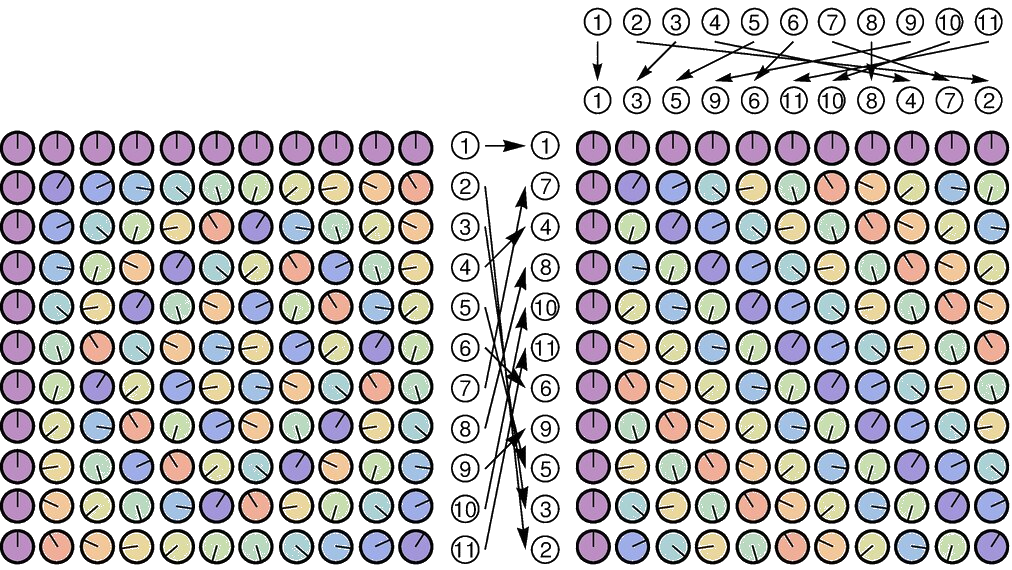
\(\begin{bmatrix}X(0)\\X(1)\\X(2)\\X(3)\\X(4)\\X(5)\\X(6)\\X(7)\end{bmatrix}=\begin{bmatrix}\omega^{0\times0}&\omega^{0\times1}&\omega^{0\times2}&\omega^{0\times3}&\omega^{0\times4}&\omega^{0\times5}&\omega^{0\times6}&\omega^{0\times7}\\\omega^{1\times0}&\omega^{1\times1}&\omega^{1\times2}&\omega^{1\times3}&\omega^{1\times4}&\omega^{1\times5}&\omega^{1\times6}&\omega^{1\times7}\\\omega^{2\times0}&\omega^{2\times1}&\omega^{2\times2}&\omega^{2\times3}&\omega^{2\times4}&\omega^{2\times5}&\omega^{2\times6}&\omega^{2\times7}\\\omega^{3\times0}&\omega^{3\times1}&\omega^{3\times2}&\omega^{3\times3}&\omega^{3\times4}&\omega^{3\times5}&\omega^{3\times6}&\omega^{3\times7}\\\omega^{4\times0}&\omega^{4\times1}&\omega^{4\times2}&\omega^{4\times3}&\omega^{4\times4}&\omega^{4\times5}&\omega^{4\times6}&\omega^{4\times7}\\\omega^{5\times0}&\omega^{5\times1}&\omega^{5\times2}&\omega^{5\times3}&\omega^{5\times4}&\omega^{5\times5}&\omega^{5\times6}&\omega^{5\times7}\\\omega^{6\times0}&\omega^{6\times1}&\omega^{6\times2}&\omega^{6\times3}&\omega^{6\times4}&\omega^{6\times5}&\omega^{6\times6}&\omega^{6\times7}\\\omega^{7\times0}&\omega^{7\times1}&\omega^{7\times2}&\omega^{7\times3}&\omega^{7\times4}&\omega^{7\times5}&\omega^{7\times6}&\omega^{7\times7}\end{bmatrix}\begin{bmatrix}x(0)\\x(1)\\x(2)\\x(3)\\x(4)\\x(5)\\x(6)\\x(7)\end{bmatrix}\)
\(=\begin{bmatrix}1&1&1&1&1&1&1&1\\1&\omega^1&\omega^2&\omega^3&\omega^4&\omega^5&\omega^6&\omega^7\\1&\omega^2&\omega^4&\omega^6&1&\omega^2&\omega^4&\omega^6\\1&\omega^3&\omega^6&\omega^1&\omega^4&\omega^7&\omega^2&\omega^5\\1&\omega^4&1&\omega^4&1&\omega^4&1&\omega^4\\1&\omega^5&\omega^2&\omega^7&\omega^4&\omega^1&\omega^6&\omega^3\\1&\omega^6&\omega^4&\omega^2&1&\omega^6&\omega^4&\omega^2\\1&\omega^7&\omega^6&\omega^5&\omega^4&\omega^3&\omega^2&\omega^1\end{bmatrix}\begin{bmatrix}x(0)\\x(1)\\x(2)\\x(3)\\x(4)\\x(5)\\x(6)\\x(7)\end{bmatrix}\), where \(\omega=e^{-j\frac{2\pi}8}\)
\(=\begin{bmatrix}1&1&1&1&1&1&1&1\\1&\omega^2&\omega^4&\omega^6&\omega^1&\omega^3&\omega^5&\omega^7\\1&\omega^4&1&\omega^4&\omega^2&\omega^6&\omega^2&\omega^6\\1&\omega^6&\omega^4&\omega^2&\omega^3&\omega^1&\omega^7&\omega^5\\1&1&1&1&\omega^4&\omega^4&\omega^4&\omega^4\\1&\omega^2&\omega^4&\omega^6&\omega^5&\omega^7&\omega^1&\omega^3\\1&\omega^4&1&\omega^4&\omega^6&\omega^2&\omega^6&\omega^2\\1&\omega^6&\omega^4&\omega^2&\omega^7&\omega^5&\omega^3&\omega^1\end{bmatrix}\begin{bmatrix}1&0&0&0&0&0&0&0\\0&0&1&0&0&0&0&0\\0&0&0&0&1&0&0&0\\0&0&0&0&0&0&1&0\\0&1&0&0&0&0&0&0\\0&0&0&1&0&0&0&0\\0&0&0&0&0&1&0&0\\0&0&0&0&0&0&0&1\end{bmatrix}\begin{bmatrix}x(0)\\x(1)\\x(2)\\x(3)\\x(4)\\x(5)\\x(6)\\x(7)\end{bmatrix}\)
\(=\begin{bmatrix}{\color[rgb]{0.0, 0.0, 1.0}1}&{\color[rgb]{0.0, 0.0, 1.0}1}&{\color[rgb]{0.0, 0.0, 1.0}1}&{\color[rgb]{0.0, 0.0, 1.0}1}&{\color[rgb]{1.0, 0.0, 0.0}1}&{\color[rgb]{1.0, 0.0, 0.0}1}&{\color[rgb]{1.0, 0.0, 0.0}1}&{\color[rgb]{1.0, 0.0, 0.0}1}\\{\color[rgb]{0.0, 0.0, 1.0}1}&\color[rgb]{0.0, 0.0, 1.0}\omega^2&\color[rgb]{0.0, 0.0, 1.0}\omega^4&\color[rgb]{0.0, 0.0, 1.0}\omega^6&\color[rgb]{1.0, 0.0, 0.0}\omega^1&\color[rgb]{1.0, 0.0, 0.0}\omega^3&\color[rgb]{1.0, 0.0, 0.0}\omega^5&\color[rgb]{1.0, 0.0, 0.0}\omega^7\\{\color[rgb]{0.0, 0.0, 1.0}1}&\color[rgb]{0.0, 0.0, 1.0}\omega^4&{\color[rgb]{0.0, 0.0, 1.0}1}&\color[rgb]{0.0, 0.0, 1.0}\omega^4&\color[rgb]{1.0, 0.0, 0.0}\omega^2&\color[rgb]{1.0, 0.0, 0.0}\omega^6&\color[rgb]{1.0, 0.0, 0.0}\omega^2&\color[rgb]{1.0, 0.0, 0.0}\omega^6\\{\color[rgb]{0.0, 0.0, 1.0}1}&\color[rgb]{0.0, 0.0, 1.0}\omega^6&\color[rgb]{0.0, 0.0, 1.0}\omega^4&\color[rgb]{0.0, 0.0, 1.0}\omega^2&\color[rgb]{1.0, 0.0, 0.0}\omega^3&\color[rgb]{1.0, 0.0, 0.0}\omega^1&\color[rgb]{1.0, 0.0, 0.0}\omega^7&\color[rgb]{1.0, 0.0, 0.0}\omega^5\\{\color[rgb]{0.68, 0.46, 0.12}1}&{\color[rgb]{0.68, 0.46, 0.12}1}&{\color[rgb]{0.68, 0.46, 0.12}1}&{\color[rgb]{0.68, 0.46, 0.12}1}&\color[rgb]{0.0, 0.0, 0.5}\omega^4&\color[rgb]{0.0, 0.0, 0.5}\omega^4&\color[rgb]{0.0, 0.0, 0.5}\omega^4&\color[rgb]{0.0, 0.0, 0.5}\omega^4\\{\color[rgb]{0.68, 0.46, 0.12}1}&\color[rgb]{0.68, 0.46, 0.12}\omega^2&\color[rgb]{0.68, 0.46, 0.12}\omega^4&\color[rgb]{0.68, 0.46, 0.12}\omega^6&\color[rgb]{0.0, 0.0, 0.5}\omega^5&\color[rgb]{0.0, 0.0, 0.5}\omega^7&\color[rgb]{0.0, 0.0, 0.5}\omega^1&\color[rgb]{0.0, 0.0, 0.5}\omega^3\\{\color[rgb]{0.68, 0.46, 0.12}1}&\color[rgb]{0.68, 0.46, 0.12}\omega^4&{\color[rgb]{0.68, 0.46, 0.12}1}&\color[rgb]{0.68, 0.46, 0.12}\omega^4&\color[rgb]{0.0, 0.0, 0.5}\omega^6&\color[rgb]{0.0, 0.0, 0.5}\omega^2&\color[rgb]{0.0, 0.0, 0.5}\omega^6&\color[rgb]{0.0, 0.0, 0.5}\omega^2\\{\color[rgb]{0.68, 0.46, 0.12}1}&\color[rgb]{0.68, 0.46, 0.12}\omega^6&\color[rgb]{0.68, 0.46, 0.12}\omega^4&\color[rgb]{0.68, 0.46, 0.12}\omega^2&\color[rgb]{0.0, 0.0, 0.5}\omega^7&\color[rgb]{0.0, 0.0, 0.5}\omega^5&\color[rgb]{0.0, 0.0, 0.5}\omega^3&\color[rgb]{0.0, 0.0, 0.5}\omega^1\end{bmatrix}P_8\begin{bmatrix}x(0)\\x(1)\\x(2)\\x(3)\\x(4)\\x(5)\\x(6)\\x(7)\end{bmatrix}\)
\(M_8=\begin{bmatrix}1&1&1&1&1&1&1&1\\1&\omega^2&\omega^4&\omega^6&\omega^1&\omega^3&\omega^5&\omega^7\\1&\omega^4&1&\omega^4&\omega^2&\omega^6&\omega^2&\omega^6\\1&\omega^6&\omega^4&\omega^2&\omega^3&\omega^1&\omega^7&\omega^5\\1&1&1&1&\omega^4&\omega^4&\omega^4&\omega^4\\1&\omega^2&\omega^4&\omega^6&\omega^5&\omega^7&\omega^1&\omega^3\\1&\omega^4&1&\omega^4&\omega^6&\omega^2&\omega^6&\omega^2\\1&\omega^6&\omega^4&\omega^2&\omega^7&\omega^5&\omega^3&\omega^1\end{bmatrix}P_8\)
\(=\begin{bmatrix}M_4&\begin{bmatrix}1&0&0&0\\0&\omega^1&0&0\\0&0&\omega^2&0\\0&0&0&\omega^3\end{bmatrix}M_4\\M_4&-\begin{bmatrix}1&0&0&0\\0&\omega^1&0&0\\0&0&\omega^2&0\\0&0&0&\omega^3\end{bmatrix}M_4\end{bmatrix}P_8=\begin{bmatrix}M_4&D_4M_4\\M_4&-D_4M_4\end{bmatrix}P_8\)
\(M_8=\begin{bmatrix}M_4&D_4M_4\\M_4&-D_4M_4\end{bmatrix}P_8=\begin{bmatrix}\begin{bmatrix}M_2&D_2M_2\\M_2&-D_2M_2\end{bmatrix}P_4&D_4\begin{bmatrix}M_2&D_2M_2\\M_2&-D_2M_2\end{bmatrix}P_4\\\begin{bmatrix}M_2&D_2M_2\\M_2&-D_2M_2\end{bmatrix}P_4&-D_4\begin{bmatrix}M_2&D_2M_2\\M_2&-D_2M_2\end{bmatrix}P_4\end{bmatrix}P_8\)
\(=\begin{bmatrix}\begin{bmatrix}M_2&D_2M_2\\M_2&-D_2M_2\end{bmatrix}&D_4\begin{bmatrix}M_2&D_2M_2\\M_2&-D_2M_2\end{bmatrix}\\\begin{bmatrix}M_2&D_2M_2\\M_2&-D_2M_2\end{bmatrix}&-D_4\begin{bmatrix}M_2&D_2M_2\\M_2&-D_2M_2\end{bmatrix}\end{bmatrix}\begin{bmatrix}P_4&0\\0&P_4\end{bmatrix}P_8\)
\(=\begin{bmatrix}I_4&D_4\\I_4&-D_4\end{bmatrix}\begin{bmatrix}I_2&D_2&0_{2,2}&0_{2,2}\\I_2&-D_2&0_{2,2}&0_{2,2}\\0_{2,2}&0_{2,2}&I_2&D_2\\0_{2,2}&0_{2,2}&I_2&-D_2\end{bmatrix}\begin{bmatrix}M_2&0_{2,2}&0_{2,2}&0_{2,2}\\0_{2,2}&M_2&0_{2,2}&0_{2,2}\\0_{2,2}&0_{2,2}&M_2&0_{2,2}\\0_{2,2}&0_{2,2}&0_{2,2}&M_2\end{bmatrix}\begin{bmatrix}P_4&0_{4,4}\\0_{4,4}&P_4\end{bmatrix}P_8\)
\(P_8\begin{bmatrix}x\lbrack0\rbrack\\x\lbrack1\rbrack\\x\lbrack2\rbrack\\x\lbrack3\rbrack\\x\lbrack4\rbrack\\x\lbrack5\rbrack\\x\lbrack6\rbrack\\x\lbrack7\rbrack\end{bmatrix}=\begin{bmatrix}1&0&0&0&0&0&0&0\\0&0&1&0&0&0&0&0\\0&0&0&0&1&0&0&0\\0&0&0&0&0&0&1&0\\0&1&0&0&0&0&0&0\\0&0&0&1&0&0&0&0\\0&0&0&0&0&1&0&0\\0&0&0&0&0&0&0&1\end{bmatrix}\begin{bmatrix}x\lbrack0\rbrack\\x\lbrack1\rbrack\\x\lbrack2\rbrack\\x\lbrack3\rbrack\\x\lbrack4\rbrack\\x\lbrack5\rbrack\\x\lbrack6\rbrack\\x\lbrack7\rbrack\end{bmatrix}=\begin{bmatrix}x\lbrack0\rbrack\\x\lbrack2\rbrack\\x\lbrack4\rbrack\\x\lbrack6\rbrack\\x\lbrack1\rbrack\\x\lbrack3\rbrack\\x\lbrack5\rbrack\\x\lbrack7\rbrack\end{bmatrix}\)
\(\begin{bmatrix}P_4&0_{4,4}\\0_{4,4}&P_4\end{bmatrix}\begin{bmatrix}x\lbrack0\rbrack\\x\lbrack2\rbrack\\x\lbrack4\rbrack\\x\lbrack6\rbrack\\x\lbrack1\rbrack\\x\lbrack3\rbrack\\x\lbrack5\rbrack\\x\lbrack7\rbrack\end{bmatrix}=\begin{bmatrix}1&0&0&0&0&0&0&0\\0&0&1&0&0&0&0&0\\0&1&0&0&0&0&0&0\\0&0&0&1&0&0&0&0\\0&0&0&0&1&0&0&0\\0&0&0&0&0&0&1&0\\0&0&0&0&0&1&0&0\\0&0&0&0&0&0&0&1\end{bmatrix}\begin{bmatrix}x\lbrack0\rbrack\\x\lbrack2\rbrack\\x\lbrack4\rbrack\\x\lbrack6\rbrack\\x\lbrack1\rbrack\\x\lbrack3\rbrack\\x\lbrack5\rbrack\\x\lbrack7\rbrack\end{bmatrix}=\begin{bmatrix}x\lbrack0\rbrack\\x\lbrack4\rbrack\\x\lbrack2\rbrack\\x\lbrack6\rbrack\\x\lbrack1\rbrack\\x\lbrack5\rbrack\\x\lbrack3\rbrack\\x\lbrack7\rbrack\end{bmatrix}\)
\(\begin{bmatrix}X\lbrack0\rbrack\\X\lbrack1\rbrack\\X\lbrack2\rbrack\\X\lbrack3\rbrack\\X\lbrack4\rbrack\\X\lbrack5\rbrack\\X\lbrack6\rbrack\\X\lbrack7\rbrack\end{bmatrix}=\begin{bmatrix}I_4&D_4\\I_4&-D_4\end{bmatrix}\begin{bmatrix}I_2&D_2&0_{2,2}&0_{2,2}\\I_2&-D_2&0_{2,2}&0_{2,2}\\0_{2,2}&0_{2,2}&I_2&D_2\\0_{2,2}&0_{2,2}&I_2&-D_2\end{bmatrix}\begin{bmatrix}M_2&0_{2,2}&0_{2,2}&0_{2,2}\\0_{2,2}&M_2&0_{2,2}&0_{2,2}\\0_{2,2}&0_{2,2}&M_2&0_{2,2}\\0_{2,2}&0_{2,2}&0_{2,2}&M_2\end{bmatrix}\begin{bmatrix}x\lbrack0\rbrack\\x\lbrack1\rbrack\\x\lbrack2\rbrack\\x\lbrack3\rbrack\\x\lbrack4\rbrack\\x\lbrack5\rbrack\\x\lbrack6\rbrack\\x\lbrack7\rbrack\end{bmatrix}\)
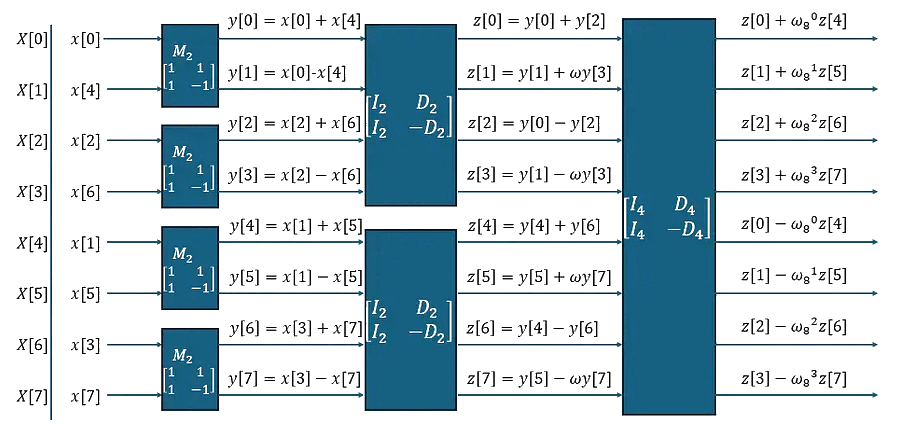
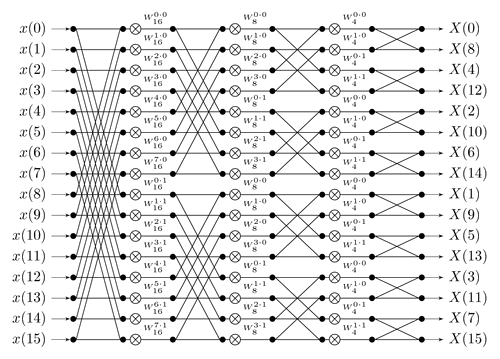
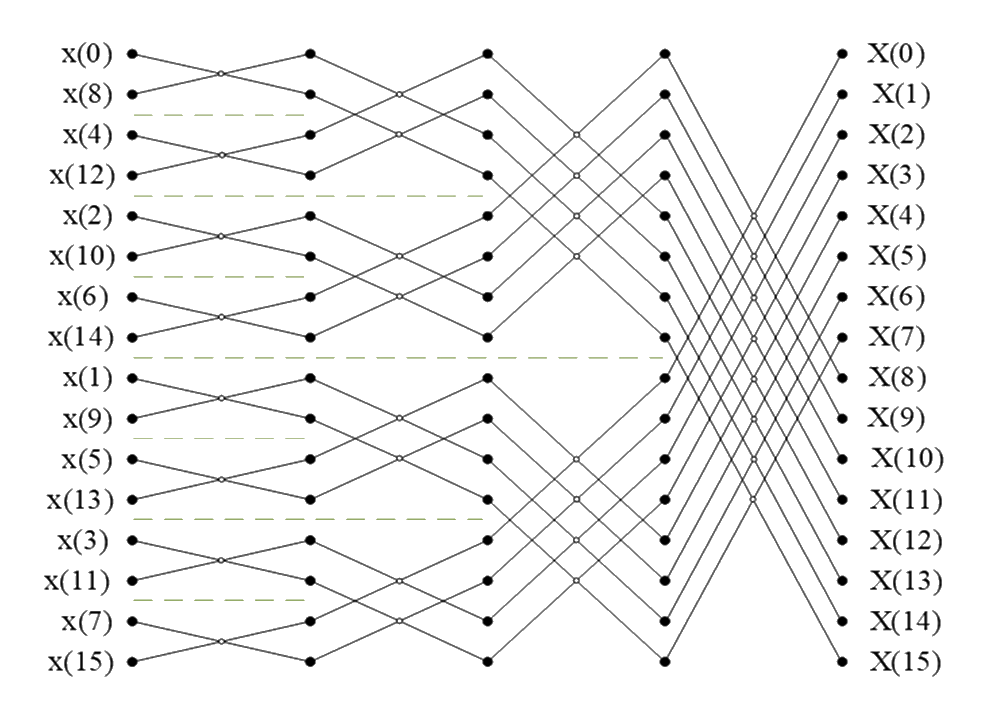
FFT complexity
\(X_n=\sum_{k=0}^{\frac N2-1}x_{2n}⋅e^{\frac{-i⋅2\pi⋅k⋅n}{N/2}}+e^{\frac{-i⋅2\pi⋅n}N}\sum_{k=0}^{\frac N2-1}x_{2n+1}⋅e^{\frac{-i⋅2\pi⋅k⋅n}{N/2}}\)
\({\frac n{n_1}}O(n_1\log\;n_1)+\cdots+{\frac n{n_d}}O(n_d\log\;n_d)\)
\(=O{(n{\lbrack\log\;n_1+\cdots+\log\;n_d\rbrack})}=O(n\log\;n)\)
taking FFTs -- \(O(N \log N)\)
multiplying FFTs -- \(O(N)\)
inverse FFTs -- \(O(N \log N)\).
the total complexity is \(O(N \log N)\).
